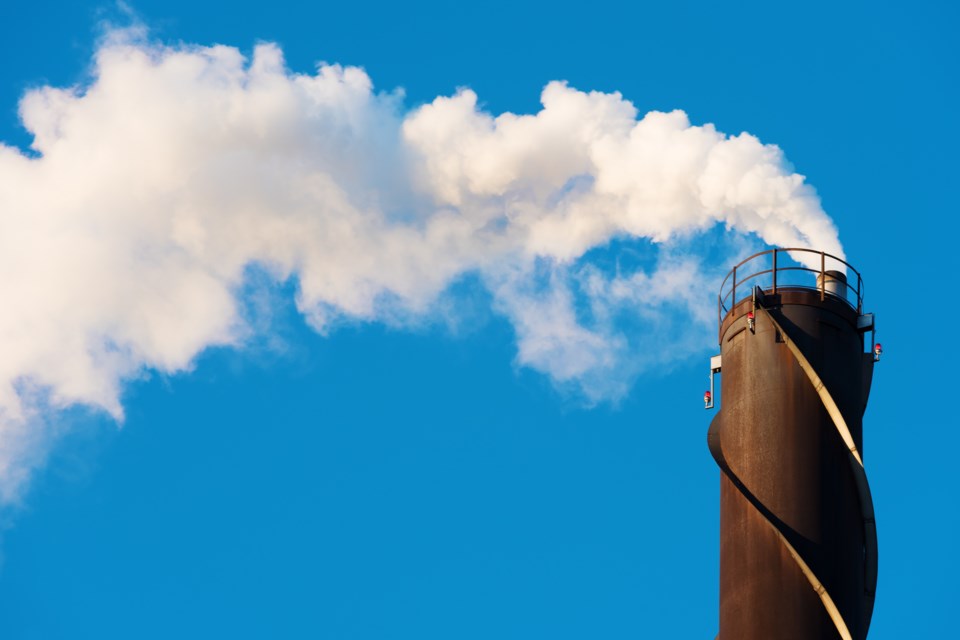ExxonMobil, the fifth-leading producer of greenhouse gas emissions in the world from 1880 to 2010, has been planning since 2018 to raise its yearly carbon dioxide emissions by as much as 17% by 2025, according to internal documents reviewed by Bloomberg. The news comes in stark contrast to efforts to slow down the pace of global warning—and amid several of ExxonMobil's competitors, including BP Plc and Royal Dutch Shell Plc, announcing plans to reach net-zero emissions.
Despite the onus put on consumers to reduce their carbon footprints, just 90 companies around the world have been responsible for nearly two-thirds of greenhouse gas (GHG) emissions from 1880 to 2010, according to a 2017 Climate Change study by Brenda Ekwurzel of the Climate & Energy Program at the Union of Concerned Scientists and a team of researchers.
In its study, the research team wrote that "the emissions traced to these 90 carbon producers contributed ∼57% of the observed rise in atmospheric CO2, ∼42–50% of the rise in global mean surface temperature (GMST), and ∼26–32% of global sea level (GSL) rise over the historical period, and ∼43% atmospheric CO2, ∼29–35% GMST, and ∼11–14% GSL since 1980." Stacker analyzed the study to rank the largest emitters by their atmospheric carbon dioxide contributions from 1880 to 2010. All values included in this story are taken from estimates using the "best," or middle scenario, the model described in Millar et al. 2016. Each slide also summarizes the best practices employed by the company and the country to reduce emissions and move toward a sustainable future.
Coal, oil, and natural gas are produced by 83 of these companies. The remaining are cement and building material manufacturing companies. Unsurprisingly, the companies most responsible for climate change included Saudi Aramco, Chevron, ExxonMobil, BP, Gazprom, and National Iranian Oil Company—companies spread across the Middle East, Europe, Russia, and the United States. The top emitter was China's state-owned coal and cement production company.
Half of these emissions were produced in the past 25 years, when globally, the awareness of climate change, GHGs, global warming, and rising sea levels has increased. During this period, while some noted oil giants and household names chose climate change denial and funded organizations that questioned climate scientists, others transitioned from being called an oil or coal producer to an "energy" company, projecting a cleaner profile.
Under the Paris Climate Agreement of 2015, 196 countries committed to taking steps to limit the rise in global temperature this century to well below 2 degrees Celsius. Four years later, global emissions still increased: by 1.7% in 2017, and a further 2.7% in 2018. In 2019, emissions declined in the United States and European Union but rose in India and China with an overall 0.6% rise worldwide.
The Intergovernmental Panel on Climate Change, the U.N.'s climate-science body, said in its 2018 Climate Change Land Report that to keep temperatures from rising, nations needed to halve their GHG emissions by 2030 and aim for net-zero emissions by 2050. According to Climate Action Tracker, which covers data and tracks about 80% of the global population emissions, the countries on track to meet their self-set goals are Gambia, Morocco, and India. Those seen as barely trying are Saudi Arabia, the United States, and Russia. Keep reading to discover the 90 companies responsible for two-thirds of greenhouse gas emissions.
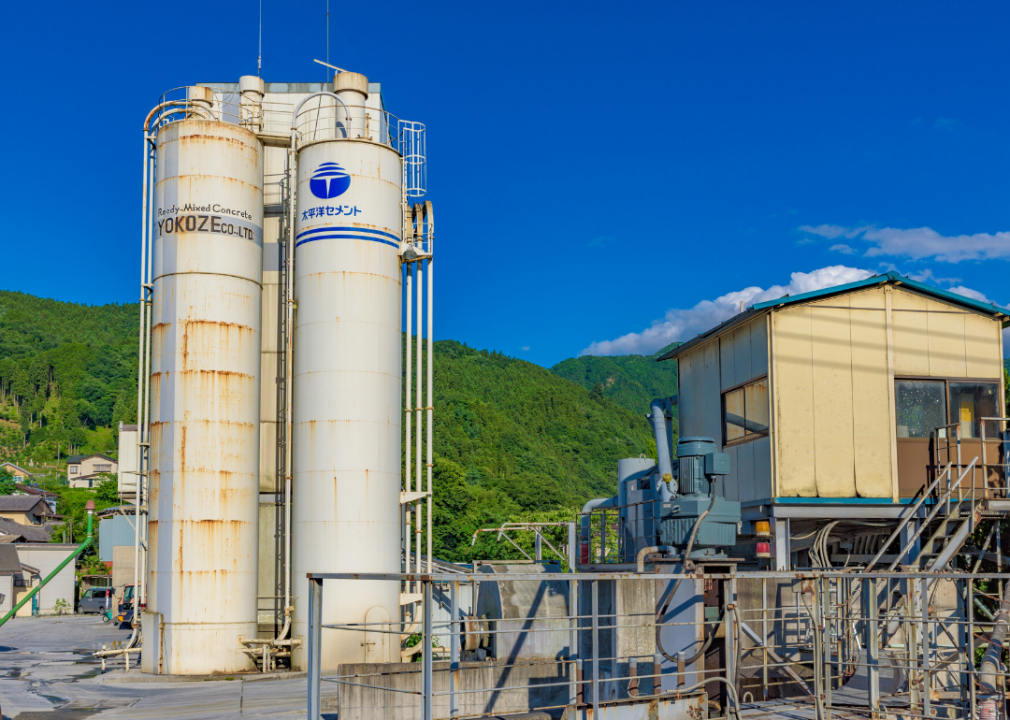
Takashi Images // Shutterstock
#89. Taiheiyo, Japan (tie)
- Contribution to atmospheric carbon dioxide rise, 1880–2010: 0.028 ppm (0.03% of total emissions)
- Contribution to global mean surface temperature rise: 0.0002 C (0.02% of total rise, #84 highest contributor)
- Contribution to global sea level rise: 0.02 mm (0.01% of total rise, #73 highest contributor)
Taiheiyo Cement Corporation is a building material company in Japan with operations in the United States, China, and Vietnam, that has 30 cement plants worldwide and also runs limestone mines. According to the company's website, most of its GHG emissions are due to cement production. It has set a mitigation target of 2025, by which time it plans to reduce CO2 emissions at individual cement plants by reducing the use of fossil fuels and relying on biomass and waste-derived fuels.

Agatha Kadar // Shutterstock
#89. OMV Group, Austria (tie)
- Contribution to atmospheric carbon dioxide rise, 1880–2010: 0.028 ppm (0.03% of total emissions)
- Contribution to global mean surface temperature rise: 0.0001 C (0.02% of total rise, #90 highest contributor)
- Contribution to global sea level rise: 0.003 mm (0% of total rise, #90 highest contributor)
Headquartered in Vienna, Austrian Mineral Oil Administration (OMV) is one of the largest industrial oil and gas companies in Austria, with 24,000 employees in 30 countries. The company defined its first Carbon Strategy in 2008, and between 2008 and 2015 it achieved 956,000 metric tons of GHG emissions savings. Targeting 2025, the company has set strategic objectives, including reducing carbon intensity, establishing a zero routine flaring and venting policy, and maintaining transparency with its investors regarding the company's carbon performance.
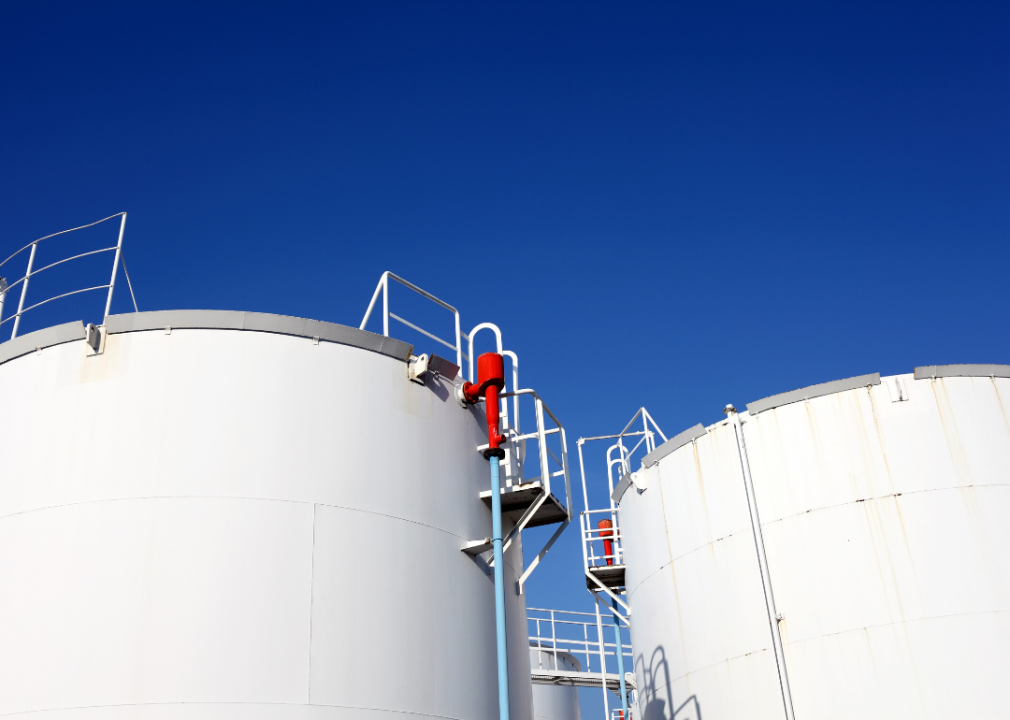
akiyoko // Shutterstock
#88. Murphy Oil, United States
- Contribution to atmospheric carbon dioxide rise, 1880–2010: 0.03 ppm (0.03% of total emissions)
- Contribution to global mean surface temperature rise: 0.0002 C (0.02% of total rise, #84 highest contributor)
- Contribution to global sea level rise: 0.01 mm (0.01% of total rise, #83 highest contributor)
Murphy Oil Corporation, headquartered in El Dorado, Ark., produces oil and natural gas in the United States and Canada and conducts independent exploration activities in Brazil, Australia, Mexico, the Gulf of Mexico, and Southeast Asia. Murphy has established an internal interdisciplinary Climate Change Work Group, providing a guideline for the business units of the company to focus on air emission topics and minimize environmental impacts. In its 2019 sustainability report, the company says its policies and reforms have helped drive continued reductions in GHG emissions and intensities.
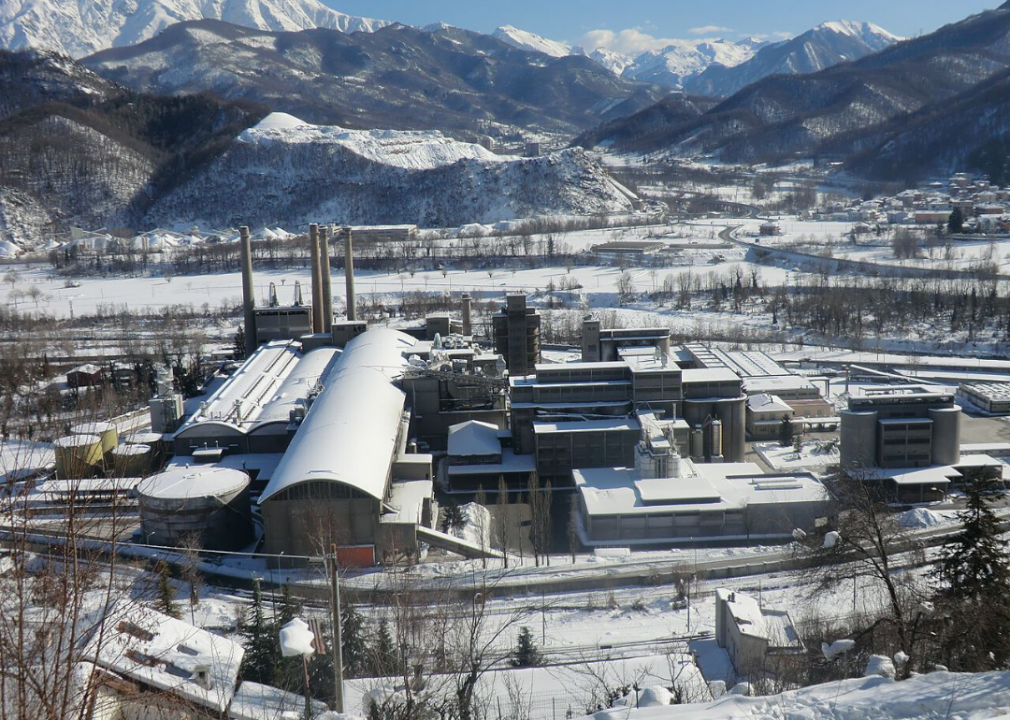
Luigi.tuby // Wikimedia Commons
#87. Italcementi
- Contribution to atmospheric carbon dioxide rise, 1880–2010: 0.037 ppm (0.04% of total emissions)
- Contribution to global mean surface temperature rise: 0.0002 C (0.02% of total rise, #84 highest contributor)
- Contribution to global sea level rise: 0.01 mm (0.01% of total rise, #83 highest contributor)
This Italian multinational company produced cement, ready-mix concrete and construction aggregates. In 2015, HeidelbergCement acquired the company, becoming the world's second-largest cement producer with approximately 57,000 employees working at more than 3,000 of its production sites in over 50 countries on five continents. In 2016, the U.N. acknowledged the increasing climate action initiatives taken by this cement giant. Italcementi created a cement with active ingredients that capture pollution in the air and convert it into inert salts, reducing damage because of smog.
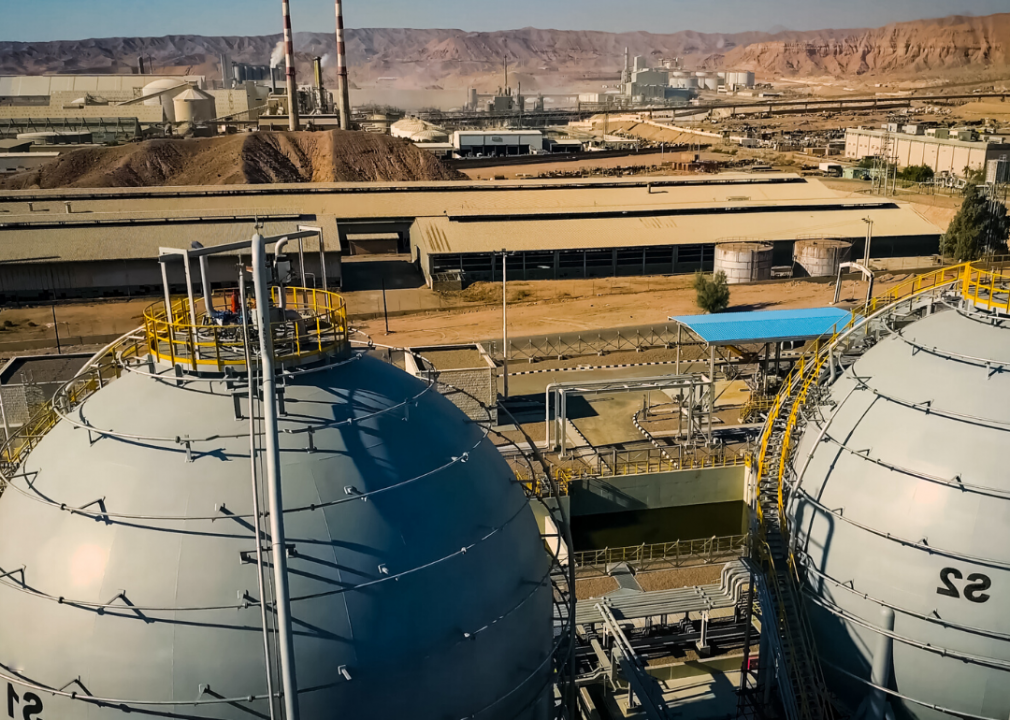
hlopex // Shutterstock
#86. Polish Oil & Gas Co., Poland
- Contribution to atmospheric carbon dioxide rise, 1880–2010: 0.041 ppm (0.04% of total emissions)
- Contribution to global mean surface temperature rise: 0.0002 C (0.03% of total rise, #84 highest contributor)
- Contribution to global sea level rise: 0.005 mm (0% of total rise, #89 highest contributor)
Polish Oil and Gas Company (PGNiG) is involved in the exploration and production of natural gas and crude oil. The Warsaw-based company is also active in import, storage, sales, and distribution of gas and liquid fuels, and in heat and electricity generation. The company was the official partner of the U.N. COP24 Climate Summit where it pushed for the greater use of natural gas as a source of electricity and heat, and as a low-emission fuel for sustainable development. The company also announced plans to invest 7.5 million zlotys by 2022 in infrastructure to create gas power grids, and at the same time, it is investing in PGG, Poland's largest coal producer and CO2 emitter.
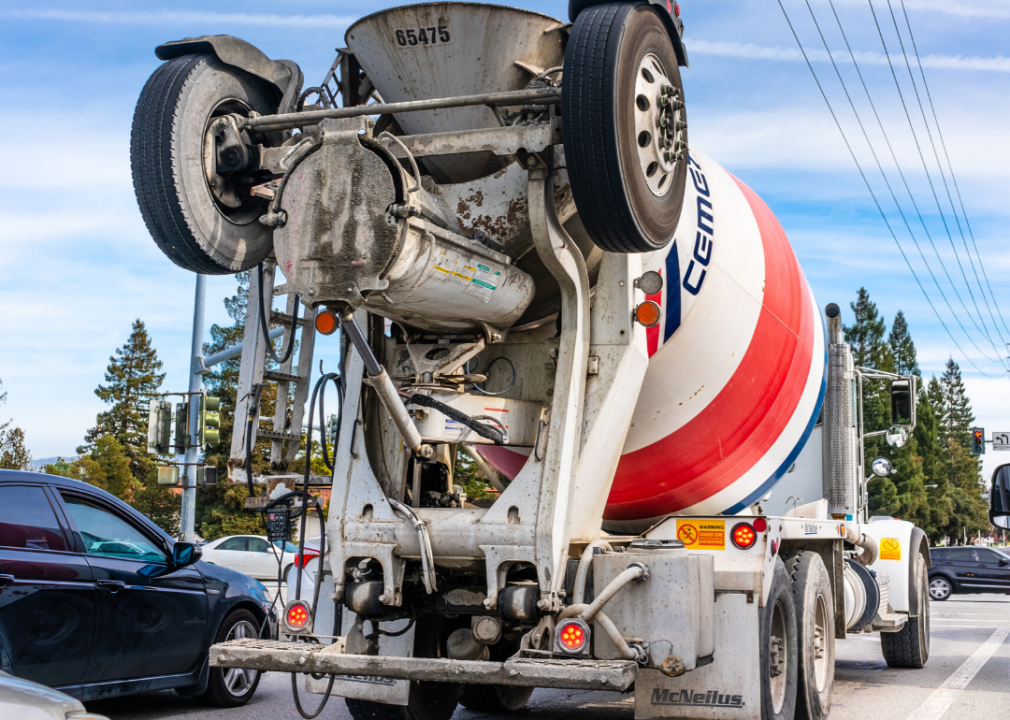
Sundry Photography // Shutterstock
#85. Cemex, Mexico
- Contribution to atmospheric carbon dioxide rise, 1880–2010: 0.044 ppm (0.04% of total emissions)
- Contribution to global mean surface temperature rise: 0.0002 C (0.03% of total rise, #84 highest contributor)
- Contribution to global sea level rise: 0.01 mm (0.01% of total rise, #83 highest contributor)
Cemex, headquartered in San Pedro, Mexico is a multinational manufacturer of cement, ready-mix concrete and other building materials. In its position statement on climate change, the company's support of international agreements like the Paris Accord and the Kyoto Protocol is clear, and it is also encouraging low-carbon technology partnership initiatives. Approximately 80–90% of its CO2 footprint originates from the in-use phase where clinker is produced to make cement, but the company is trying to reduce that footprint through the use of alternative fuels, clinker substitutes, carbon capture and storage, and a greater commitment to clean power.
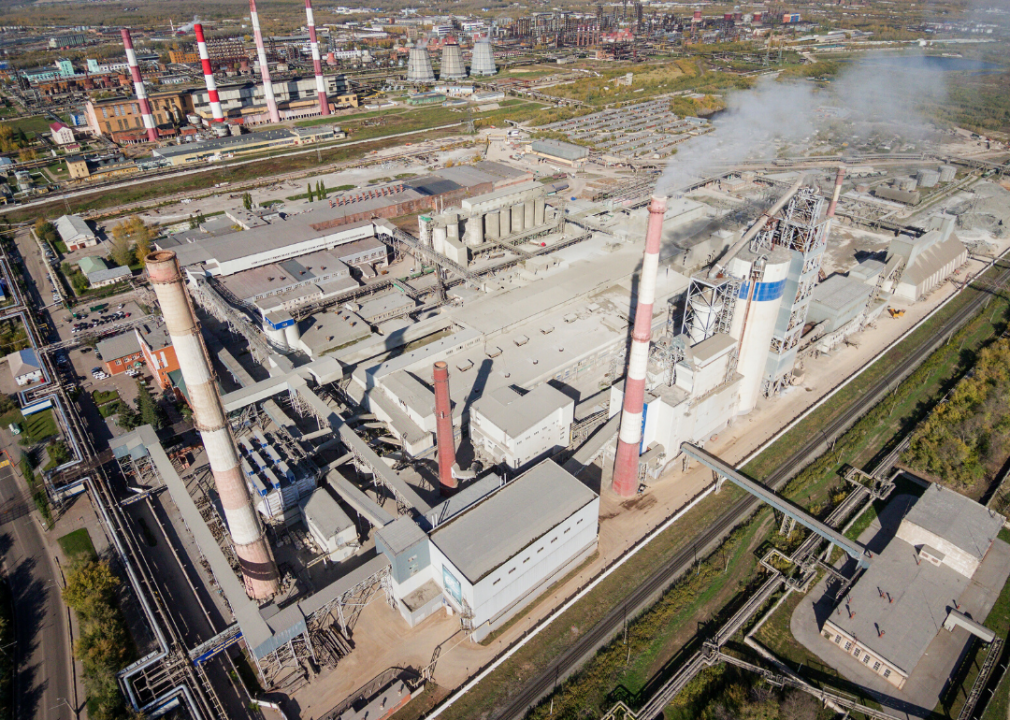
Eugene R // Shutterstock
#84. HeidelbergCement, Germany
- Contribution to atmospheric carbon dioxide rise, 1880–2010: 0.046 ppm (0.05% of total emissions)
- Contribution to global mean surface temperature rise: 0.0002 C (0.03% of total rise, #84 highest contributor)
- Contribution to global sea level rise: 0.01 mm (0.01% of total rise, #83 highest contributor)
The company was founded in 1873 in Germany and has grown into one of the largest building material companies in the world with operations on five continents, and the expanse of the business also makes it one of the biggest contributors to GHG emissions. Climate protection is at the core of the company's environmental policy. According to its website, the company reduced its specific net CO2 emissions by 20% per metric ton of cement from 1990 to 2018, and for 2030 it wants to continue to reduce the emissions by 30% compared to the 1990 level through the use of energy-efficient technologies, promotion of composite cement, and increased use of alternative fuels such as biomass.
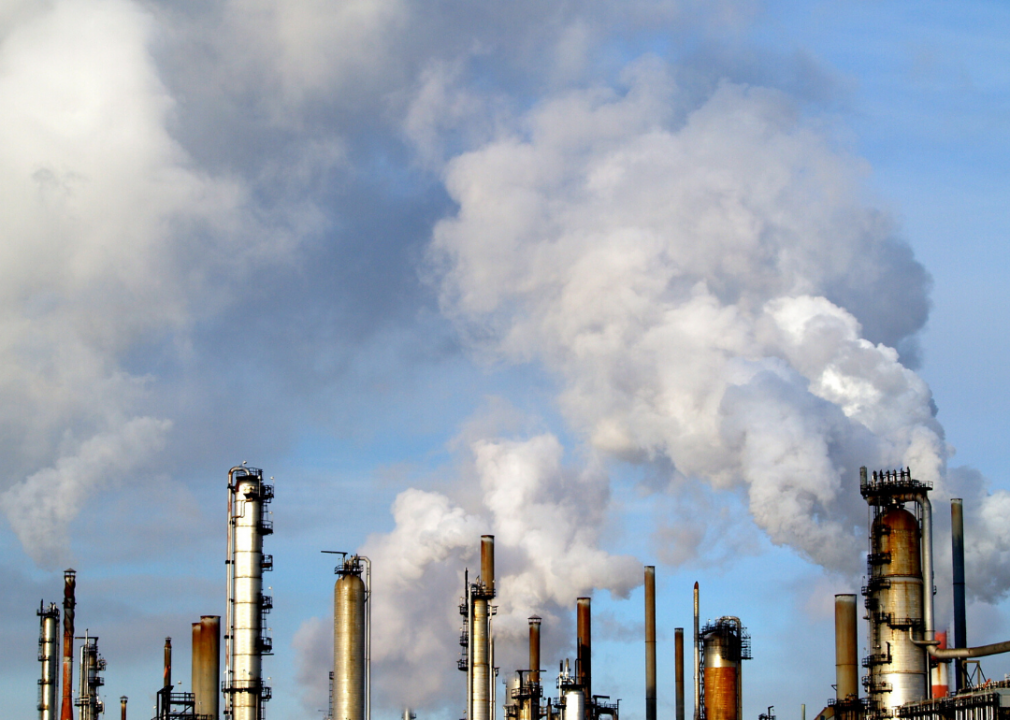
Bruce Raynor // Shutterstock
#83. Nexen, Canada
- Contribution to atmospheric carbon dioxide rise, 1880–2010: 0.049 ppm (0.05% of total emissions)
- Contribution to global mean surface temperature rise: 0.0003 C (0.04% of total rise, #82 highest contributor)
- Contribution to global sea level rise: 0.02 mm (0.01% of total rise, #73 highest contributor)
Oil giant China National Offshore Oil Corporation Ltd. (CNOOC) purchased the Calgary-based oil and petroleum company Nexen Inc. in 2012, and it continued to operate with the same name until December 2018.
In July 2018, Nexen was asked to pay a $290,000 fine by Environment and Climate Change Canada following a 2015 pipeline spill at its Long Lake facility, endangering migratory birds. As its climate change action plan, CNOOC (Nexen) plans to use new technologies that are more energy-efficient and incorporate alternative fuel sources to reduce the company's carbon footprint.

JHVEPhoto // Shutterstock
#82. Husky, Canada
- Contribution to atmospheric carbon dioxide rise, 1880–2010: 0.051 ppm (0.05% of total emissions)
- Contribution to global mean surface temperature rise: 0.0003 C (0.04% of total rise, #82 highest contributor)
- Contribution to global sea level rise: 0.01 mm (0.01% of total rise, #83 highest contributor)
Husky Energy is an integrated energy company based in Alberta, Canada, and operates in Western and Atlantic Canada, the United States, and the Asia-Pacific region. Given the fact that oil and gas generation produces huge amounts of GHG emissions, the company has created air quality and carbon management programs. According to its website, the company reduced its energy use slightly in 2018 as compared to 2017 due to methodology changes, and also reduced its GHG emissions because of the reduction in conventional oil production.
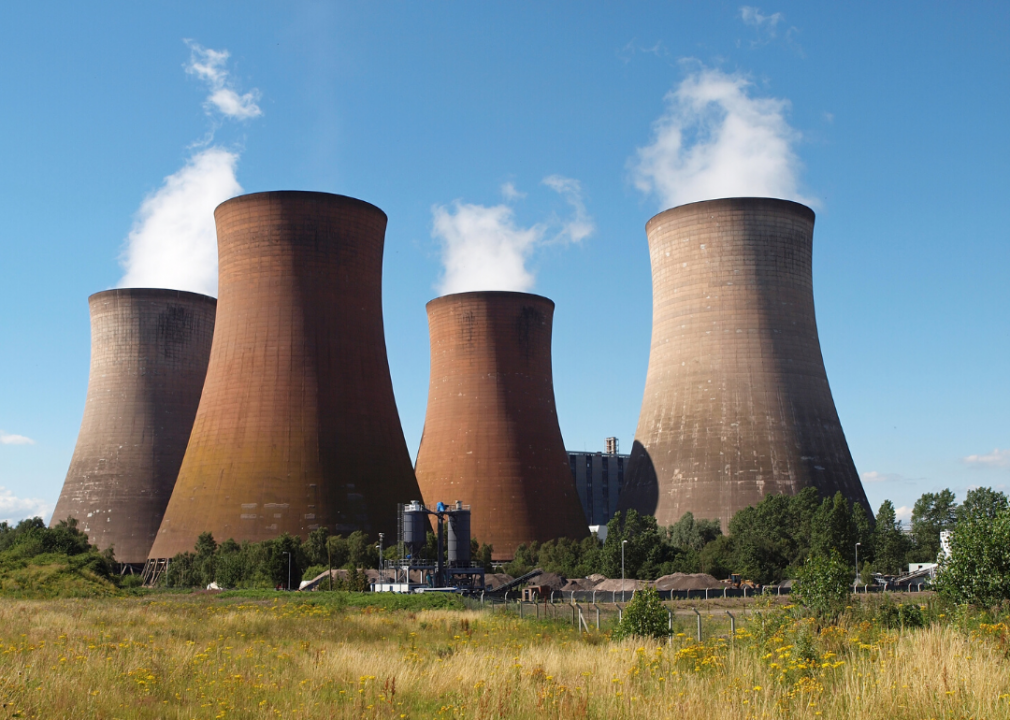
Sponner // Shutterstock
#81. UK Coal, United Kingdom
- Contribution to atmospheric carbon dioxide rise, 1880–2010: 0.057 ppm (0.06% of total emissions)
- Contribution to global mean surface temperature rise: 0.0004 C (0.05% of total rise, #75 highest contributor)
- Contribution to global sea level rise: 0.02 mm (0.01% of total rise, #73 highest contributor)
UK Coal was at one time the largest coal mining business in the United Kingdom, but the company is no longer operational and active in coal mining due to restructuring since 2012. The closure also was partly due to the U.K. government's decision in 2015 to stamp out coal power entirely within a decade. Coal and oil power plants accounted for 86% of the nation's power supply in 1971, and by 2018 it had declined to just 5%.
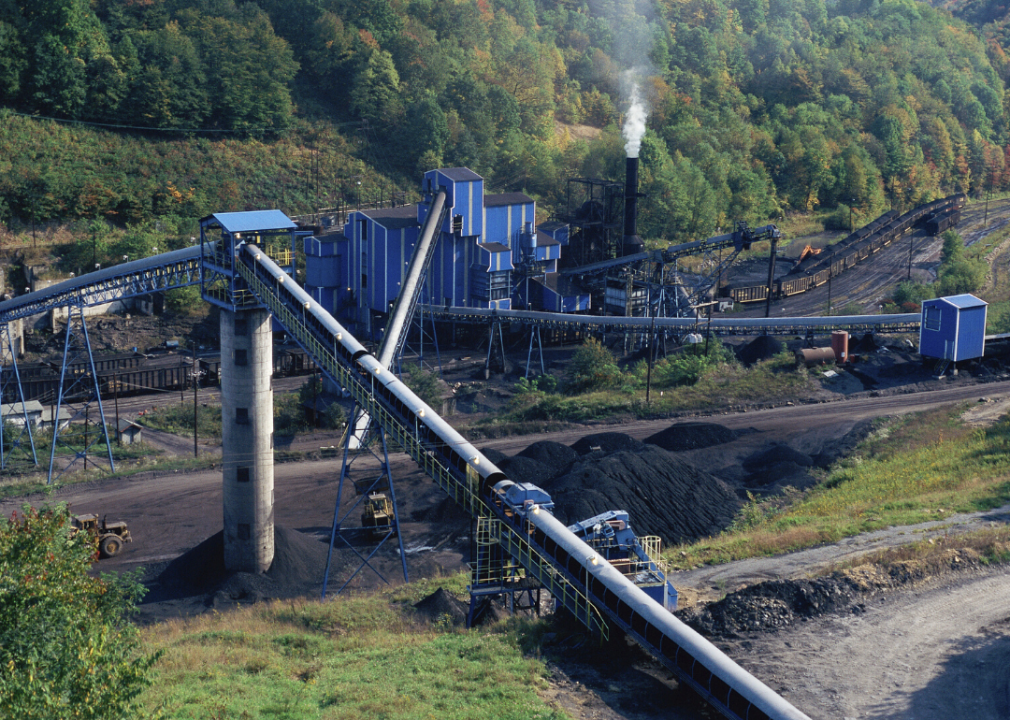
Joseph Sohm // Shutterstock
#80. Murray Energy Corporation, United States
- Contribution to atmospheric carbon dioxide rise, 1880–2010: 0.061 ppm (0.06% of total emissions)
- Contribution to global mean surface temperature rise: 0.0004 C (0.05% of total rise, #75 highest contributor)
- Contribution to global sea level rise: 0.02 mm (0.01% of total rise, #73 highest contributor)
Each year, Murray produced approximately 76 million tons of high quality bituminous coal, but the company filed for bankruptcy protection in October 2019, reporting $2.7 billion in debts and more than $8 billion in obligations, as reported in The New York Times. The report adds how Robert Murray, the former chief executive also spent nearly $1 million in spreading doubt regarding climate change, claimed that the Earth was getting colder, not hotter, and helped shape the Trump administration's energy policies.
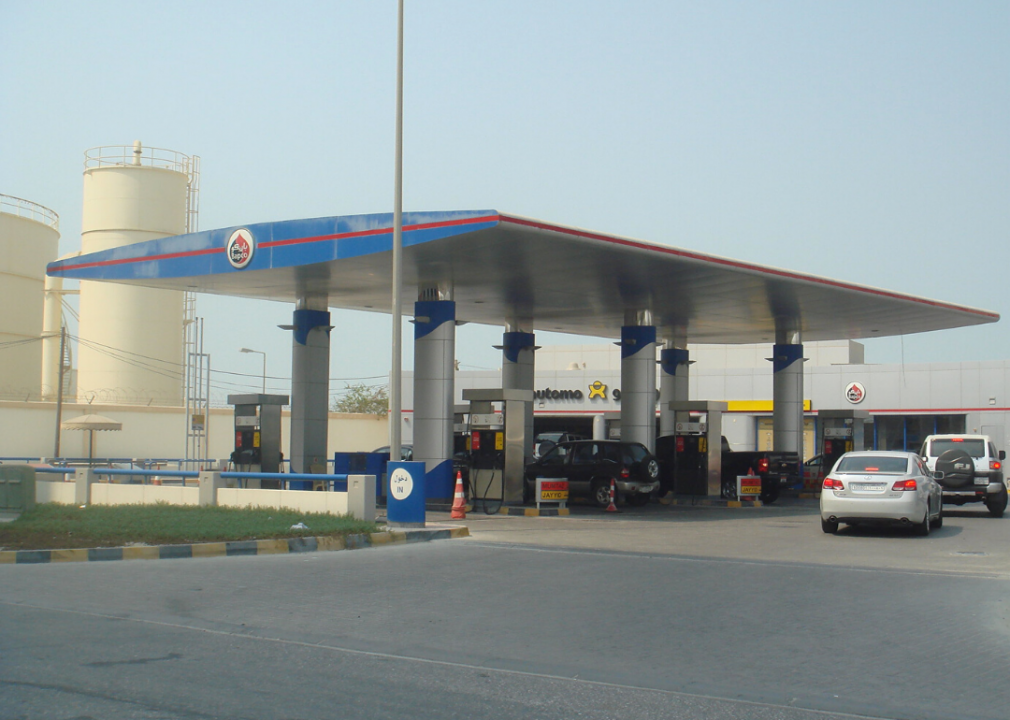
Minale Tattersfield // Flickr
#79. Bahrain Petroleum Corporation, Bahrain
- Contribution to atmospheric carbon dioxide rise, 1880–2010: 0.062 ppm (0.06% of total emissions)
- Contribution to global mean surface temperature rise: 0.0005 C (0.06% of total rise, #71 highest contributor)
- Contribution to global sea level rise: 0.04 mm (0.02% of total rise, #67 highest contributor)
Bahrain Petroleum Corporation is an integrated oil company of Bahrain that was the first to discover oil in the Arabian Peninsula in 1932. Wholly owned by the government, 95% of the company's refined products are exported to the Middle East, Southeast Asia, the Far East, and Africa. The oil-rich company initiated many projects to help reduce emissions and the impact on water, air, and land, but in 2018, the country faced world criticism when it applied to the U.N. Green Climate Fund for $9.8 million for its National Oil and Gas Authority. The country planned to clean up the waste generated from its fossil fuels using the funds, and even as it now faces impending freshwater scarcity due to rising temperatures, Bahrain remains a top exporter of oil.
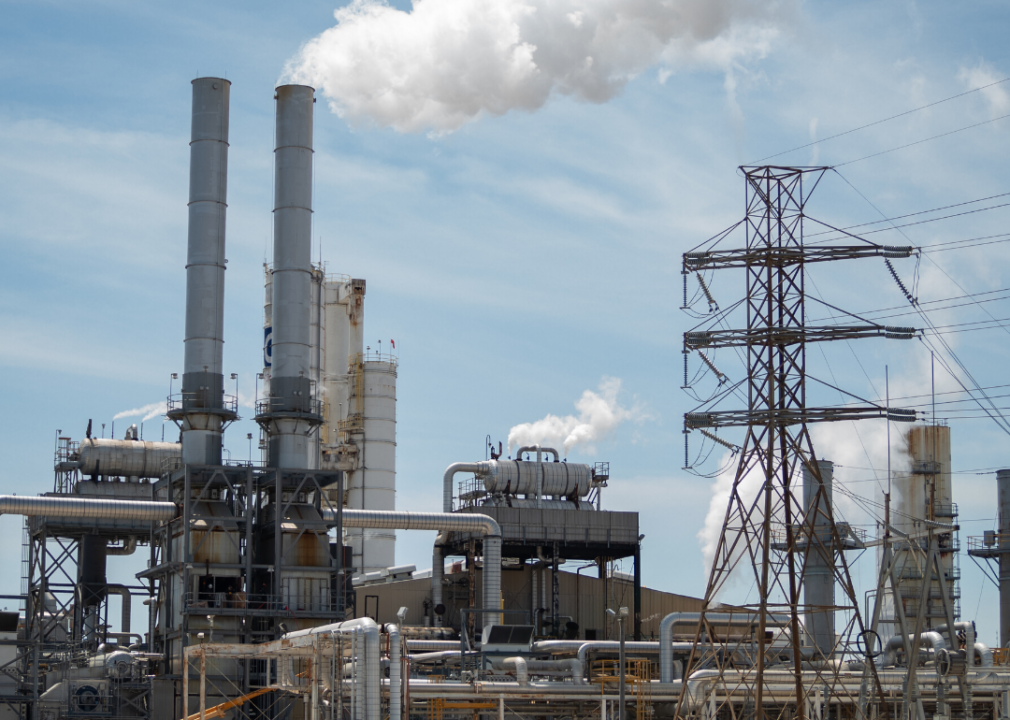
Lucio Vasquez // Shutterstock
#78. Luminant/TXU, United States
- Contribution to atmospheric carbon dioxide rise, 1880–2010: 0.069 ppm (0.07% of total emissions)
- Contribution to global mean surface temperature rise: 0.0005 C (0.06% of total rise, #71 highest contributor)
- Contribution to global sea level rise: 0.05 mm (0.03% of total rise, #62 highest contributor)
Luminant is the largest energy generator in Texas, owning power plants and TXU Energy, its sister company and a retail electricity seller. In its 2018 sustainability report, Vistra Energy, the parent company, states that the company has evolved from one that was predominantly fuelled by coal to one mostly natural gas-fired now. The combined portfolio has decreased carbon dioxide emissions by more than 33%, sulfur dioxide emissions by 66%, and nitrous oxide emissions by 44% since 2010, according to the report.
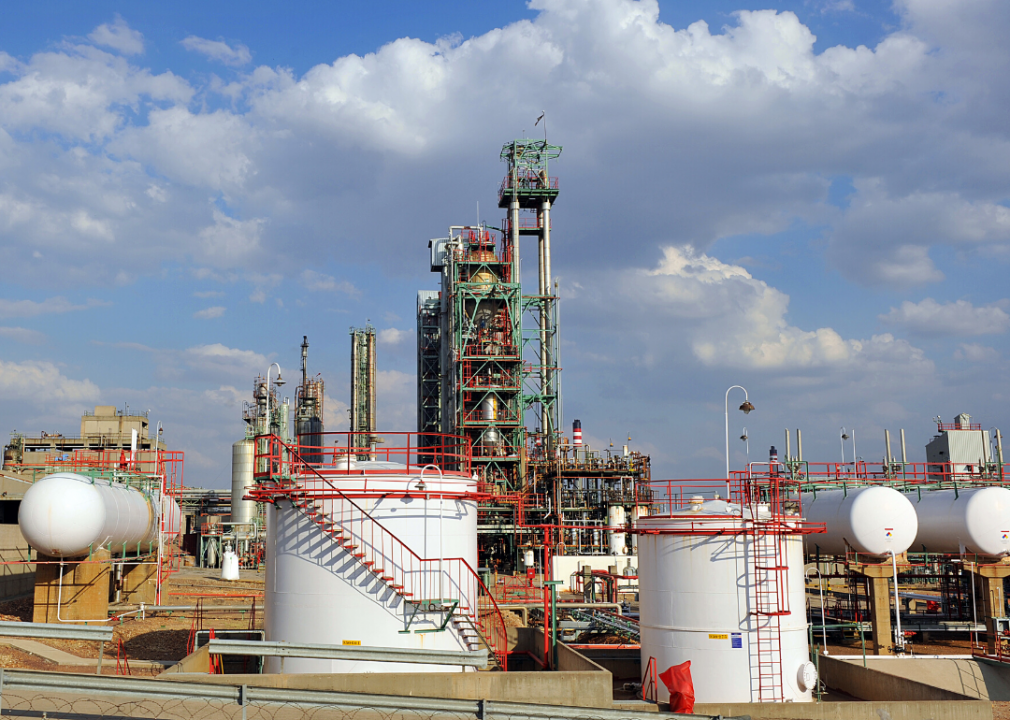
joserpizarro // Shutterstock
#77. Talisman, Canada
- Contribution to atmospheric carbon dioxide rise, 1880–2010: 0.07 ppm (0.07% of total emissions)
- Contribution to global mean surface temperature rise: 0.0004 C (0.06% of total rise, #75 highest contributor)
- Contribution to global sea level rise: 0.02 mm (0.01% of total rise, #73 highest contributor)
This oil and gas exploration and production company was headquartered in Alberta, Canada. It was bought in May 2015 by Repsol, the Spanish oil and gas giant, and the name changed to Repsol Oil & Gas Canada. In December 2019, Repsol was one of the first major oil giants to cut the value of its assets by billions of dollars to transition to a low-carbon economy and achieve the target of net zero emissions by 2050.
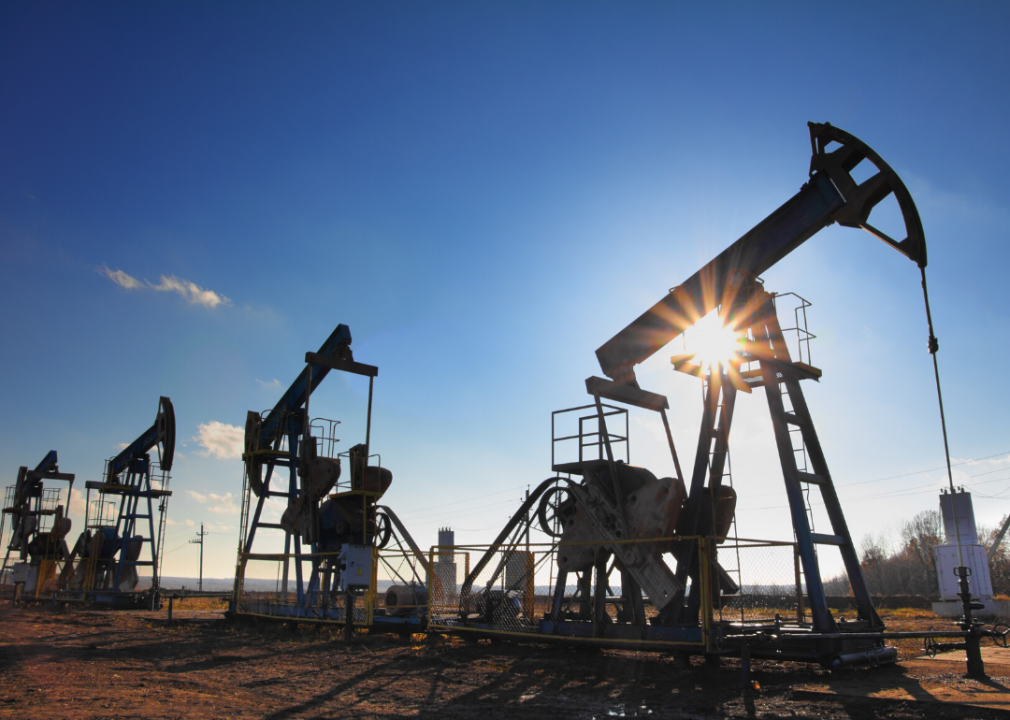
Kokhanchikov // Shutterstock
#76. Apache, United States
- Contribution to atmospheric carbon dioxide rise, 1880–2010: 0.072 ppm (0.07% of total emissions)
- Contribution to global mean surface temperature rise: 0.0004 C (0.05% of total rise, #75 highest contributor)
- Contribution to global sea level rise: 0.02 mm (0.01% of total rise, #73 highest contributor)
Apache Corporation is an oil and gas exploration and production company operating in the United States, Egypt and the United Kingdom in the North Sea. The company has been consistently taking steps to measure, mitigate, and disclose data on the environmental impact of its business. Its 2019 Sustainability Report shows that Apache reduced its global methane emission intensity to 0.37%, 95% of the water consumed for its operation was not fresh, and there has been a 177% increase in using recycled water for hydraulic fracturing since 2014.
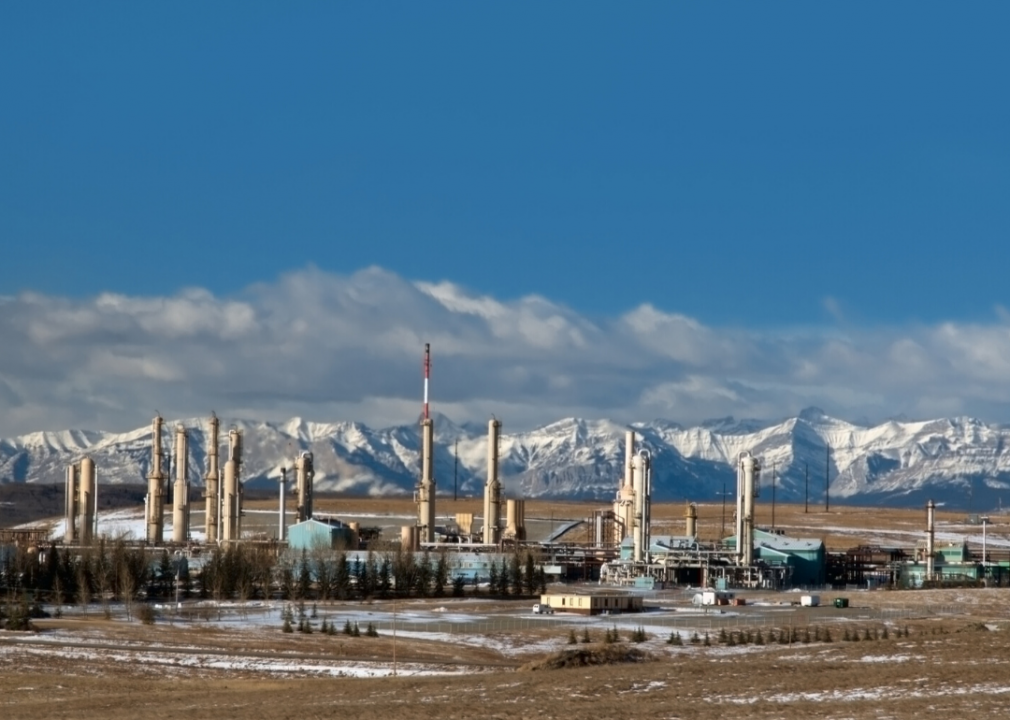
Constantine Androsoff // Shutterstock
#75. Canadian Natural Resources, Canada
- Contribution to atmospheric carbon dioxide rise, 1880–2010: 0.074 ppm (0.07% of total emissions)
- Contribution to global mean surface temperature rise: 0.0004 C (0.05% of total rise, #75 highest contributor)
- Contribution to global sea level rise: 0.01 mm (0.01% of total rise, #83 highest contributor)
Canadian Natural Resources is an independent energy producer with diversified assets in natural gas, light crude oil, heavy crude oil, bitumen, and synthetic crude oil. The company states that through its Environmental Excellence program it works to reduce GHG emissions and freshwater use, minimize habitat disturbance, and protect biodiversity.
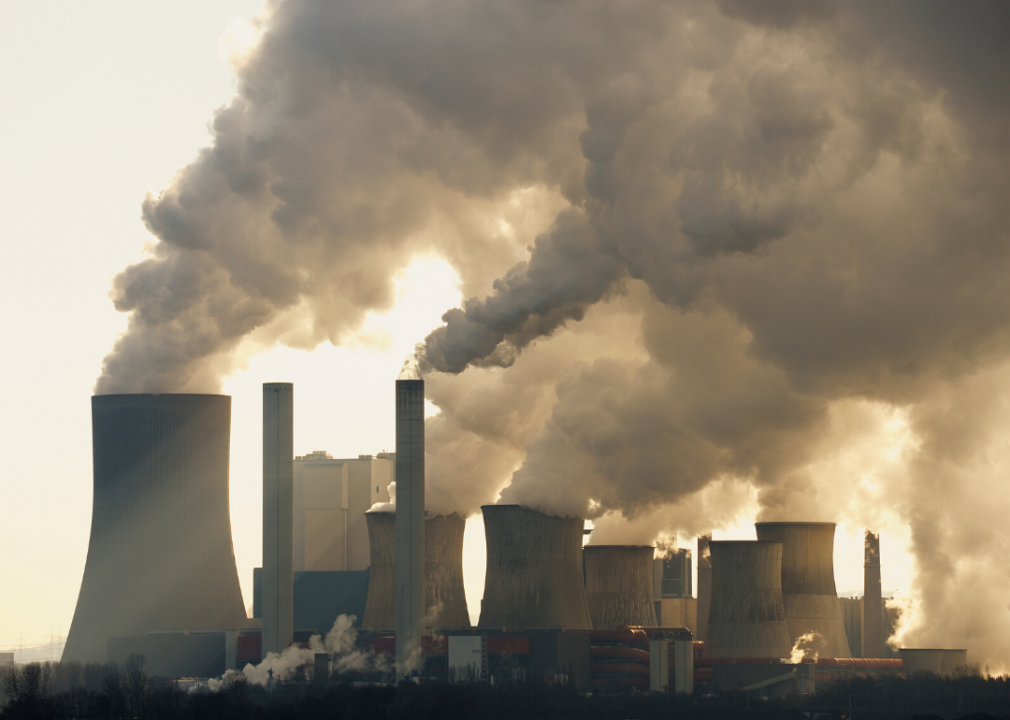
Red Squirrel // Shutterstock
#74. Ruhrkohle AG (RAG), Germany
- Contribution to atmospheric carbon dioxide rise, 1880–2010: 0.075 ppm (0.07% of total emissions)
- Contribution to global mean surface temperature rise: 0.0006 C (0.07% of total rise, #67 highest contributor)
- Contribution to global sea level rise: 0.05 mm (0.03% of total rise, #62 highest contributor)
Founded in 1968, RAG AG, formerly known as Ruhrkohle AG, is the biggest German coal mining corporation. For more than 150 years, Germany mined millions of tons of anthracite, or hard coal, from coal mines, but it bid farewell to coal mining in December 2018. The country's Climate Action Plan 2050 emphasizes structural changes for reducing GHG emissions to 55% by 2030 and at least 70% by 2040, and RAG is now involved in mine drainage, polder measures, and groundwater purification.
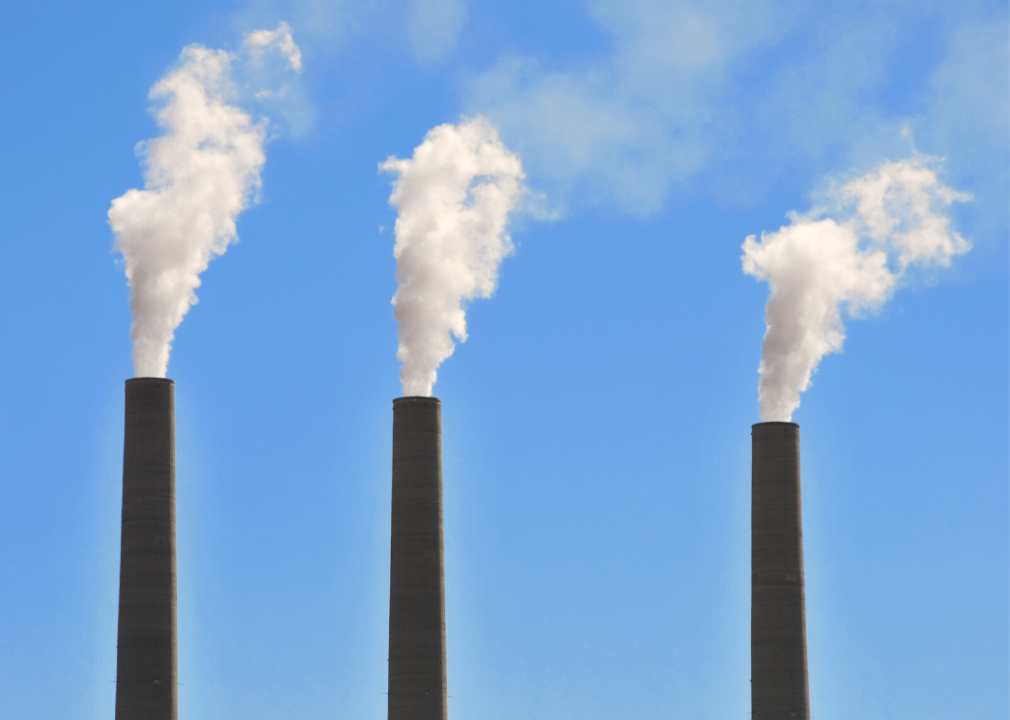
Amy Nichole Harris // Shutterstock
#73. North American Coal, United States
- Contribution to atmospheric carbon dioxide rise, 1880–2010: 0.079 ppm (0.08% of total emissions)
- Contribution to global mean surface temperature rise: 0.0005 C (0.07% of total rise, #71 highest contributor)
- Contribution to global sea level rise: 0.06 mm (0.03% of total rise, #57 highest contributor)
With 10 operational surface coal mines, NACoal delivers over 30 million tons of coal. While the company works to restore the habitat in reclaimed lands, preserve wetlands, plant trees, and build streams, how much work has been done for climate change mitigation at present is not clear. The company website mentions using innovative technologies to reduce emissions like integrating Dryfining technology to reduce coal moisture and emissions.
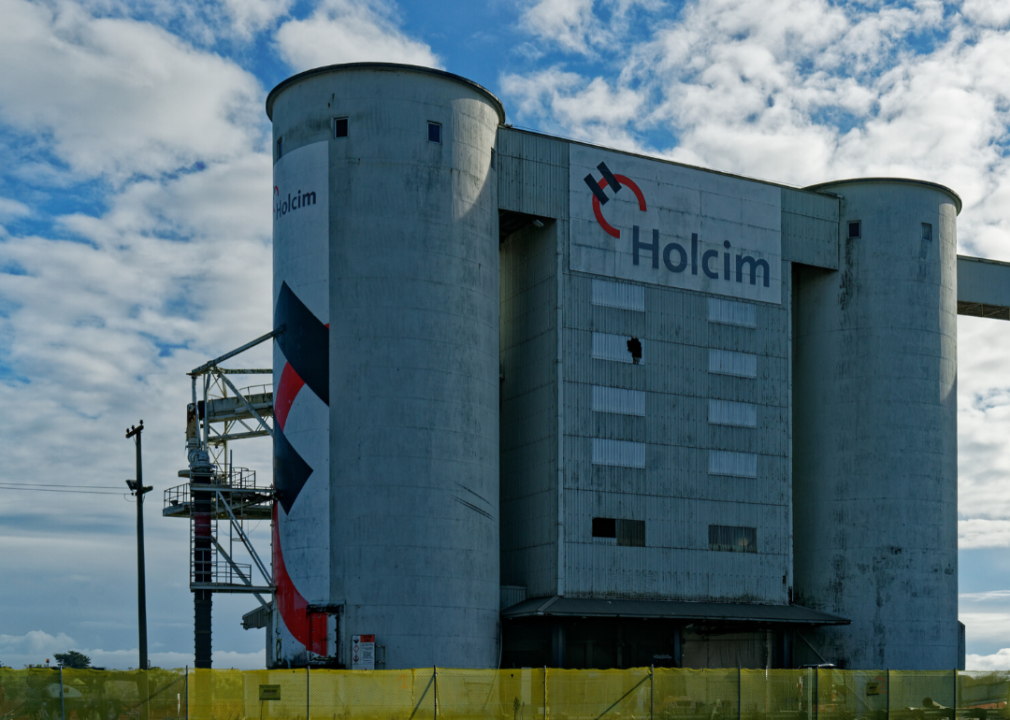
Gary Webber // Shutterstock
#72. Holcim, Switzerland
- Contribution to atmospheric carbon dioxide rise, 1880–2010: 0.081 ppm (0.08% of total emissions)
- Contribution to global mean surface temperature rise: 0.0004 C (0.05% of total rise, #75 highest contributor)
- Contribution to global sea level rise: 0.02 mm (0.01% of total rise, #73 highest contributor)
Holcim, a Swiss building material company established in 1912, first expanded to France and then into Europe, the United States, and Asia, and is doing business in more than 70 countries today. In past years, the company offered as a green initiative, a newly developed and resource-efficient cement—Susteno 3R—made of "high-quality processed mixed granulate from demolition projects." Holcim has reduced its carbon emission by 30% since 1990, though it is still one of the largest climate culprits in the country.
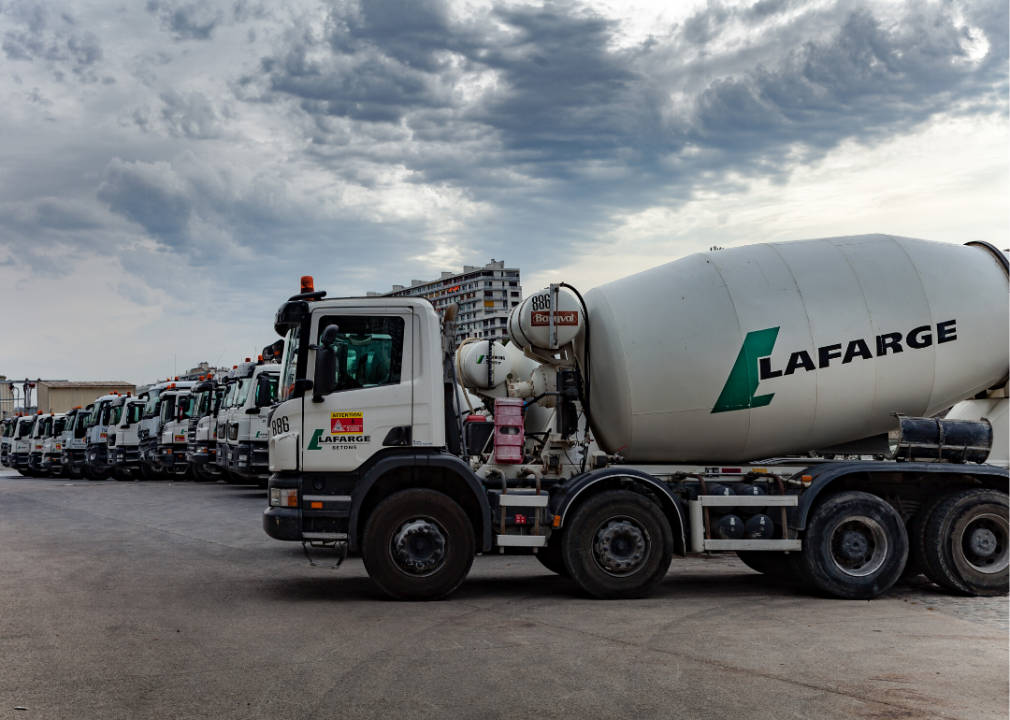
Guillaume Louyot Onickz Artworks // Shutterstock
#71. Lafarge, France
- Contribution to atmospheric carbon dioxide rise, 1880–2010: 0.084 ppm (0.08% of total emissions)
- Contribution to global mean surface temperature rise: 0.0004 C (0.05% of total rise, #75 highest contributor)
- Contribution to global sea level rise: 0.02 mm (0.01% of total rise, #73 highest contributor)
Lafarge specialized in cement, concrete, and construction aggregates, and in 2015 it merged with Holcim, a Swiss cement company, and the two now operate under the global name LafargeHolcim. According to the company's website, its cement is among the most carbon-efficient in the world, and it has reduced its net carbon emissions per metric ton of cement by 25%, which leads international cement companies with the highest reduction compared to a 1990 baseline. The emission reduction is being done by using clinker substitutes, using pre-treated waste and low-carbon fuels, and becoming energy-efficient.
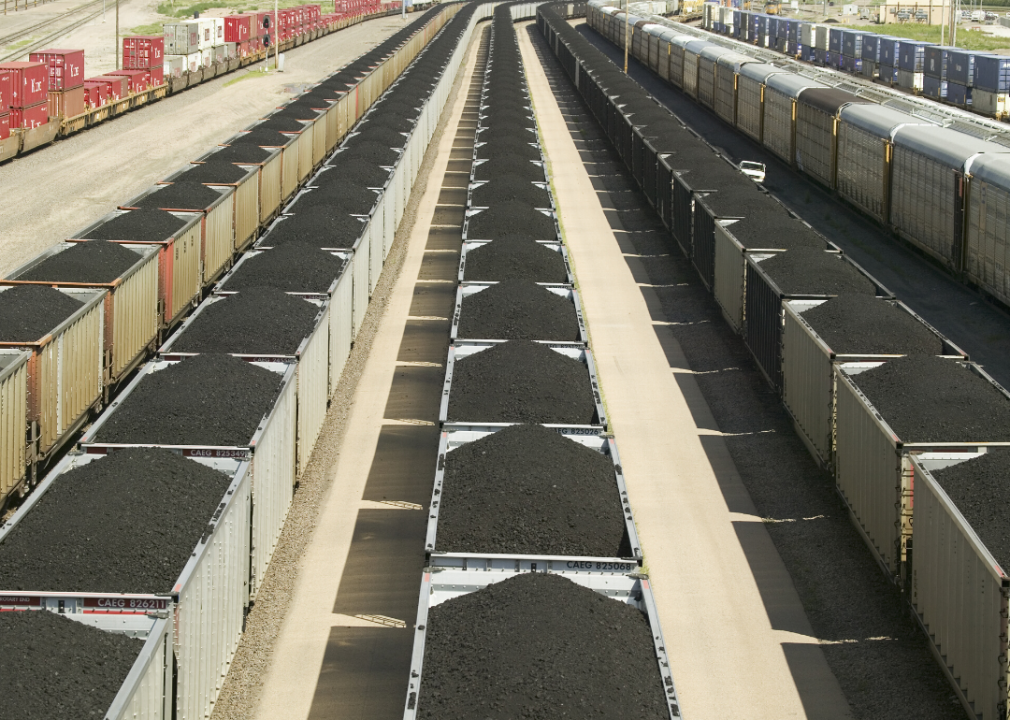
Joseph Sohm // Shutterstock
#69. Kiewit Mining Group, United States (tie)
- Contribution to atmospheric carbon dioxide rise, 1880–2010: 0.087 ppm (0.08% of total emissions)
- Contribution to global mean surface temperature rise: 0.0006 C (0.07% of total rise, #67 highest contributor)
- Contribution to global sea level rise: 0.07 mm (0.04% of total rise, #56 highest contributor)
Kiewit Mining group began its operations by building highways across the Rocky Mountains. In 1943, it launched a new technique for that time—surface coal mining, and today the company is one of the 10 largest coal producers in the nation. As of 2019, the company's name is listed as one of the top 100 producers of GHGs, with 0.12% emissions recorded between 1988 and 2015.
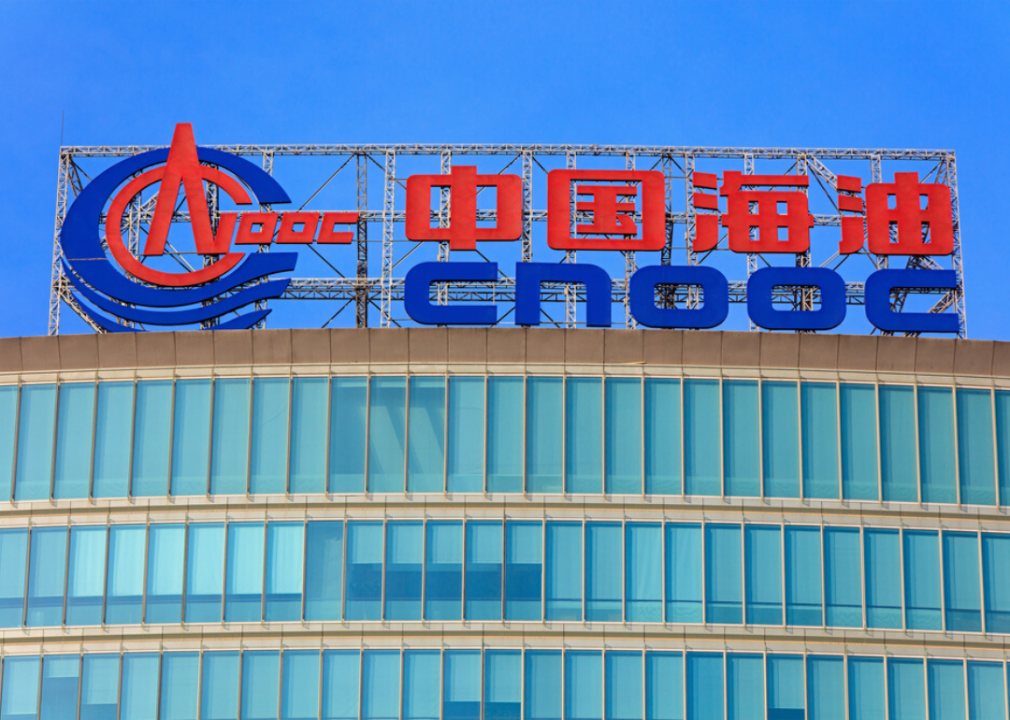
testing // Shutterstock
#69. CNOOC Limited (China National Offshore Oil Co.), China (tie)
- Contribution to atmospheric carbon dioxide rise, 1880–2010: 0.087 ppm (0.09% of total emissions)
- Contribution to global mean surface temperature rise: 0.0005 C (0.06% of total rise, #71 highest contributor)
- Contribution to global sea level rise: 0.02 mm (0.01% of total rise, #73 highest contributor)
CNOOC is China's third-largest oil company with operations in Bohai, the Western South China Sea, the Eastern South China Sea, and the East China Sea in offshore China, and oil and gas assets in Asia, Africa, North America, South America, Oceania, and Europe. In 2018, the company adopted a low-carbon management system based on the national policies and practices, and for carbon and climate management. Based on the system, the company now has set up rules for carbon data collection methods and carbon reduction work.
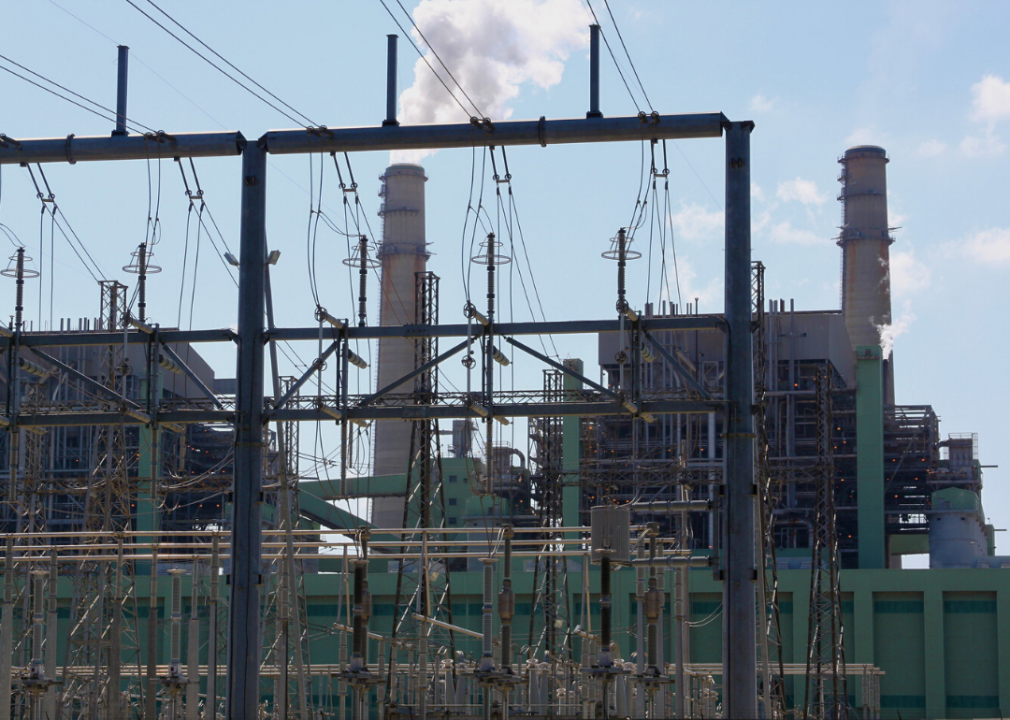
Roy Luck // Flickr
#68. Westmoreland Mining, United States
- Contribution to atmospheric carbon dioxide rise, 1880–2010: 0.092 ppm (0.09% of total emissions)
- Contribution to global mean surface temperature rise: 0.0006 C (0.08% of total rise, #67 highest contributor)
- Contribution to global sea level rise: 0.13 mm (0.07% of total rise, #44 highest contributor)
The company has been part of the energy sector for more than 150 years, beginning with coal mines in Pennsylvania, but it continually lost money as electricity generation markets moved away from coal, and faced bankruptcy in 2018. Still, the company seems to remain in denial of climate change. In 2019, President Donald Trump's administration approved a major expansion of its Rosebud Coal Mine in Montana, despite warnings and a lawsuit by environmental groups.
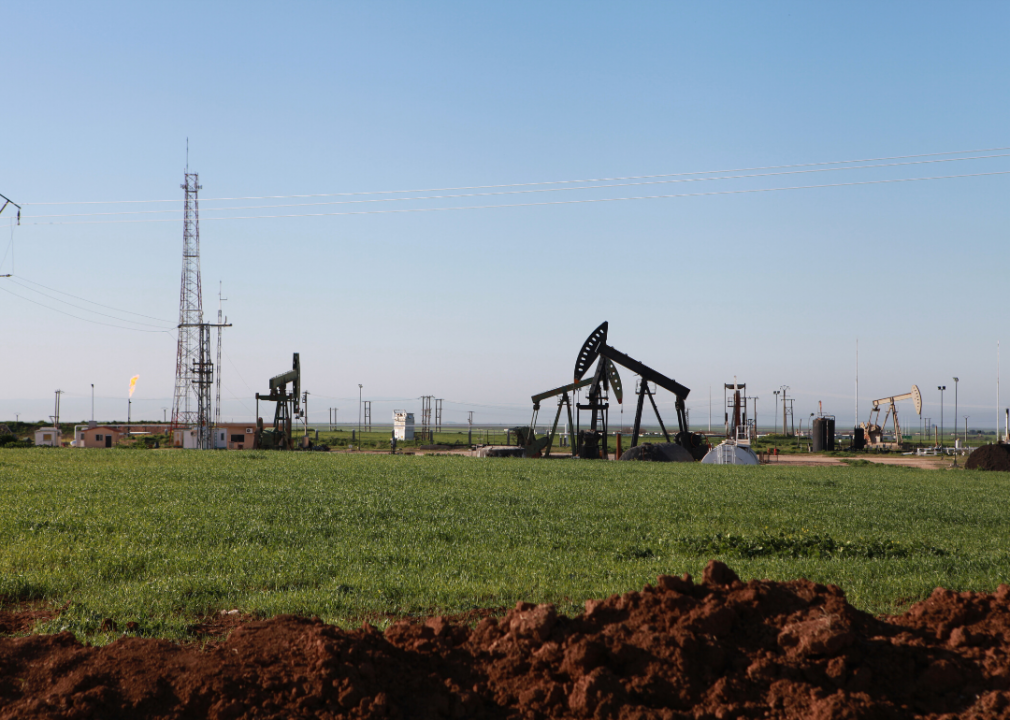
fpolat69 // Shutterstock
#67. Syrian Petroleum, Syria
- Contribution to atmospheric carbon dioxide rise, 1880–2010: 0.098 ppm (0.10% of total emissions)
- Contribution to global mean surface temperature rise: 0.0007 C (0.08% of total rise, #63 highest contributor)
- Contribution to global sea level rise: 0.06 mm (0.03% of total rise, #57 highest contributor)
Syrian Petroleum is a state-owned oil exploration and production company in non-industrialized Syria. Because of a terrorist war since 2011, the country could not enact major environmental policies or mitigation measures to fight climate change. But as the country also fights environmental calamities such as drying up of rivers and unprecedented temperature rise, Syria has voluntarily prepared 2020-2030 goals and strategies to fight climate change.
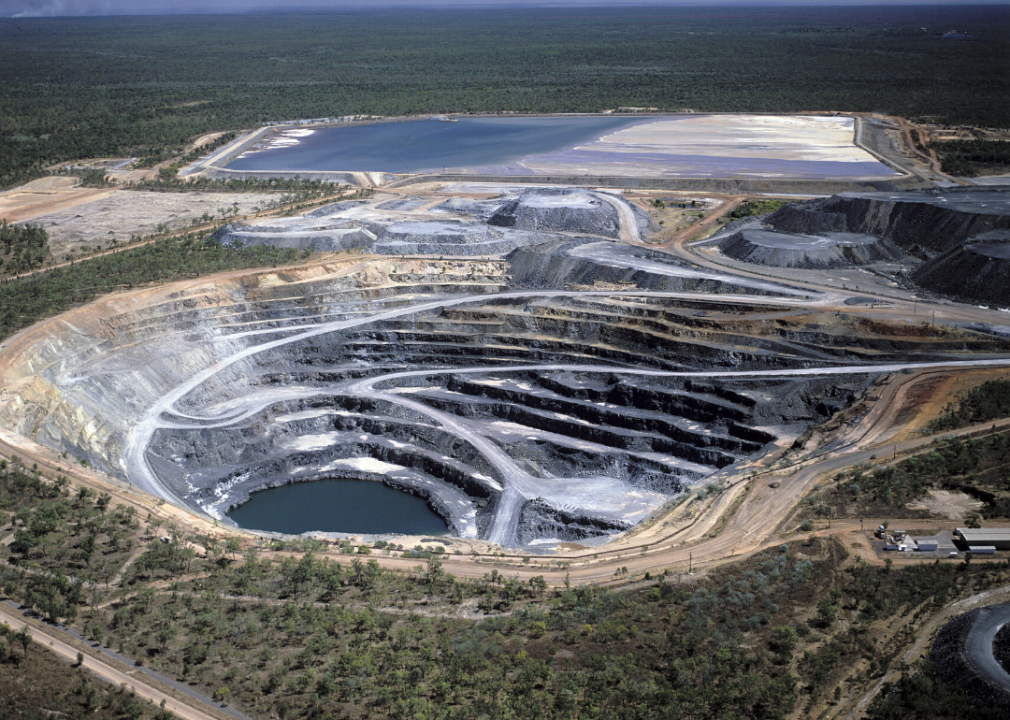
John Carnemolla // Shutterstock
#66. Cyprus Amax Minerals Co., United States
- Contribution to atmospheric carbon dioxide rise, 1880–2010: 0.101 ppm (0.10% of total emissions)
- Contribution to global mean surface temperature rise: 0.0008 C (0.10% of total rise, #60 highest contributor)
- Contribution to global sea level rise: 0.13 mm (0.08% of total rise, #44 highest contributor)
Established in 1993, Cyprus Amax is involved in the extraction and marketing of mineral resources, and is among the world leaders in the production of molybdenum and lithium, also producing coal, copper, iron ore, and gold. In 2017, the United States, on behalf of the United States Environmental Protection Agency (EPA) and other federal agencies, entered what has been called a historic settlement with Cyprus Amax and Western Nuclear, to clean 94 of the abandoned uranium mines in the Navajo Nation. According to one projection, the amount of carbon dioxide emitted by Cyprus is expected to decrease by 2050, reaching 5.8 metric tons.
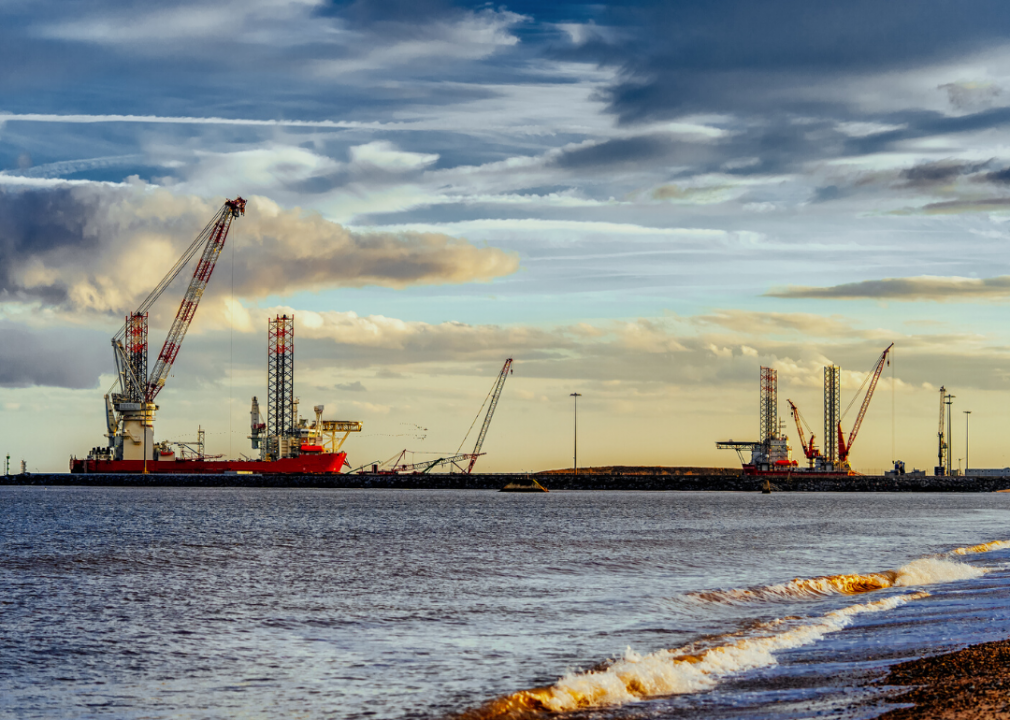
Marcel Poncu // Shutterstock
#65. BG Group (British Gas), United Kingdom
- Contribution to atmospheric carbon dioxide rise, 1880–2010: 0.104 ppm (0.10% of total emissions)
- Contribution to global mean surface temperature rise: 0.0007 C (0.09% of total rise, #63 highest contributor)
- Contribution to global sea level rise: 0.06 mm (0.03% of total rise, #57 highest contributor)
BG Group was a British oil company acquired by Royal Dutch Shell in 2015. Before the acquisition, BG Group was the largest natural gas supplier to the United States. The company, while acknowledging the risk of climate change to its operations and its direct contribution to it, keeps stressing its natural gas business has lower emissions than coal.
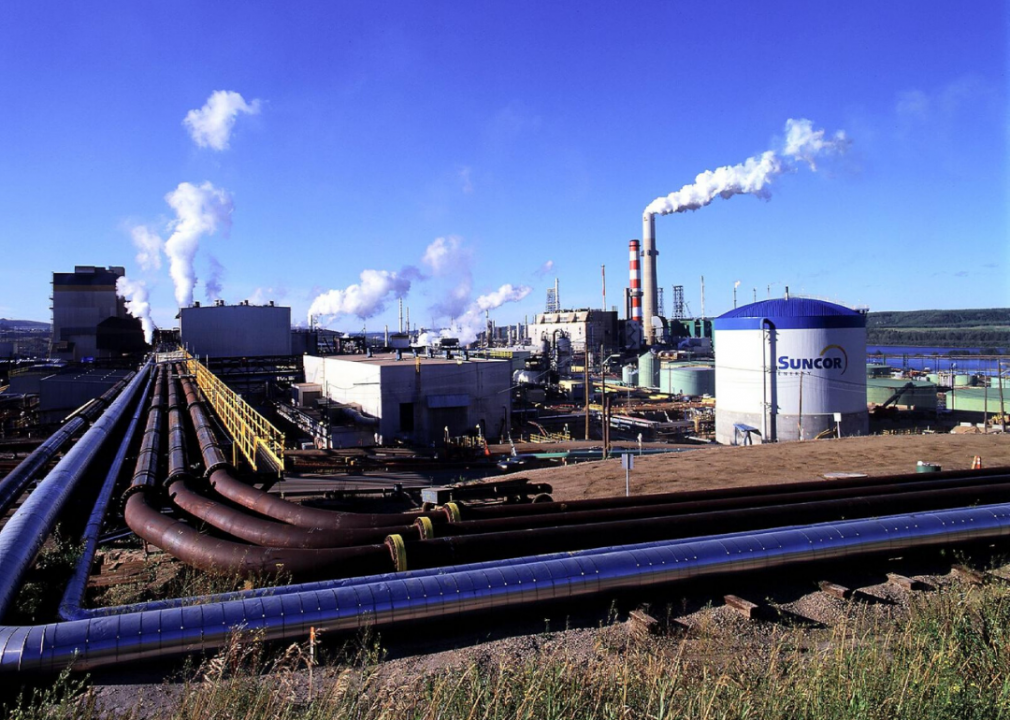
Suncor Energy // Flickr
#64. Suncor, Canada
- Contribution to atmospheric carbon dioxide rise, 1880–2010: 0.105 ppm (0.10% of total emissions)
- Contribution to global mean surface temperature rise: 0.0007 C (0.08% of total rise, #63 highest contributor)
- Contribution to global sea level rise: 0.04 mm (0.02% of total rise, #67 highest contributor)
Based in Alberta, Canada, Suncor specializes in producing synthetic crude from oil sands. In 2018, Suncor's CEO remarked that climate change was backed by science and deniers need to accept it. Introducing new technologies has allowed the company to reduce its GHG emissions by approximately 60% since the 1990s.
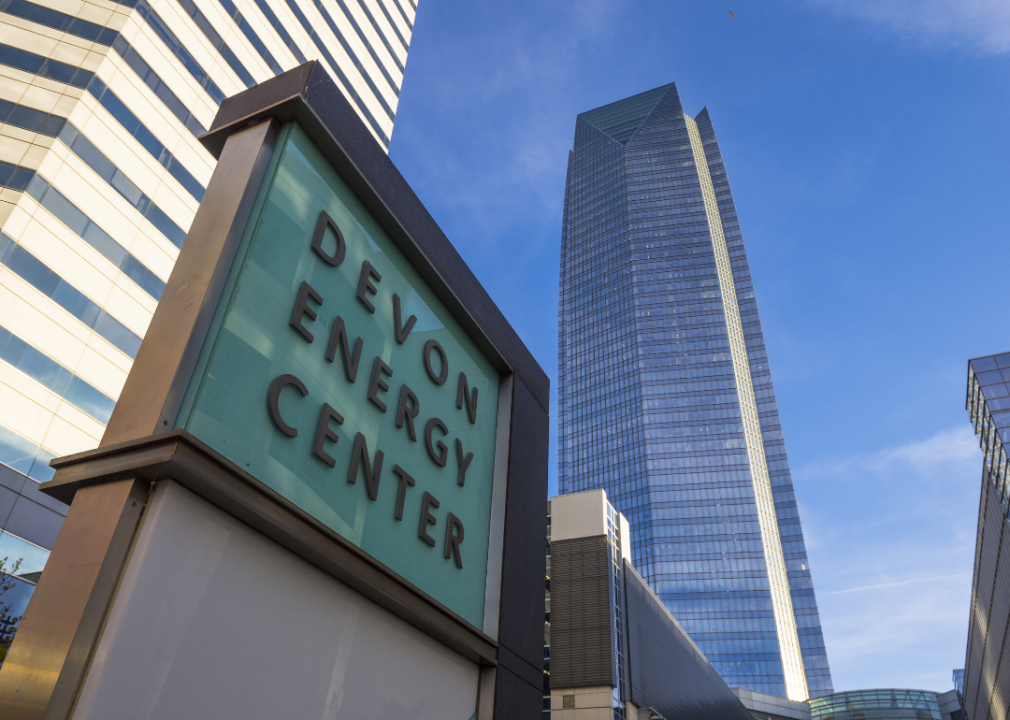
4kclips // Shutterstock
#63. Devon Energy, United States
- Contribution to atmospheric carbon dioxide rise, 1880–2010: 0.12 ppm (0.12% of total emissions)
- Contribution to global mean surface temperature rise: 0.0009 C (0.11% of total rise, #58 highest contributor)
- Contribution to global sea level rise: 0.05 mm (0.03% of total rise, #62 highest contributor)
Devon Energy, a Fortune 500 company, produces approximately 140,000 barrels of oil per day in the United States as stated on its website, and it also produces natural gas. The company published its climate change assessment report in 2018 and stated its 2025 target of 0.28% of methane emission intensity. It has also been voluntarily reporting on how it reduces emissions and has also founded the Environmental Partnership in the United States with other oil companies committed to improve their overall environmental performances.
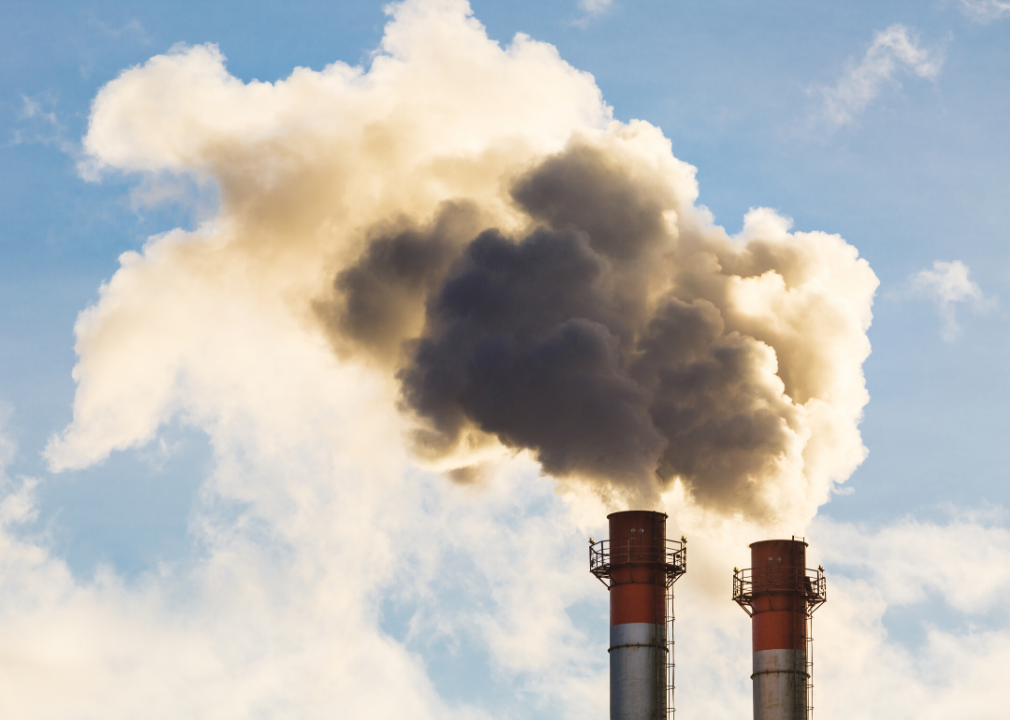
Konstantin Kolosov // Shutterstock
#62. EnCana, Canada
- Contribution to atmospheric carbon dioxide rise, 1880–2010: 0.121 ppm (0.12% of total emissions)
- Contribution to global mean surface temperature rise: 0.0009 C (0.11% of total rise, #58 highest contributor)
- Contribution to global sea level rise: 0.04 mm (0.02% of total rise, #67 highest contributor)
EnCana was Canada's oldest and largest energy company before 2019 when it moved to the United States and changed its name to Ovintiv. In its 2018 sustainability report, the company pledged to support the new regulations in Canada, effective January 1, 2020, which ask the sector to reduce methane emission by 40–45% by 2025 in relation to 2012. The report also highlights how the company has reduced its methane intensity as well as GHG intensity from 2016 to 2018.

testing // Shutterstock
#61. Sinopec, China
- Contribution to atmospheric carbon dioxide rise, 1880–2010: 0.126 ppm (0.12% of total emissions)
- Contribution to global mean surface temperature rise: 0.0006 C (0.08% of total rise, #67 highest contributor)
- Contribution to global sea level rise: 0.02 mm (0.01% of total rise, #73 highest contributor)
China Petroleum & Chemical Corporation, or Sinopec, is an oil and gas company based in Beijing, and also operating from Hong Kong and New York. It faced some flak for not revealing its climate change mitigation strategy and not giving full disclosure to investors, but since 2018 it has set up internal task forces and committees for overseeing climate-related issues. It also announced the Green Enterprise Action Plan in 2018 to tackle emission goals, and green production, technology, service, and culture.
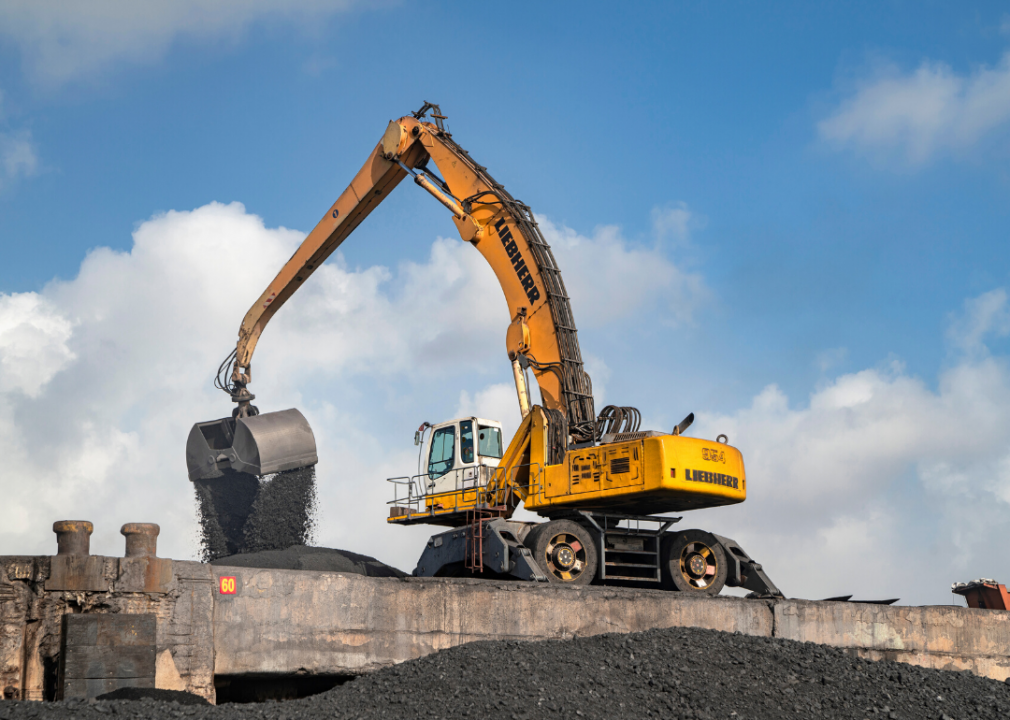
Hari Mahidhar // Shutterstock
#60. Singareni Collieries Company, India
- Contribution to atmospheric carbon dioxide rise, 1880–2010: 0.129 ppm (0.13% of total emissions)
- Contribution to global mean surface temperature rise: 0.0008 C (0.10% of total rise, #60 highest contributor)
- Contribution to global sea level rise: 0.09 mm (0.05% of total rise, #54 highest contributor)
Singareni Collieries Company, or SCCL, is a government-owned coal mine in India that was the first to mechanize coal mines in the country by adopting coal drilling machines in 1937. The company in its environment management document states it has taken initiatives to curb air and water pollution and check on noise pollution. Meanwhile, the Indian environment ministry has cleared 10 coal mining projects recently, including one with SCCL, for a total capacity of 160 million metric tons a year.
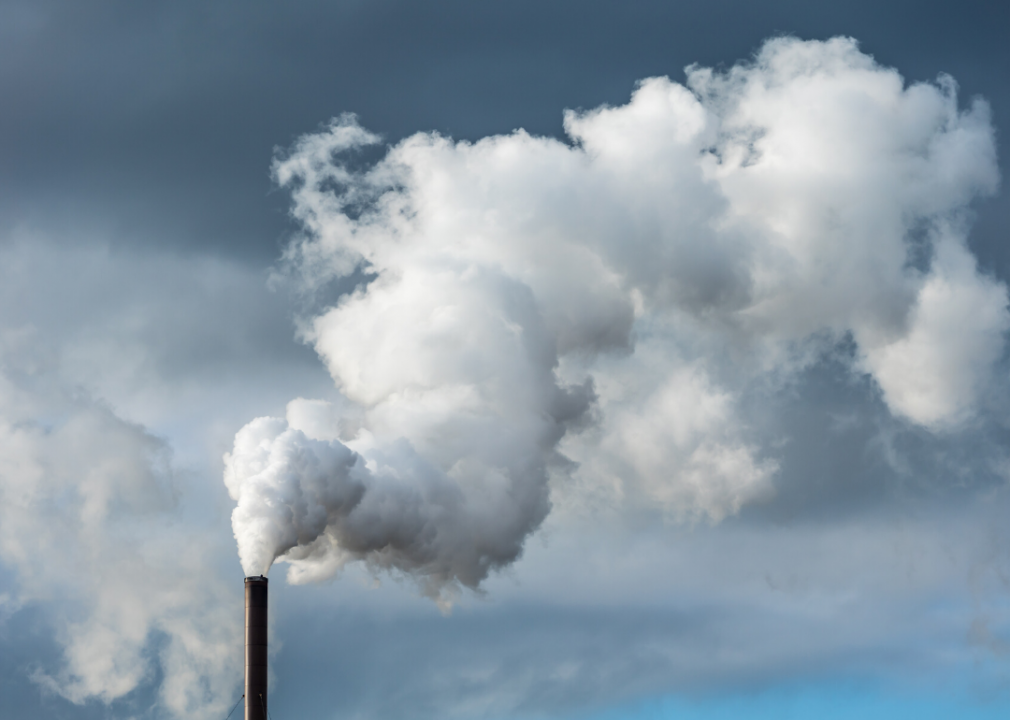
Magnus Binnerstam // Shutterstock
#59. Ecopetrol, Colombia
- Contribution to atmospheric carbon dioxide rise, 1880–2010: 0.131 ppm (0.13% of total emissions)
- Contribution to global mean surface temperature rise: 0.0008 C (0.11% of total rise, #60 highest contributor)
- Contribution to global sea level rise: 0.06 mm (0.03% of total rise, #57 highest contributor)
Ecopetrol is an oil and natural gas company based in Colombia. In 2019, the company committed to a 20% GHG emissions reduction by 2030 and reducing its operational vulnerability to climate change. Also, from 2013 to 2017, the company reduced emissions of over 1 million tons of CO2-equivalent.
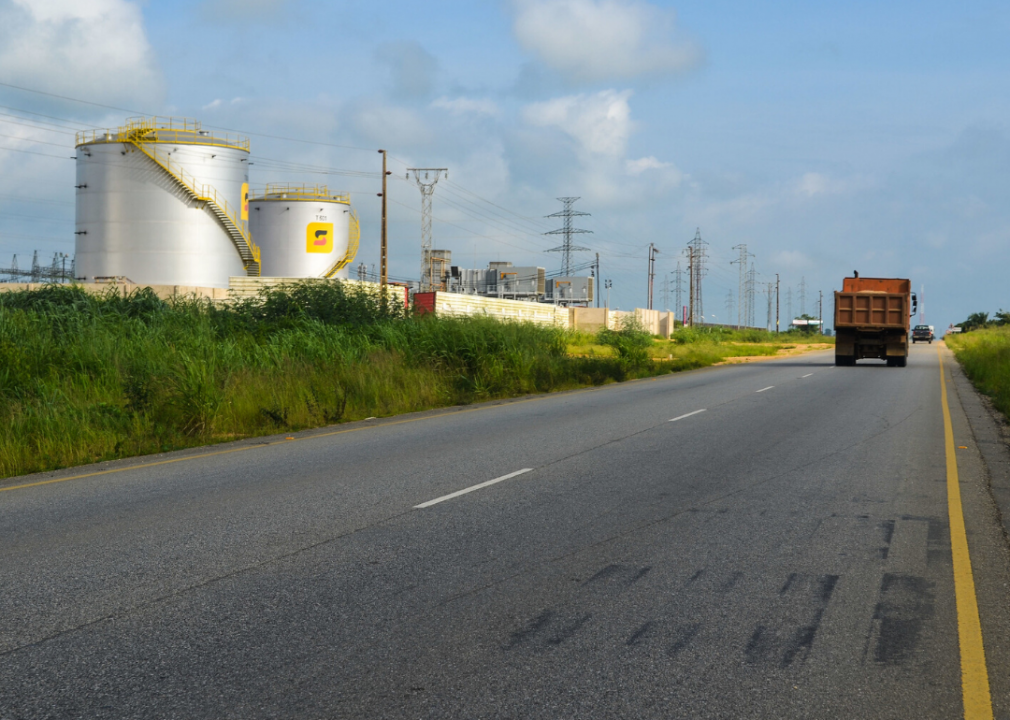
jbdodane // Flickr
#58. Sonangol, Angola
- Contribution to atmospheric carbon dioxide rise, 1880–2010: 0.139 ppm (0.14% of total emissions)
- Contribution to global mean surface temperature rise: 0.0007 C (0.09% of total rise, #63 highest contributor)
- Contribution to global sea level rise: 0.05 mm (0.03% of total rise, #62 highest contributor)
Angola is Africa's second-largest oil producer, and Sonangol has an exclusive license to produce and export it. But the company has been facing an internal crisis since 2015 due to reduced oil prices and executive restructuring. The country's economy depends heavily on hydrocarbon production, but it is slowly taking steps to introduce renewable energy sources such as a 50-megawatt solar power plant in Namibe, agreed upon with Italian company Eni in 2019 and reported in pv-magazine.
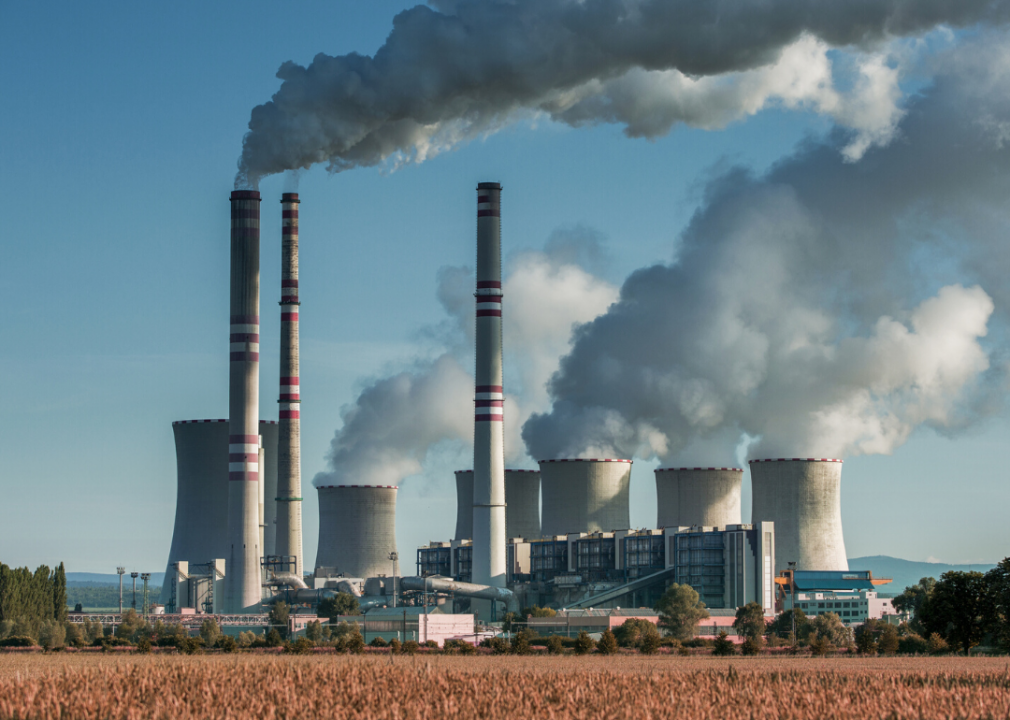
kamilpetran // Shutterstock
#57. Czech Republic (government-owned company)
- Contribution to atmospheric carbon dioxide rise, 1880–2010: 0.148 ppm (0.14% of total emissions)
- Contribution to global mean surface temperature rise: 0.001 C (0.12% of total rise, #52 highest contributor)
- Contribution to global sea level rise: 0.05 mm (0.03% of total rise, #62 highest contributor)
The first commercial oil extraction in the Czech Republic was in 1919, and wealthy corporations have continued to control the fossil fuel market with half of the country's electricity still generated from coal. Climate and energy policies were brought into focus in 2019 when thousands of school children skipped class to march through Prague and other cities, according to the Green European Journal, which also points out that the country's CO2 emission ranks among the highest in the European Union, both in terms of per capita and per unit of GDP. Without a meaningful climate policy, these levels will remain high.

Yossi Manor // Shutterstock
#56. Hess, United States
- Contribution to atmospheric carbon dioxide rise, 1880–2010: 0.149 ppm (0.15% of total emissions)
- Contribution to global mean surface temperature rise: 0.001 C (0.13% of total rise, #52 highest contributor)
- Contribution to global sea level rise: 0.15 mm (0.09% of total rise, #41 highest contributor)
Hess is an oil and natural gas exploration and production company that has been working for the past 11 years to drive sustainable economies while mitigating the climate crisis. The company is on track to decrease its flaring by 50% and 25% of its GHG emissions by 2020, as compared to its 2014 levels. The CDP has recognized the company's disclosure policies and management of climate change risks in its Climate Change Report of 2019.
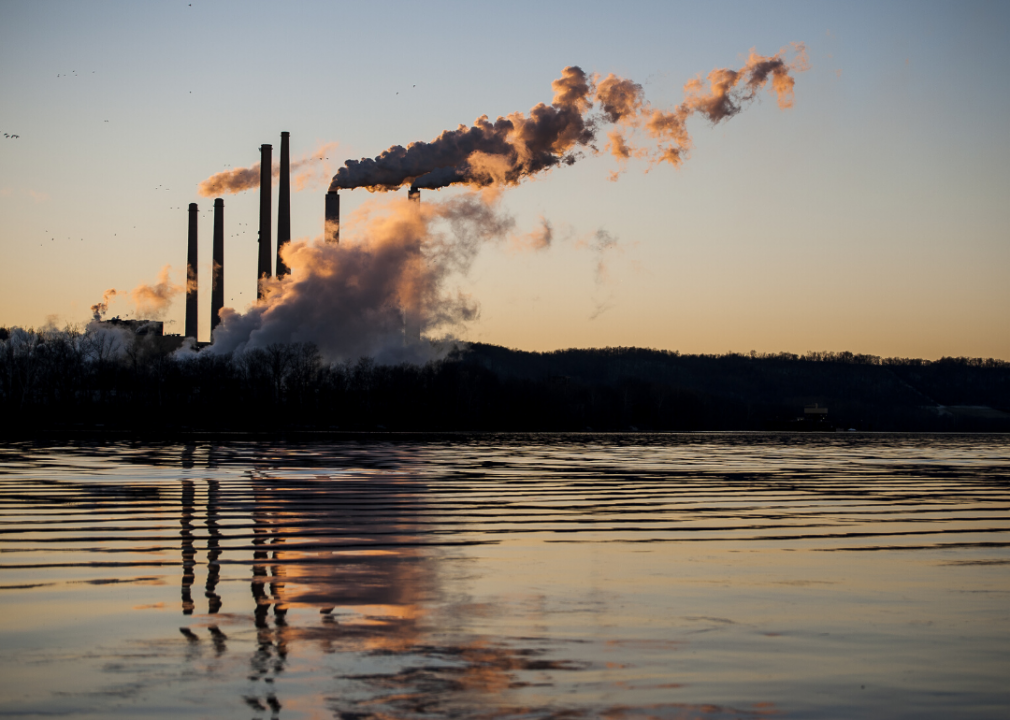
Sherman Cahal // Shutterstock
#55. Massey Energy Corporation, United States
- Contribution to atmospheric carbon dioxide rise, 1880–2010: 0.157 ppm (0.15% of total emissions)
- Contribution to global mean surface temperature rise: 0.001 C (0.13% of total rise, #52 highest contributor)
- Contribution to global sea level rise: 0.08 mm (0.04% of total rise, #55 highest contributor)
Massey Energy Corporation, a coal extractor with operations in Virginia, West Virginia, and Kentucky, was among the top four producers of coal in the United States. In 2010, a tragic accident in one of its mines in Upper Big Branch Mine led to the death of 29 miners, and in 2011, it was acquired by Alpha Natural Resources. The company had been known to be a climate change denier, with its then-CEO Don Blankenship saying in an interview that global warming is a hoax.
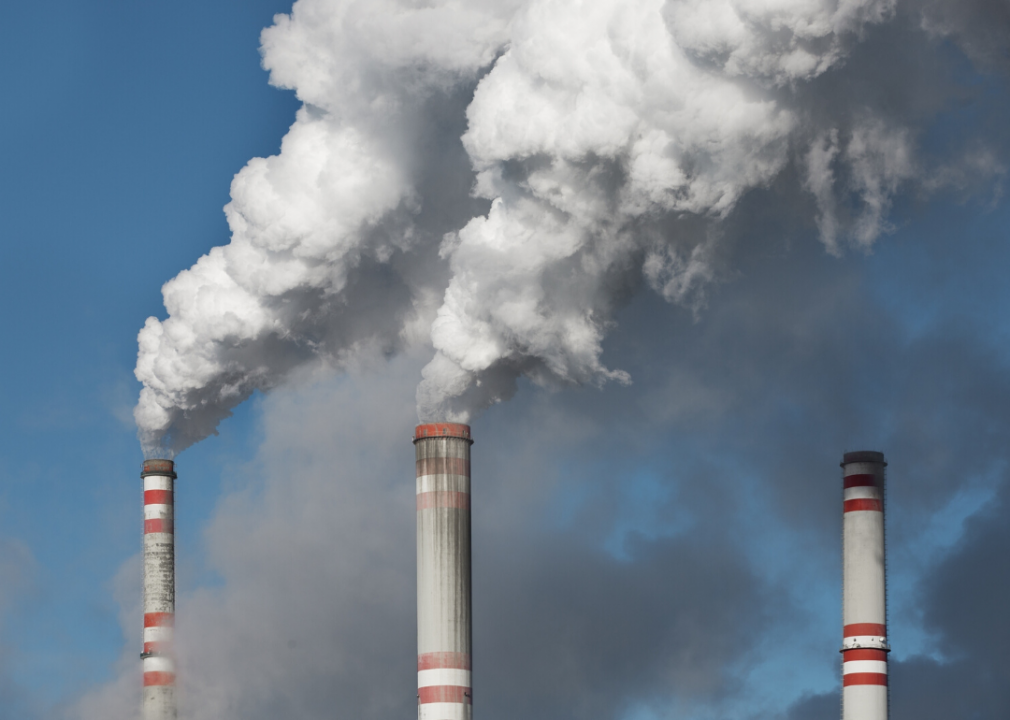
kamilpetran // Shutterstock
#54. Alpha Natural Resources, United States
- Contribution to atmospheric carbon dioxide rise, 1880–2010: 0.173 ppm (0.17% of total emissions)
- Contribution to global mean surface temperature rise: 0.001 C (0.12% of total rise, #52 highest contributor)
- Contribution to global sea level rise: 0.03 mm (0.01% of total rise, #71 highest contributor)
This American company is a producer of metallurgical coal, with 40% produced by the company and 60% of it obtained from subsidiaries. In 2015, after four years of losses, Alpha Natural Resources went through a bankruptcy, and according to The Wall Street Journal, the company paid $18,600 to Chris Horner, an author and global warming skeptic, filing for Chapter 11 bankruptcy protection. The company also routinely funded political groups that opposed environmental regulations surrounding the coal industry.
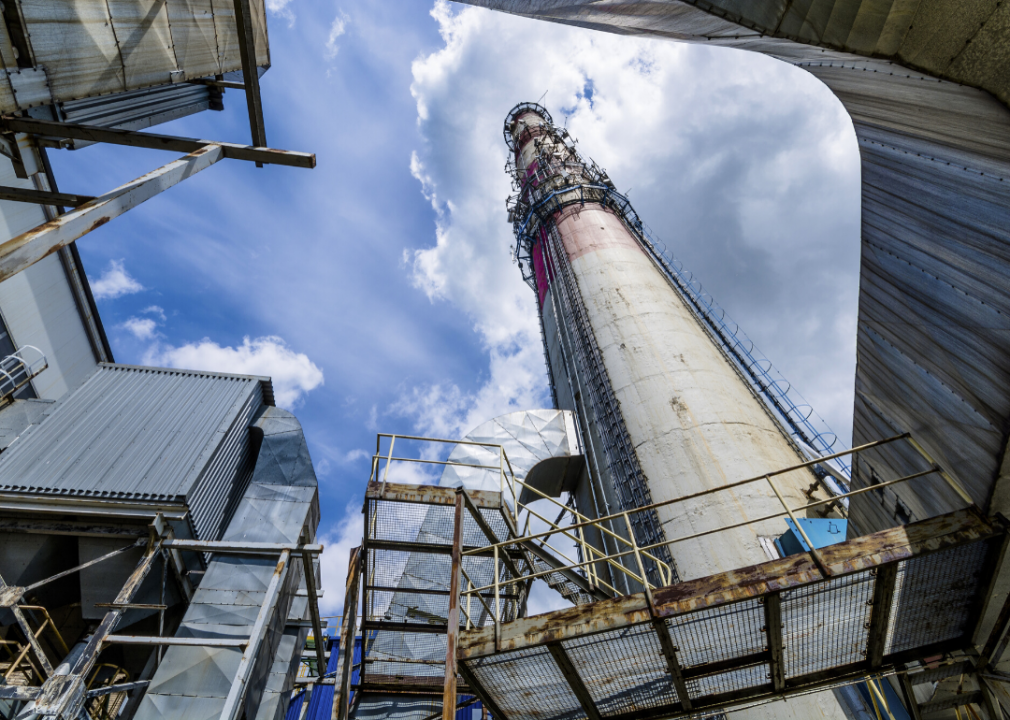
wawritto // Shutterstock
#53. Xstrata, Switzerland
- Contribution to atmospheric carbon dioxide rise, 1880–2010: 0.179 ppm (0.17% of total emissions)
- Contribution to global mean surface temperature rise: 0.001 C (0.12% of total rise, #52 highest contributor)
- Contribution to global sea level rise: 0.03 mm (0.02% of total rise, #71 highest contributor)
Xstrata, a Swiss multinational company that was said to be the largest exporter of thermal coal, was fully taken over by Glencore, a British-Swiss commodity trading and mining company in 2013. Glencore recognized the science behind climate change and would help to transition to a low carbon economy, and in 2019, was on track to reach the 5% reduction in GHG emission target set for 2020, according to its website. The Guardian's latest reporting suggests that Glencore's carbon footprint will shrink further by 2035 as it produces less coal.

Ken Wolter // Shutterstock
#52. Marathon, United States
- Contribution to atmospheric carbon dioxide rise, 1880–2010: 0.182 ppm (0.18% of total emissions)
- Contribution to global mean surface temperature rise: 0.0013 C (0.16% of total rise, #48 highest contributor)
- Contribution to global sea level rise: 0.22 mm (0.12% of total rise, #35 highest contributor)
Marathon Oil is a 130-year-old company that began operations in Ohio. Since 2011, it has been an independent exploration and production company based out of Houston. In its sustainability report, the company states it has reduced methane intensity by 31% from 2014 to 2018.
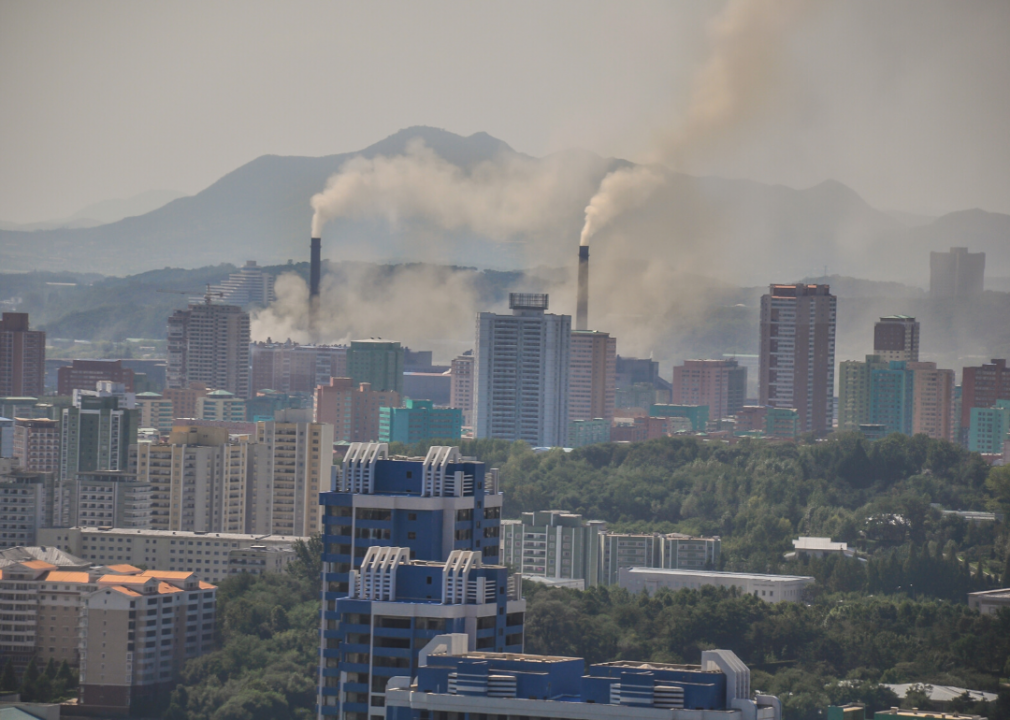
Saeschie Wagner // Shutterstock
#51. North Korea (government-owned company)
- Contribution to atmospheric carbon dioxide rise, 1880–2010: 0.186 ppm (0.18% of total emissions)
- Contribution to global mean surface temperature rise: 0.0013 C (0.16% of total rise, #48 highest contributor)
- Contribution to global sea level rise: 0.14 mm (0.08% of total rise, #43 highest contributor)
"Seven coal power plants and one oil-fired plant produce nearly 50% of North Korea's electricity," writes Jane Chung for Reuters. The country has also increased its domestic use of coal in the past two years, when North Korea is already fighting issues related to climate change such as declining availability of food, sea-level rise, and extreme weather patterns. North Korea has complied with the United Nations Framework Convention on Climate Change out of self-interest, and the government's expansion of coal use is said to be out of necessity and limited investment in infrastructure or access to low-emission technologies.
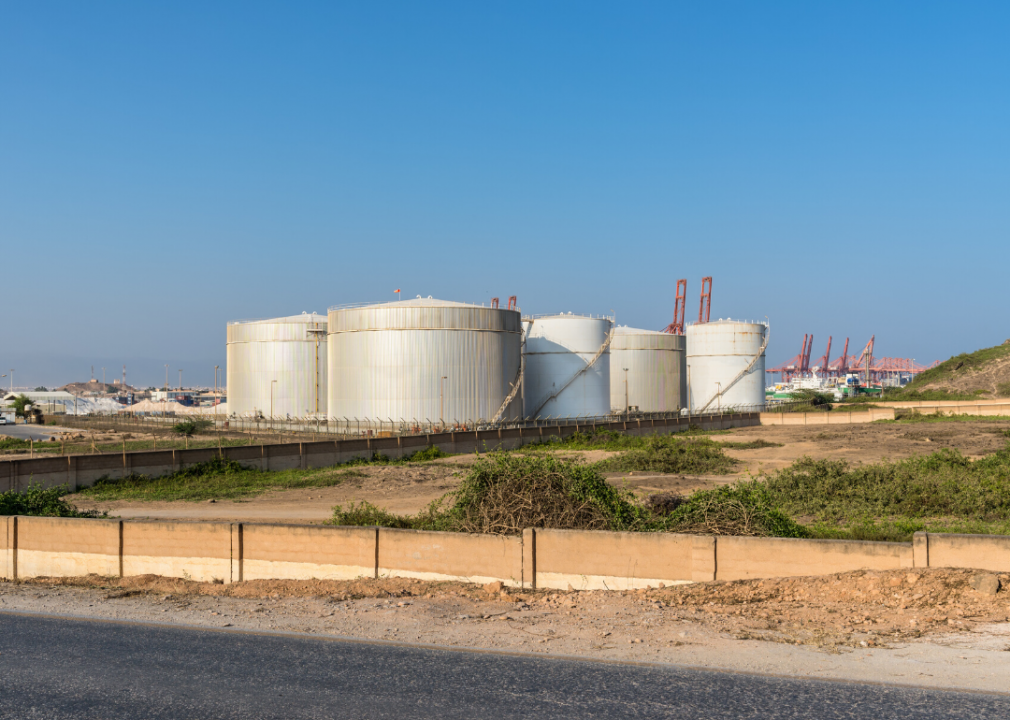
byvalet // Shutterstock
#50. Petroleum Development Oman, Oman
- Contribution to atmospheric carbon dioxide rise, 1880–2010: 0.187 ppm (0.18% of total emissions)
- Contribution to global mean surface temperature rise: 0.0012 C (0.15% of total rise, #51 highest contributor)
- Contribution to global sea level rise: 0.1 mm (0.06% of total rise, #51 highest contributor)
Petroleum Development Oman (PDO) is jointly owned by the Government of Oman, Royal Dutch Shell, Total, and Partex. In 2019, the company acknowledged the Middle East's acceptance of The Paris Agreement, and Raoul Restucci, PDO's managing director, stressed that it would launch a coordinated, multisectoral effort to adopt new technologies, reduce reliance on fossil fuel, and embrace renewable energy sources. The sultanate has set a target of meeting 30% of its energy demands by 2030 through the use of renewable energy sources.
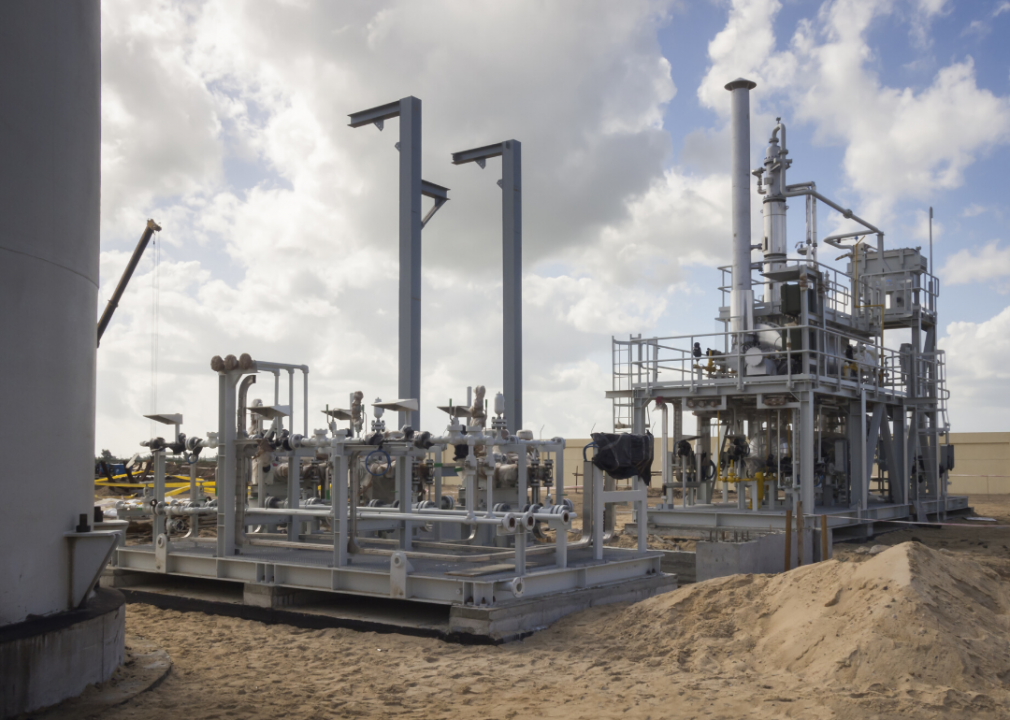
TomCarpenter // Shutterstock
#49. Egyptian General Petroleum Corporation, Egypt
- Contribution to atmospheric carbon dioxide rise, 1880–2010: 0.192 ppm (0.19% of total emissions)
- Contribution to global mean surface temperature rise: 0.0013 C (0.16% of total rise, #48 highest contributor)
- Contribution to global sea level rise: 0.11 mm (0.06% of total rise, #48 highest contributor)
Under the Egyptian Ministry of Petroleum, EGPC works in oil exploration, production, and export. Since the 1990s, the major focus has been to substitute oil with natural gas in energy generation and industrial use. In 2006, Egypt planned to move from resource-based low technology industries to more efficient medium- and high-technology industries, and according to a 2010 United Nations report, the country has put into place mitigation measures to replace traditional fuel with renewable sources of energy.
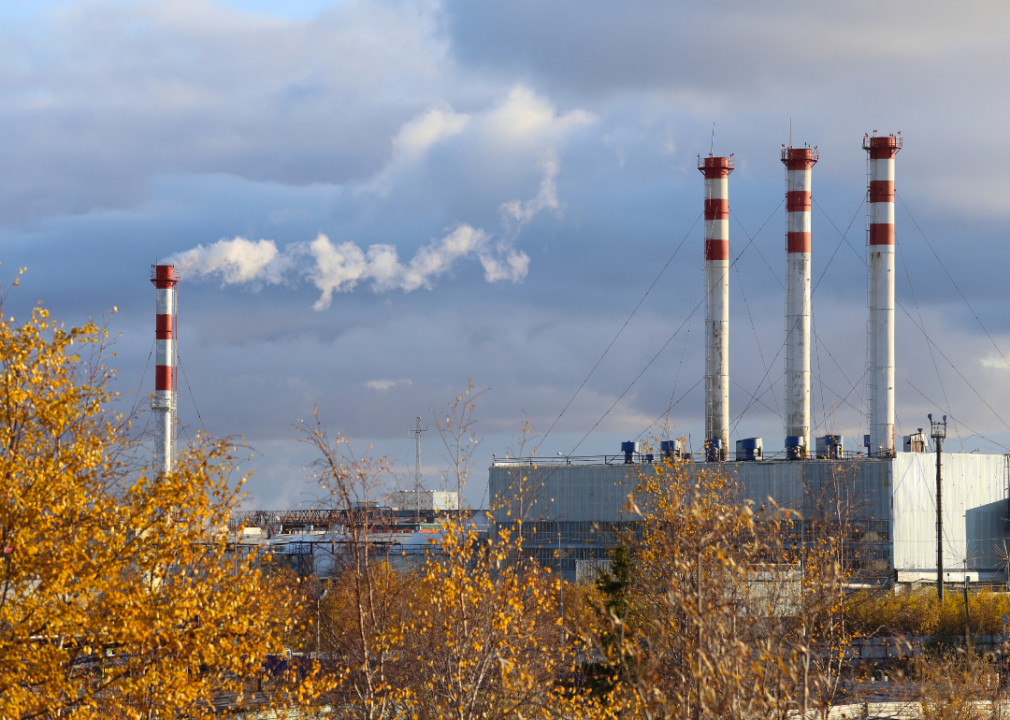
Grigorii Pisotsckii // Shutterstock
#48. Yukos, Russia
- Contribution to atmospheric carbon dioxide rise, 1880–2010: 0.203 ppm (0.20% of total emissions)
- Contribution to global mean surface temperature rise: 0.0014 C (0.18% of total rise, #47 highest contributor)
- Contribution to global sea level rise: 0.1 mm (0.05% of total rise, #51 highest contributor)
Yukos Oil company was based in Moscow until it went bankrupt and defunct in 2007.
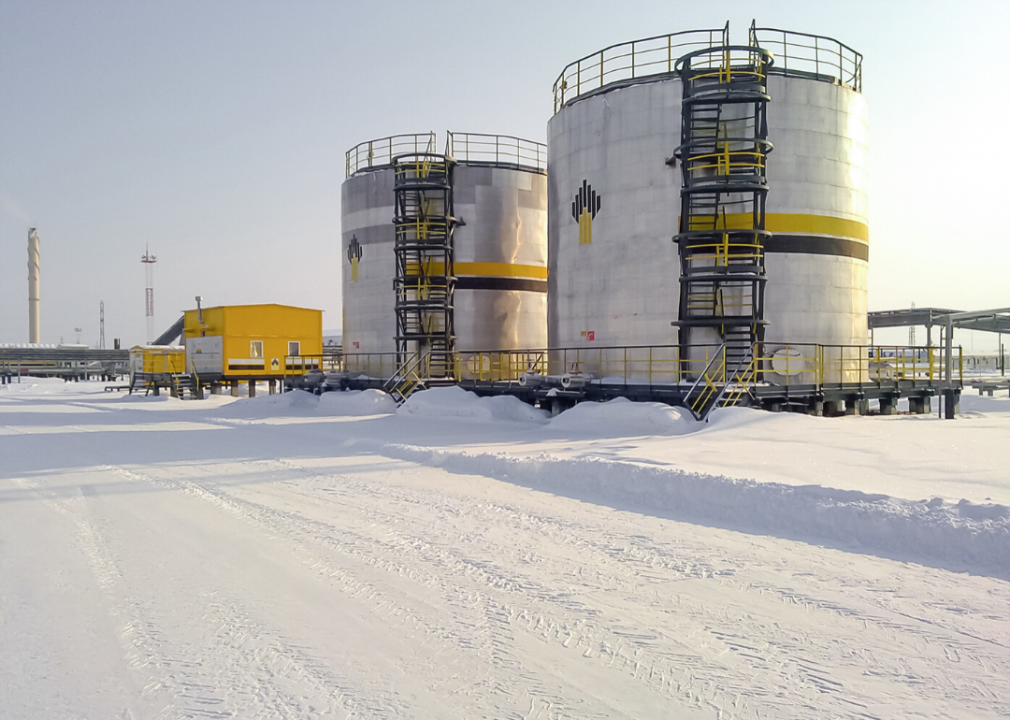
eleonimages // Shutterstock
#47. Rosneft, Russia
- Contribution to atmospheric carbon dioxide rise, 1880–2010: 0.225 ppm (0.22% of total emissions)
- Contribution to global mean surface temperature rise: 0.001 C (0.13% of total rise, #52 highest contributor)
- Contribution to global sea level rise: 0.04 mm (0.02% of total rise, #67 highest contributor)
Rosneft is a state-owned company and the largest public oil and gas corporation. It recently joined other global oil companies in the global CDP climate change rating, being assigned a B rating overall and an A rating for governance and emission reduction initiatives, by the nonprofit organization that evaluates companies for their environmental impact, strategies, and risk management activities related to climate change.
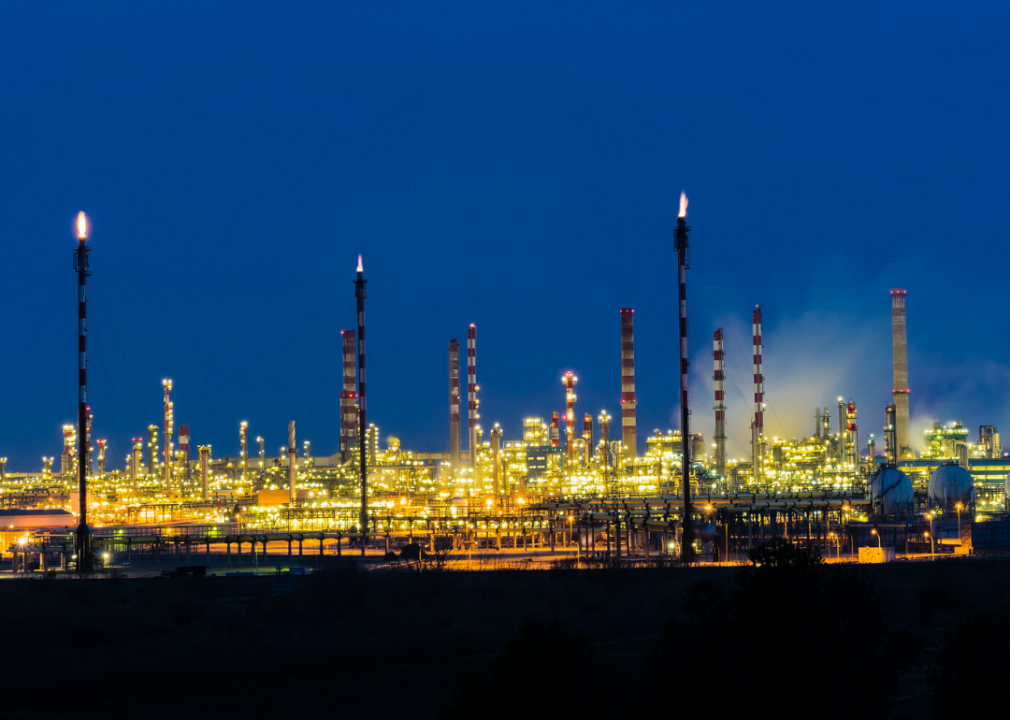
Xavi // Flickr
#46. Repsol, Spain
- Contribution to atmospheric carbon dioxide rise, 1880–2010: 0.238 ppm (0.23% of total emissions)
- Contribution to global mean surface temperature rise: 0.0016 C (0.20% of total rise, #44 highest contributor)
- Contribution to global sea level rise: 0.12 mm (0.07% of total rise, #46 highest contributor)
Based in Madrid, this oil company's website states that it aims to reduce CO2 equivalent emissions by 1.9 million tons between 2014 and 2020. This will be achieved through improving energy efficiency, increasing the use of natural gas, setting a global carbon price, and developing new technologies to capture, store, and use carbon dioxide.
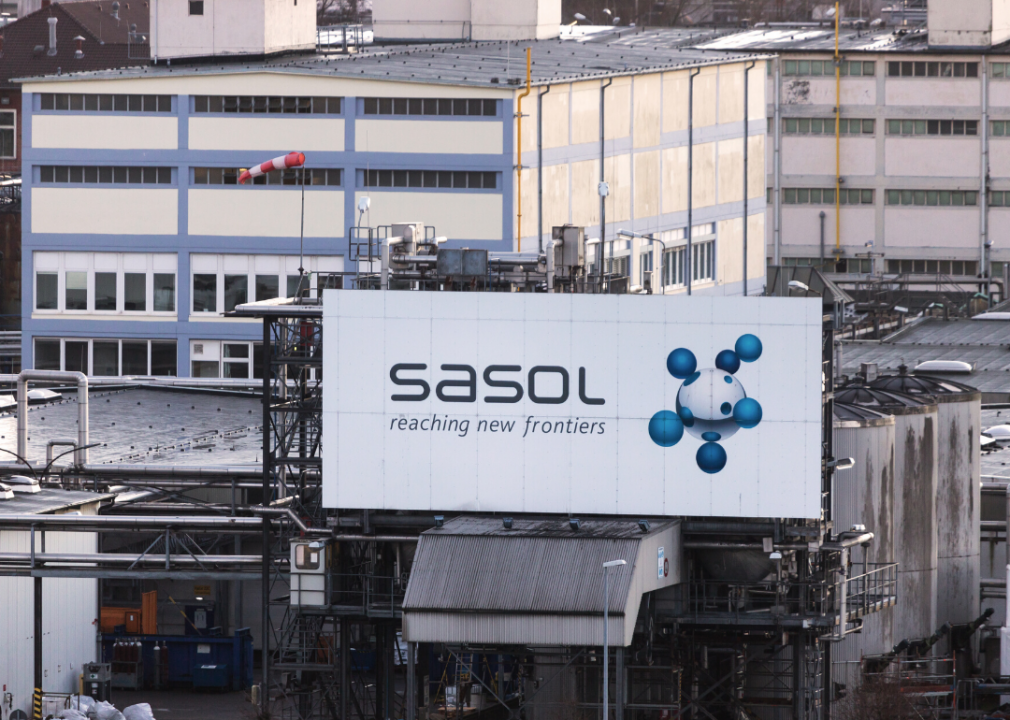
Tobias Arhelger // Shutterstock
#45. Sasol, South Africa
- Contribution to atmospheric carbon dioxide rise, 1880–2010: 0.239 ppm (0.23% of total emissions)
- Contribution to global mean surface temperature rise: 0.0017 C (0.21% of total rise, #42 highest contributor)
- Contribution to global sea level rise: 0.15 mm (0.09% of total rise, #41 highest contributor)
Sasol, an integrated energy and chemical company established in 1950, produces and commercializes technology for the production of chemicals, liquid fuels, and low-carbon electricity. Its GHG emissions decreased marginally to 67.4 million tons in 2018 from 67.6 million tons in 2017, according to its website, while emission intensity increased due to a decrease in production.
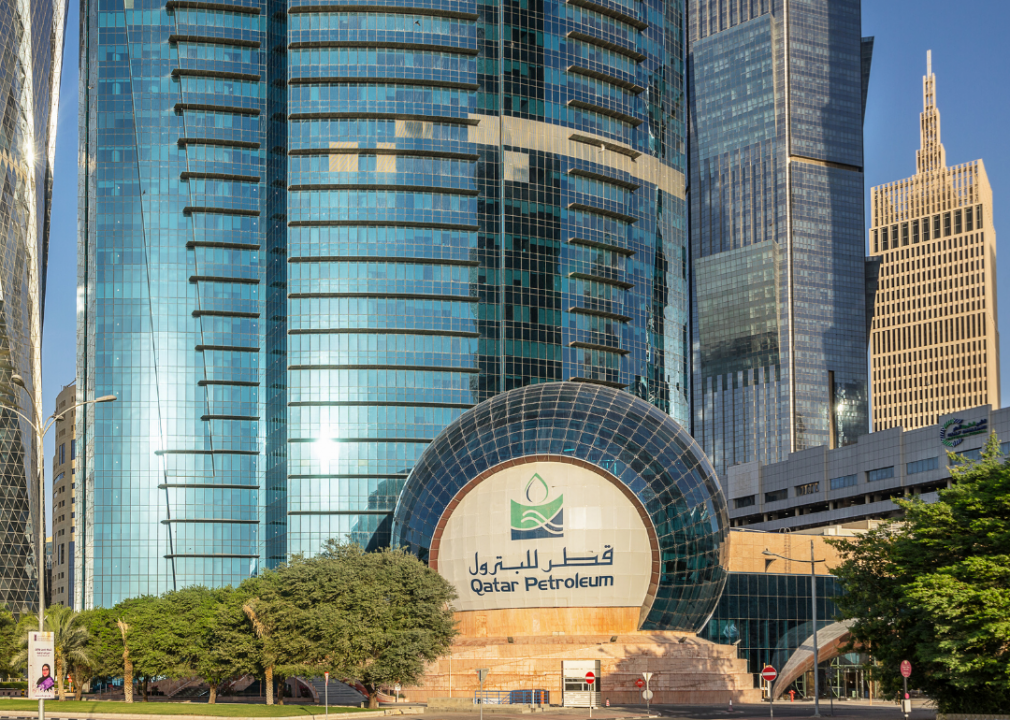
Gordon Bell // Shutterstock
#43. Qatar Petroleum, Qatar (tie)
- Contribution to atmospheric carbon dioxide rise, 1880–2010: 0.245 ppm (0.24% of total emissions)
- Contribution to global mean surface temperature rise: 0.0015 C (0.19% of total rise, #46 highest contributor)
- Contribution to global sea level rise: 0.11 mm (0.06% of total rise, #48 highest contributor)
The state-owned petroleum company is involved in oil and gas exploration and production. Its president and CEO said that the country's mitigation efforts should be viewed more broadly since it is meeting nearly one-third of the world's clean energy demands, and as Qatar's population is very small, its per capita CO2 emission gave an unrealistic picture. Two major programs have been implemented to reduce GHG emissions by eliminating normal gas flaring during operations and reducing emissions due to a leak in equipment.
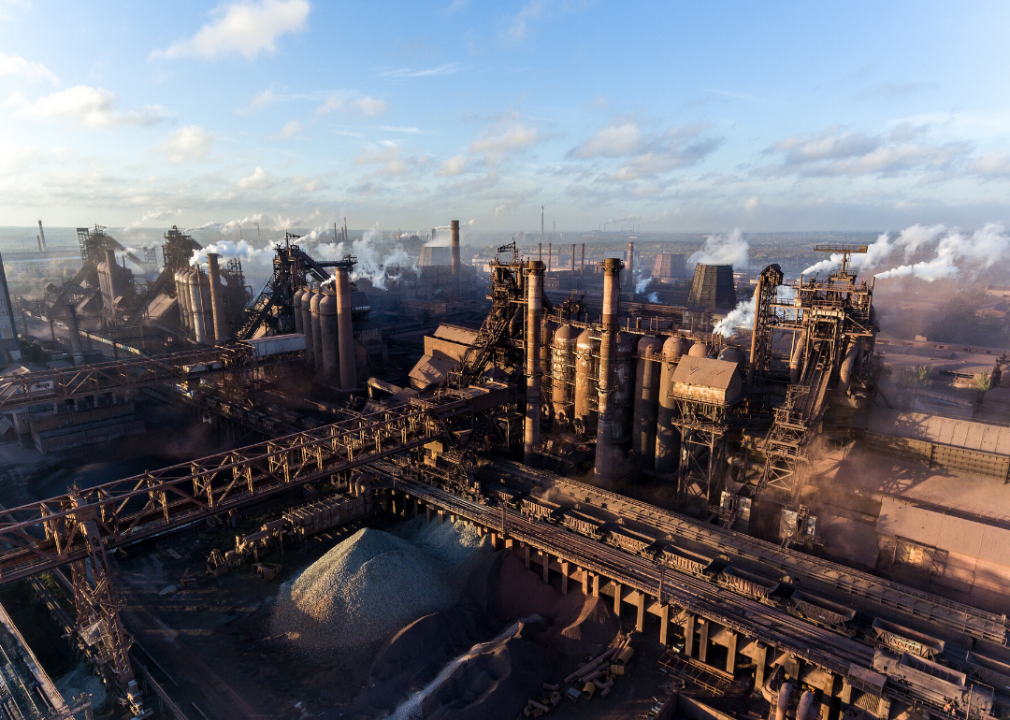
UBC Stock // Shutterstock
#43. Ukraine (tie) (government-owned company)
- Contribution to atmospheric carbon dioxide rise, 1880–2010: 0.245 ppm (0.24% of total emissions)
- Contribution to global mean surface temperature rise: 0.0016 C (0.20% of total rise, #44 highest contributor)
- Contribution to global sea level rise: 0.1 mm (0.05% of total rise, #51 highest contributor)
Ukraine has given itself a GHG emission target of 31-34% by 2050 as compared to the 1990 level, and based on the progress, there are plans to review this goal every five years. At the 2019 Conference of Parties to the United Nations Framework Convention on Climate Change, Ukraine announced the country's plan to pass two laws that obligate polluting industries to set up sensors to record their emissions, and taxation of fossil fuels by the state. The ultimate goal is to decrease the use of conventional energy sources.
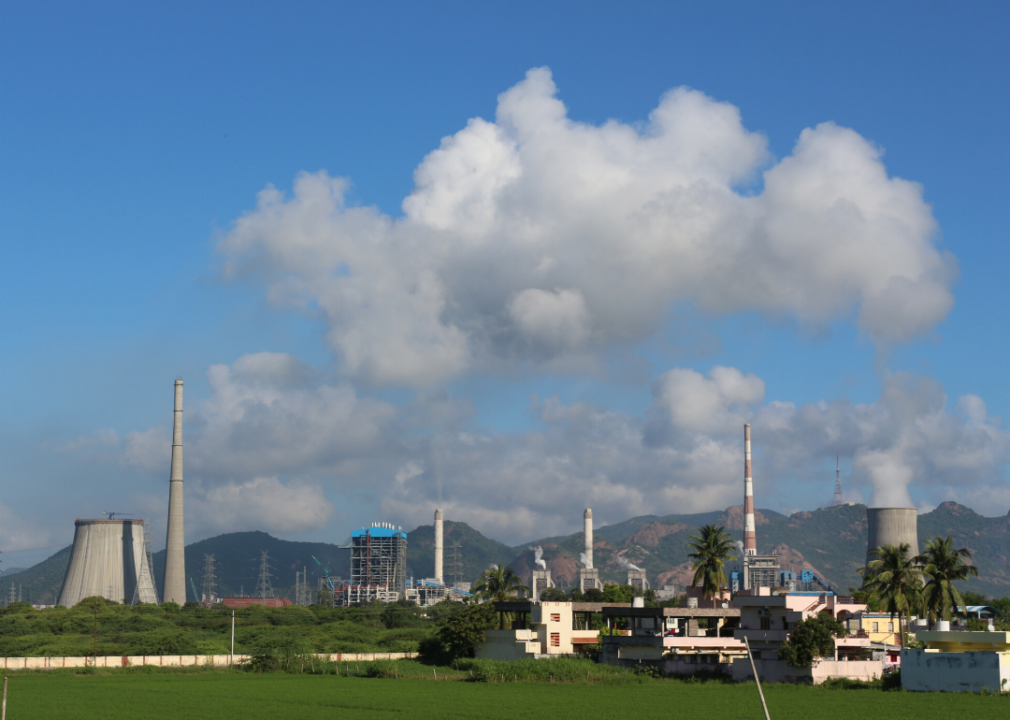
BABU JAKKULA // Shutterstock
#42. Oil and Natural Gas Corporation Limited, India
- Contribution to atmospheric carbon dioxide rise, 1880–2010: 0.285 ppm (0.28% of total emissions)
- Contribution to global mean surface temperature rise: 0.0019 C (0.24% of total rise, #41 highest contributor)
- Contribution to global sea level rise: 0.18 mm (0.10% of total rise, #38 highest contributor)
ONGC is India's largest crude oil and natural gas company, and the only public sector company in India to be listed in Fortune's Most Admired Energy Companies list. It has a dedicated carbon management and sustainability group and is working to reduce fugitive methane emissions from oil and natural gas systems. It also wants to reduce the overall carbon footprint by creating an organization-wide inventory of where direct and indirect energy consumption can be reduced.
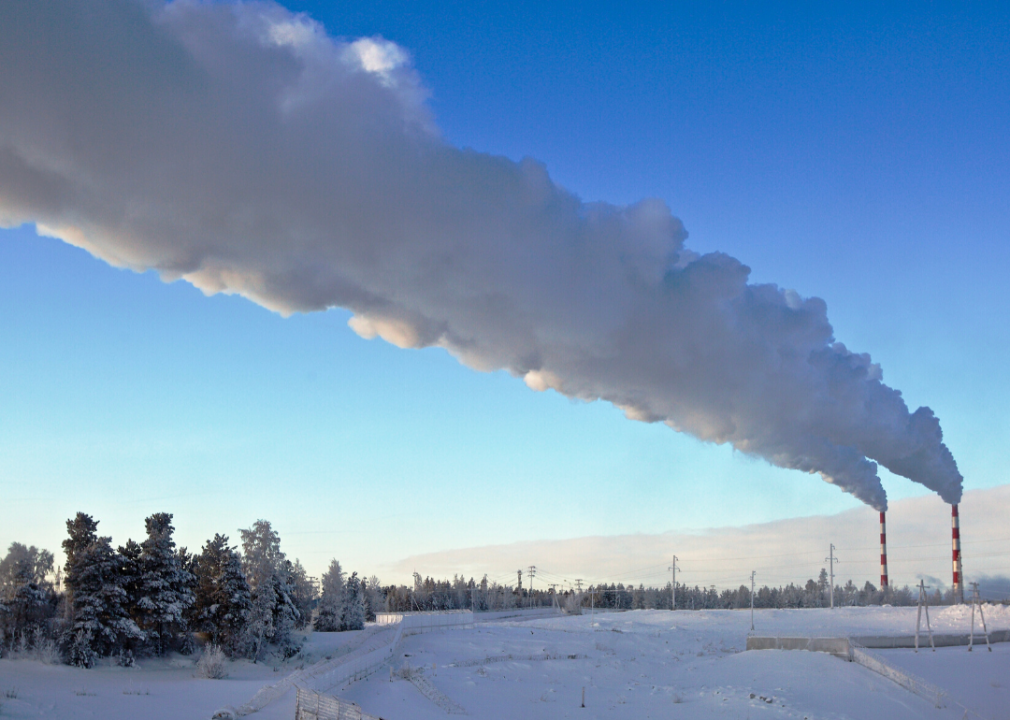
Nata Naumovec // Shutterstock
#41. Occidental, United States
- Contribution to atmospheric carbon dioxide rise, 1880–2010: 0.311 ppm (0.30% of total emissions)
- Contribution to global mean surface temperature rise: 0.0022 C (0.27% of total rise, #38 highest contributor)
- Contribution to global sea level rise: 0.37 mm (0.21% of total rise, #27 highest contributor)
A leading oil and natural gas company, Occidental operates in the United States, Middle East, Latin America, and Africa. It is the first U.S. company to endorse the World Bank's initiative of zero routine flaring by 2030. The company is an industry leader in carbon dioxide-enhanced oil recovery and carbon capture, utilization, and storage technologies that reduce GHG emissions yet still grow business.
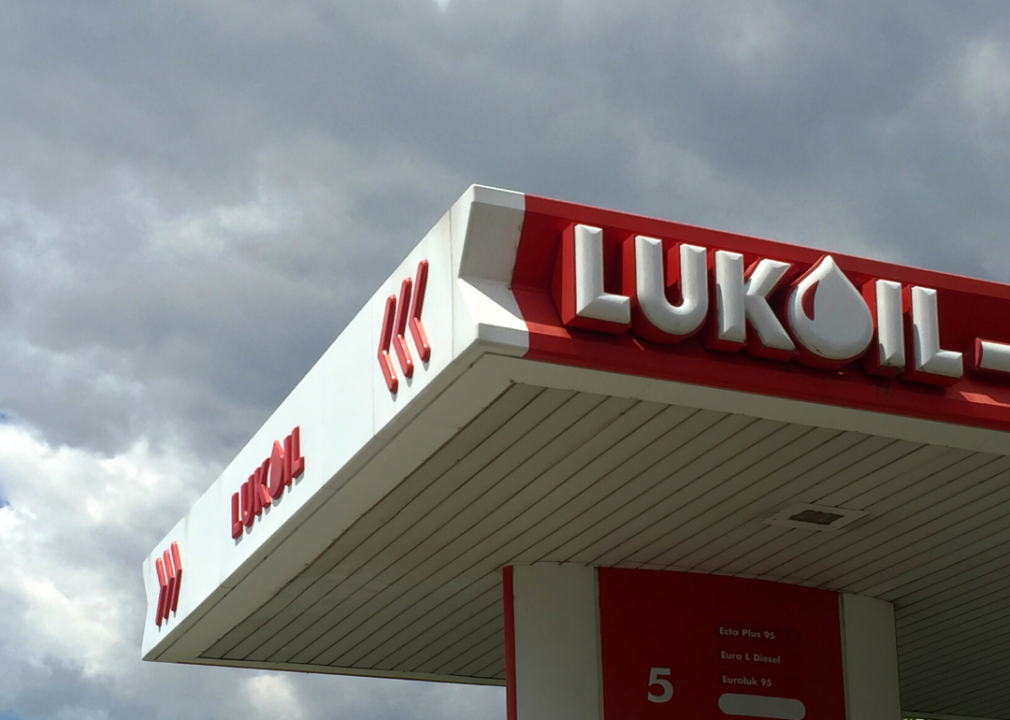
Adriana Iacob // Shutterstock
#40. Lukoil, Russia
- Contribution to atmospheric carbon dioxide rise, 1880–2010: 0.313 ppm (0.30% of total emissions)
- Contribution to global mean surface temperature rise: 0.0017 C (0.21% of total rise, #42 highest contributor)
- Contribution to global sea level rise: 0.06 mm (0.03% of total rise, #57 highest contributor)
Based in Moscow, Lukoil is one of the world's largest producers of crude oil, operating in 30 countries across four continents. According to its 2018 Impact Assessment report, the company's total direct GHG emissions in 2017 were 0.5% less than that in 2016. Lukoil says it is making continuous improvements in its corporate systems to track and manage GHGs.
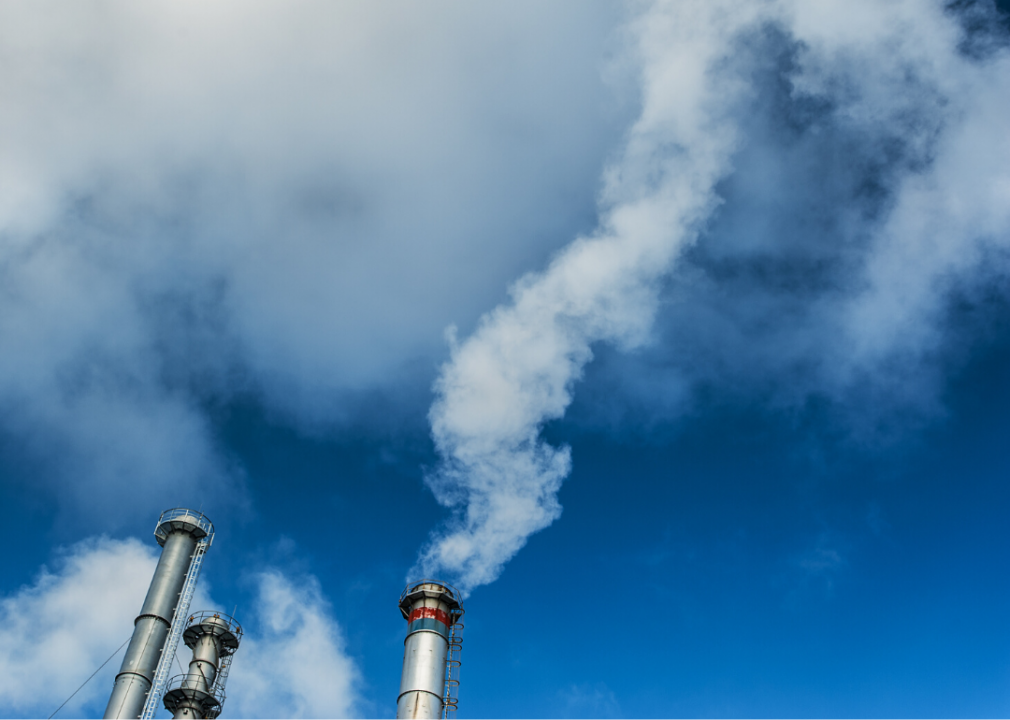
Calin Tatu // Shutterstock
#38. Anadarko, United States (tie)
- Contribution to atmospheric carbon dioxide rise, 1880–2010: 0.322 ppm (0.31% of total emissions)
- Contribution to global mean surface temperature rise: 0.0024 C (0.30% of total rise, #37 highest contributor)
- Contribution to global sea level rise: 0.33 mm (0.19% of total rise, #29 highest contributor)
Anadarko Petroleum Corporation, based in Texas, purchased Kerr-McGee in 2005, another oil company that had been dumping toxic waste in areas across many states. In 2014, the company paid more than $5 billion to clean up the sites in the largest environmental settlement in U.S. history. Anadarko had been disclosing its GHG records to CDP until 2018 and was acquired by Occidental in 2019.
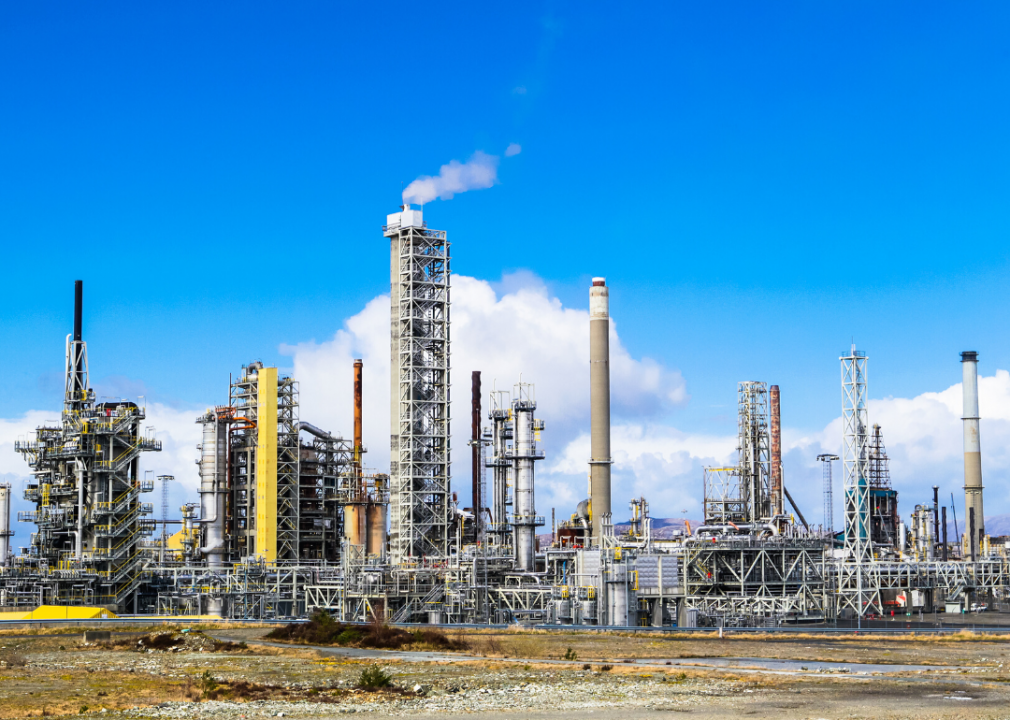
Marius Dobilas // Shutterstock
#38. Statoil, Norway (tie)
- Contribution to atmospheric carbon dioxide rise, 1880–2010: 0.322 ppm (0.31% of total emissions)
- Contribution to global mean surface temperature rise: 0.002 C (0.25% of total rise, #40 highest contributor)
- Contribution to global sea level rise: 0.12 mm (0.07% of total rise, #46 highest contributor)
One of the largest companies in the Nordic countries, state-backed Statoil changed its name to Equinor in 2018 to reflect its commitment to clean energy and removing the "oil" from the name. The company's goal is to reduce net carbon intensity by at least 50% by 2050. Eldar Sætre, Equinor's president and CEO, said: "As part of the energy industry, we must be part of the solution to combat climate change and address decarbonization more broadly in line with changes in society."
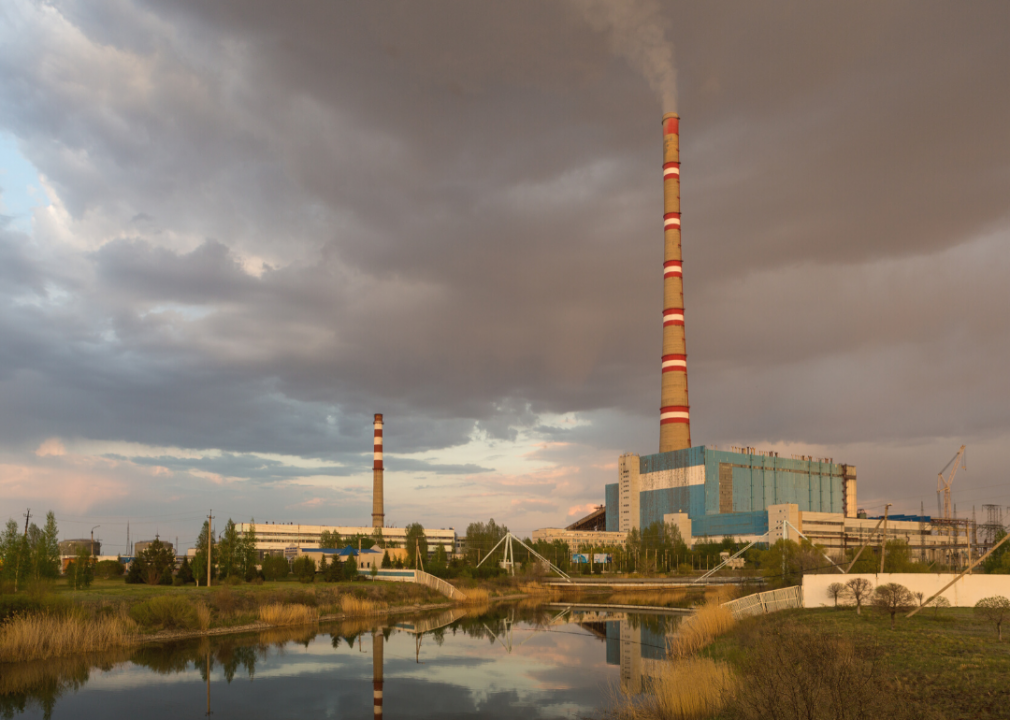
Olga Gordeeva // Shutterstock
#37. Kazakhstan (government-owned company)
- Contribution to atmospheric carbon dioxide rise, 1880–2010: 0.33 ppm (0.32% of total emissions)
- Contribution to global mean surface temperature rise: 0.0021 C (0.26% of total rise, #39 highest contributor)
- Contribution to global sea level rise: 0.11 mm (0.06% of total rise, #48 highest contributor)
Kazakhstan is heavily dependent on coal-based electricity and the extraction of fossil fuels for its energy needs. In 2018, the country saw a 2C rise in temperature—higher than the global average. The United States Agency for International Development has been working with the government to help move it toward renewable energy sources and improve energy efficiency, and the country has passed various laws to reduce emissions, including an emission trading system.
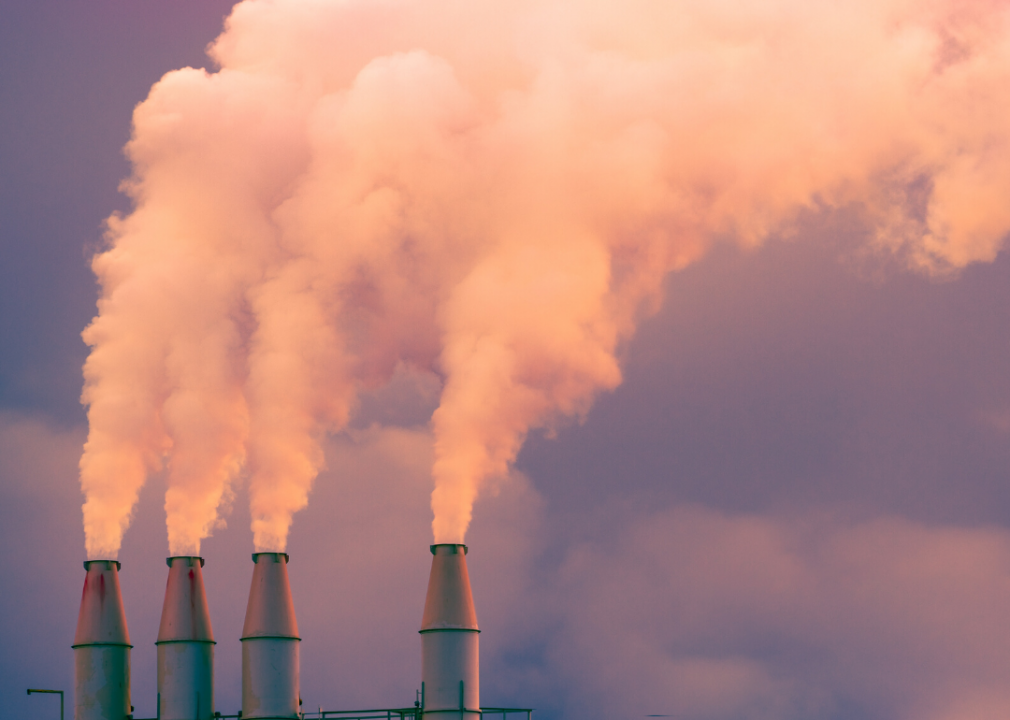
Sundry Photography // Shutterstock
#36. PETRONAS (Petroliam Nasional Berhad), Malaysia
- Contribution to atmospheric carbon dioxide rise, 1880–2010: 0.371 ppm (0.36% of total emissions)
- Contribution to global mean surface temperature rise: 0.0025 C (0.31% of total rise, #36 highest contributor)
- Contribution to global sea level rise: 0.18 mm (0.10% of total rise, #38 highest contributor)
A Fortune Global 500 corporation, this large oil and gas company's 2018 Sustainability Report says that efforts to monitor CO2 emissions began in 2012, and the company has reduced them by 10.07 million metric tons through 2017. The momentum continued through 2018 with a further reduction of 1.54 million metric tons of CO2 emissions due to concerted efforts in reducing flaring and venting in the upstream business, both in Malaysia and international operations. The mitigation measures taken include promoting natural gas use, minimizing flaring, reducing methane emission in operations, improving energy, and efficiency.
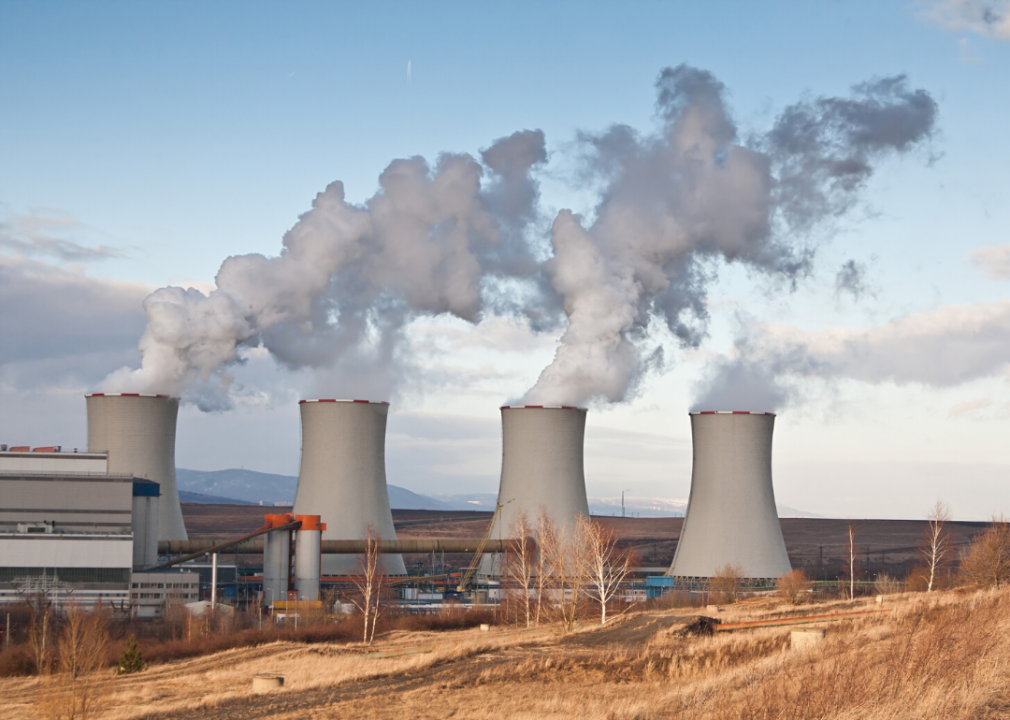
Vera Kailova // Shutterstock
#35. Czechoslovakia (government-owned company)
- Contribution to atmospheric carbon dioxide rise, 1880–2010: 0.397 ppm (0.39% of total emissions)
- Contribution to global mean surface temperature rise: 0.003 C (0.38% of total rise, #28 highest contributor)
- Contribution to global sea level rise: 0.73 mm (0.41% of total rise, #16 highest contributor)
Czechoslovakia separated into the two countries of Slovakia and the Czech Republic (Czechia) in 1993. According to the Organisation for Economic Co-operation and Development (OECD) in its Environmental Performance Review of 2018, the Czech Republic is heavily dependent on fossil fuels and one of the most carbon-intensive economies among all OECD member countries. OECD indicates that the economic destructuring in Slovakia after the separation resulted in significant drops in emission and the country could achieve its reduction goal as set under the Kyoto Protocol for 2008–2012.
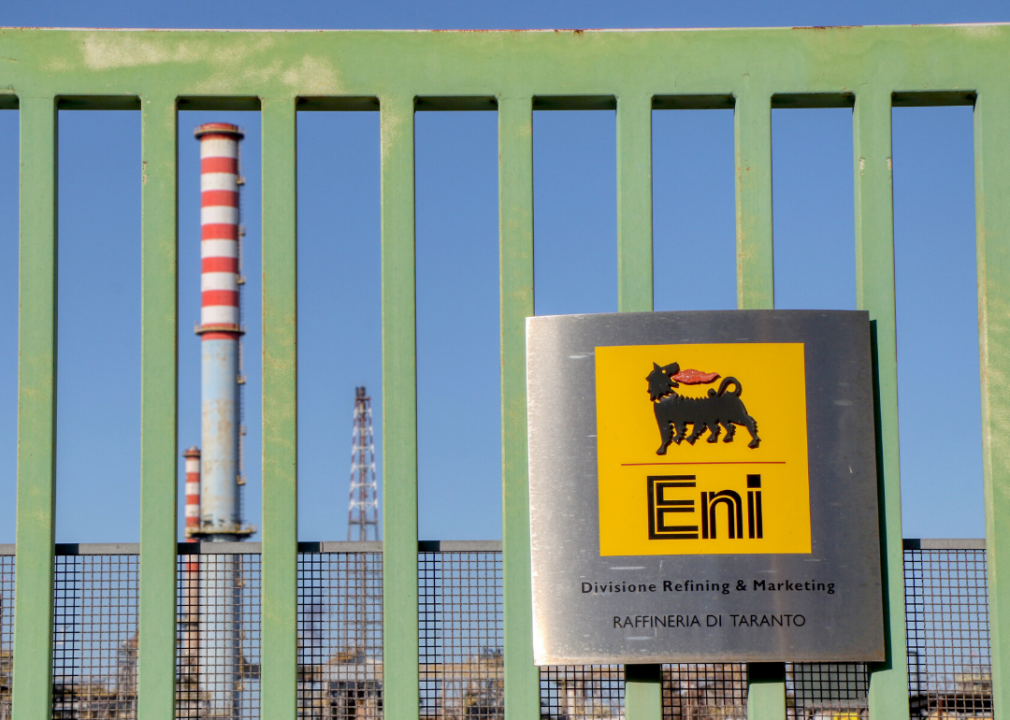
Massimo Todaro // Shutterstock
#34. ENI, Italy
- Contribution to atmospheric carbon dioxide rise, 1880–2010: 0.404 ppm (0.39% of total emissions)
- Contribution to global mean surface temperature rise: 0.0027 C (0.34% of total rise, #33 highest contributor)
- Contribution to global sea level rise: 0.28 mm (0.16% of total rise, #31 highest contributor)
Eni is involved in the exploration and production of oil, gas, chemicals, and electricity. The company has pledged to cut its net carbon emissions to zero by 2030, and it also plans to plant forests to capture over 20 million metric tons of carbon dioxide emission by 2030. The company will be investing 1.4 billion euros throughout the next few years on renewable energy, especially solar reports Reuters.
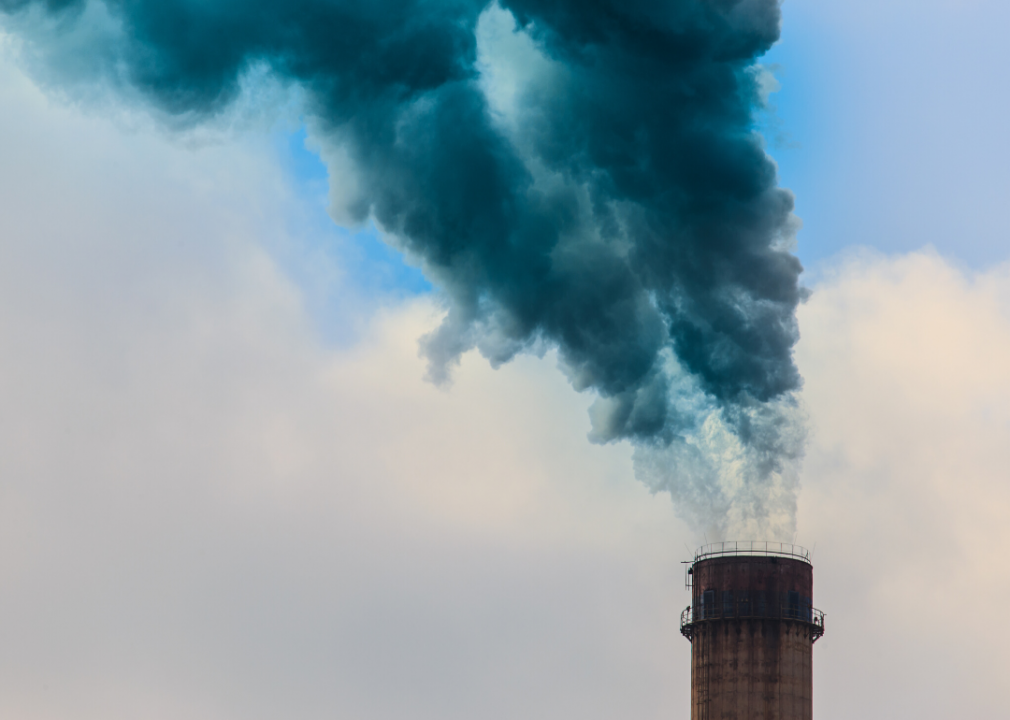
Calin Tatu // Shutterstock
#33. Arch Coal Inc., United States
- Contribution to atmospheric carbon dioxide rise, 1880–2010: 0.423 ppm (0.41% of total emissions)
- Contribution to global mean surface temperature rise: 0.0027 C (0.34% of total rise, #33 highest contributor)
- Contribution to global sea level rise: 0.19 mm (0.11% of total rise, #37 highest contributor)
The second-largest producer of coal in the United States contributes to 16% of the country's coal supply, and the Missouri-based company's website states that while the use of coal tripled in the U.S. between 1970 and 2009, emission of criteria air pollutants declined by 67%. It also claims that emission rates of sulfur dioxide, nitrogen oxide, particulate matter, and mercury continue to decline. In 2016, a report published in The Wall Street Journal revealed that Arch Coal had gifted $10,000 to a Washington, D.C.-based legal group known for filing lawsuits against climate scientists, and in 2017, the company faced bankruptcy but was approved for a restructuring process.
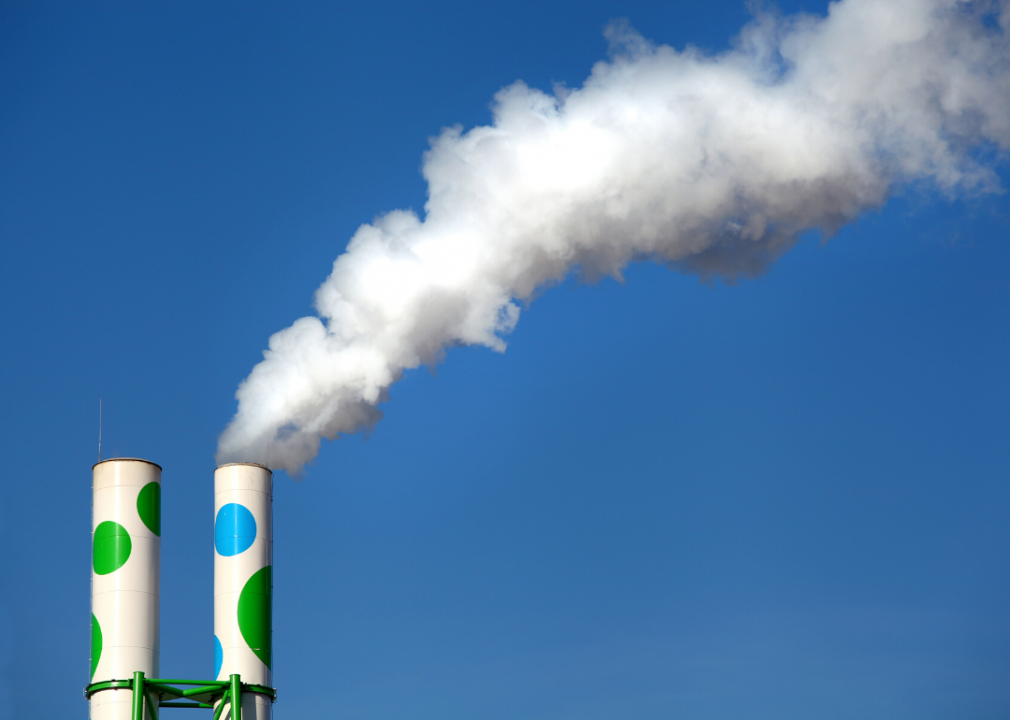
Gyvafoto // Shutterstock
#32. Pertamina, Indonesia
- Contribution to atmospheric carbon dioxide rise, 1880–2010: 0.429 ppm (0.42% of total emissions)
- Contribution to global mean surface temperature rise: 0.0032 C (0.40% of total rise, #25 highest contributor)
- Contribution to global sea level rise: 0.41 mm (0.23% of total rise, #22 highest contributor)
Jakarta-based Pertamina is the second-largest crude oil producer in Indonesia, and a state-owned oil and natural gas corporation. The company was created in 1968 by the merger of Pertamin and Permina. Indonesia committed to reducing GHG emissions by 26% by 2020, and in response, Pertamina developed a Clean Energy Mechanism initiative in 2017 that is working on the reduction of emissions.
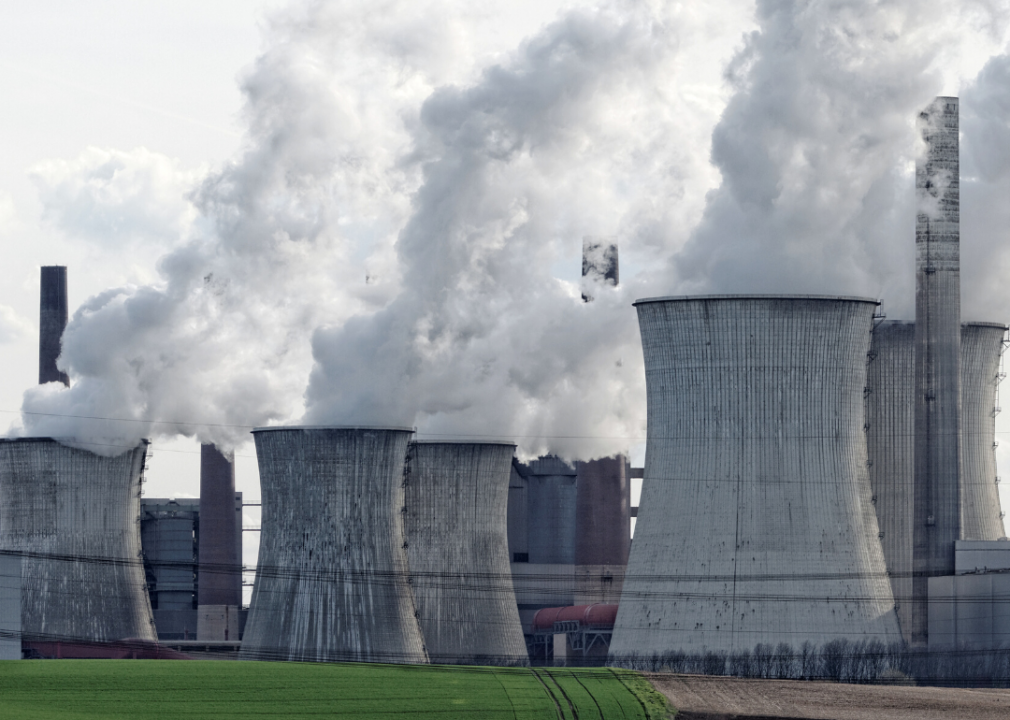
gerd-harder // Shutterstock
#31. RWE, Germany
- Contribution to atmospheric carbon dioxide rise, 1880–2010: 0.432 ppm (0.42% of total emissions)
- Contribution to global mean surface temperature rise: 0.003 C (0.38% of total rise, #28 highest contributor)
- Contribution to global sea level rise: 0.43 mm (0.24% of total rise, #21 highest contributor)
RWE (RWE AG, or Rheinisch-Westfälisches Elektrizitätswerk AG) is an energy company based in Germany. The company has redefined itself in recent years to significantly reduce its own carbon emissions and secure a sustainable future while meeting growing electricity demands. The company has set a goal to be carbon-neutral by 2040 with clean, secure, and affordable energy.
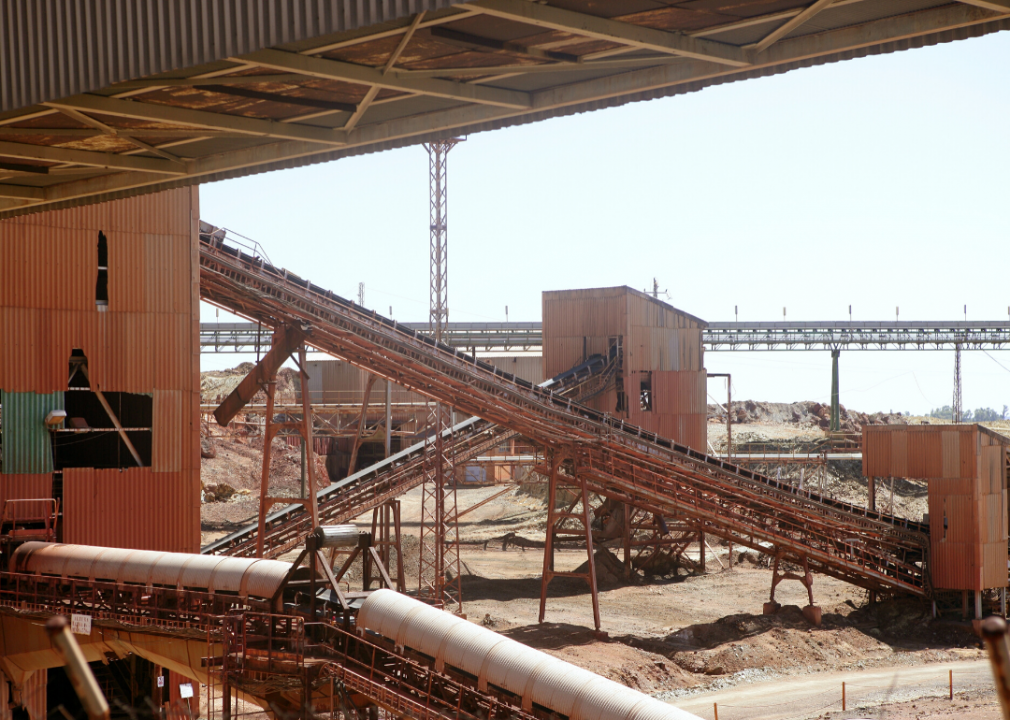
lunamarina // Shutterstock
#30. Rio Tinto, United Kingdom
- Contribution to atmospheric carbon dioxide rise, 1880–2010: 0.439 ppm (0.43% of total emissions)
- Contribution to global mean surface temperature rise: 0.0028 C (0.35% of total rise, #32 highest contributor)
- Contribution to global sea level rise: 0.18 mm (0.10% of total rise, #38 highest contributor)
A London-based mining and metal company operating in 35 countries, Rio Tinto mines iron ore, copper, diamond, titanium, and borates. The company has publicly acknowledged climate change and has resolved to move toward a low-carbon future. Its latest climate change statistics state that the company has a 30% emission intensity reduction since 2008, 43% GHG emission reduction since 2008, and 71% use of renewable energy resources.
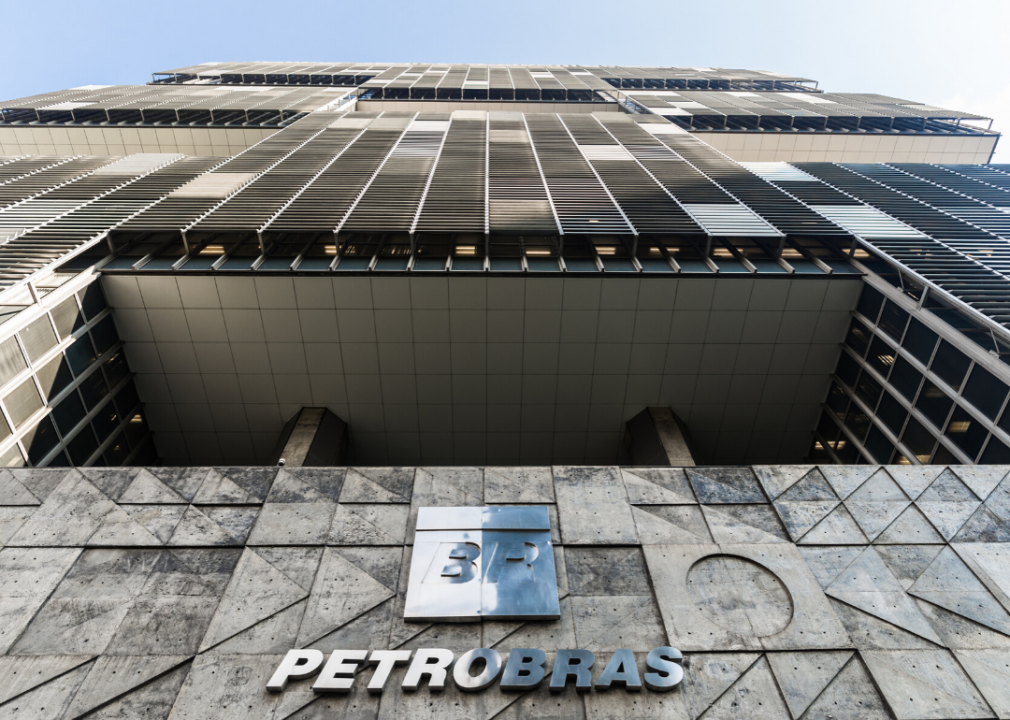
Alexandr Vorobev // Shutterstock
#29. Petróleo Brasileiro (Petrobras), Brazil
- Contribution to atmospheric carbon dioxide rise, 1880–2010: 0.443 ppm (0.43% of total emissions)
- Contribution to global mean surface temperature rise: 0.0026 C (0.33% of total rise, #35 highest contributor)
- Contribution to global sea level rise: 0.2 mm (0.11% of total rise, #36 highest contributor)
Petrobras is a Brazilian-based integrated energy company focusing on oil and gas. In 2018, the company's total GHG emissions were down 8%, and in its new strategic plan, Petrobras has also committed to focusing on natural gas and renewable energy solutions. But at the same time, the company has been reported to be investing heavily in fossil fuels with a goal of an almost 30% increase in oil production by 2024.
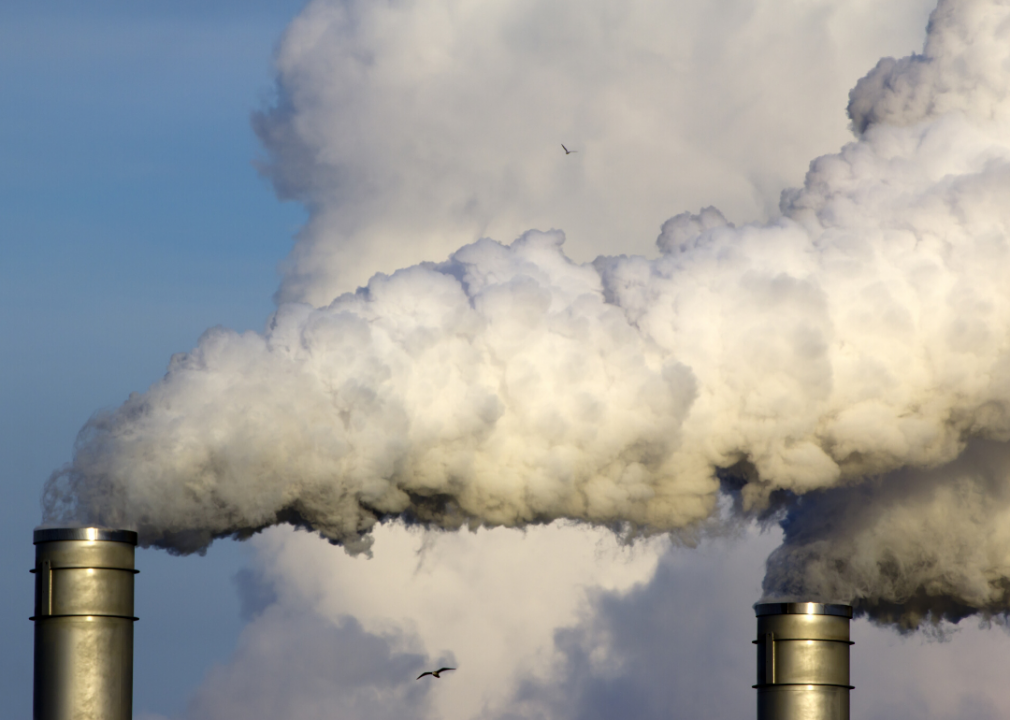
corlaffra // Shutterstock
#28. National Oil Corp., Libya
- Contribution to atmospheric carbon dioxide rise, 1880–2010: 0.452 ppm (0.44% of total emissions)
- Contribution to global mean surface temperature rise: 0.0029 C (0.36% of total rise, #30 highest contributor)
- Contribution to global sea level rise: 0.35 mm (0.20% of total rise, #28 highest contributor)
The National Oil Corporation of Libya dominates the country's oil industry with 70% of the oil output. However, because of the civil war and Libya's east-based forces choking off oil and the natural gas supply, the company is struggling to maintain its output and is currently at just 400,000 barrels per day, reports Financial Times.
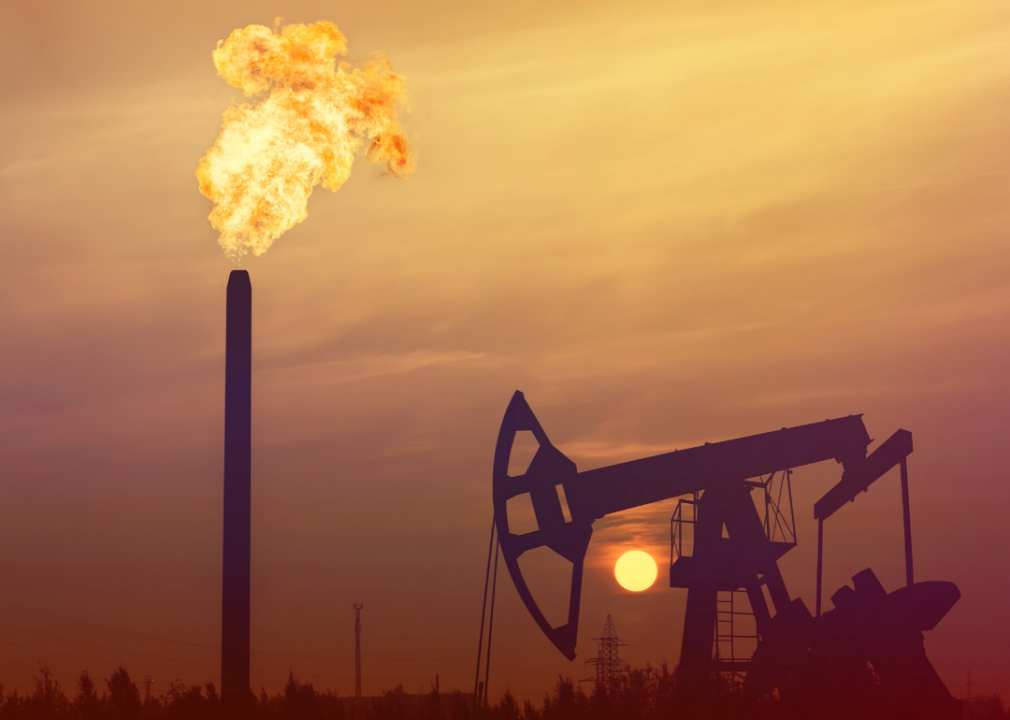
Leonid Ikan // Shutterstock
#27. Nigerian National Petroleum Corp., Nigeria
- Contribution to atmospheric carbon dioxide rise, 1880–2010: 0.46 ppm (0.45% of total emissions)
- Contribution to global mean surface temperature rise: 0.0029 C (0.36% of total rise, #30 highest contributor)
- Contribution to global sea level rise: 0.27 mm (0.15% of total rise, #34 highest contributor)
The federal government of Nigeria, Africa's largest oil-producing country with an economy heavily dependent on fossil fuels, uses this oil corporation to explore and produce petroleum. The Nigerian government, under the 2015 Paris Agreement, promised to cut back on emissions and be net-zero by the second half of the century. It is reducing gas flaring operations, looking for renewable energy sources like wind and solar, and has set itself a target of emission cuts by 45% by 2030, from 2010 to 2014 levels.
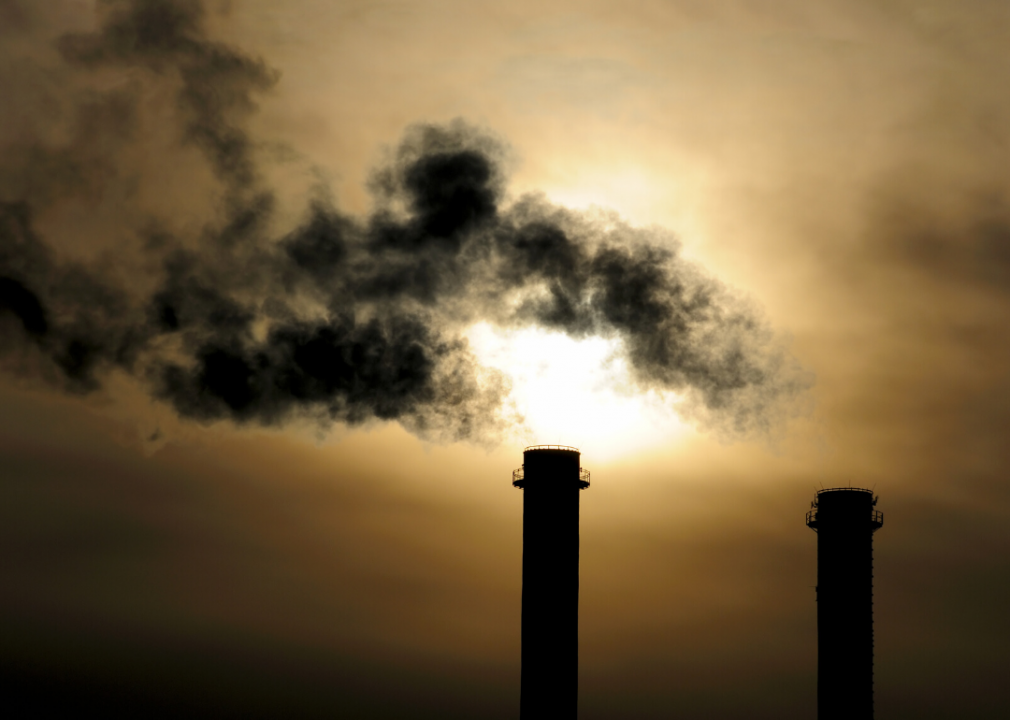
miamia // Shutterstock
#26. Iraq National Oil Co., Iraq
- Contribution to atmospheric carbon dioxide rise, 1880–2010: 0.475 ppm (0.46% of total emissions)
- Contribution to global mean surface temperature rise: 0.0031 C (0.38% of total rise, #27 highest contributor)
- Contribution to global sea level rise: 0.41 mm (0.23% of total rise, #22 highest contributor)
Founded in 1966 by the Iraqi government, the Iraq National Oil Co. (INOC) operates all aspects of the oil industry except refining. In 1987, Saddam Hussain had divided INOC into nine different companies with independent powers. Currently, the INOC still functions, but the country is struggling to decide whether the former companies should be merged, and plans related to the oil and gas sector remain status quo, especially in terms of a climate mitigation agenda.
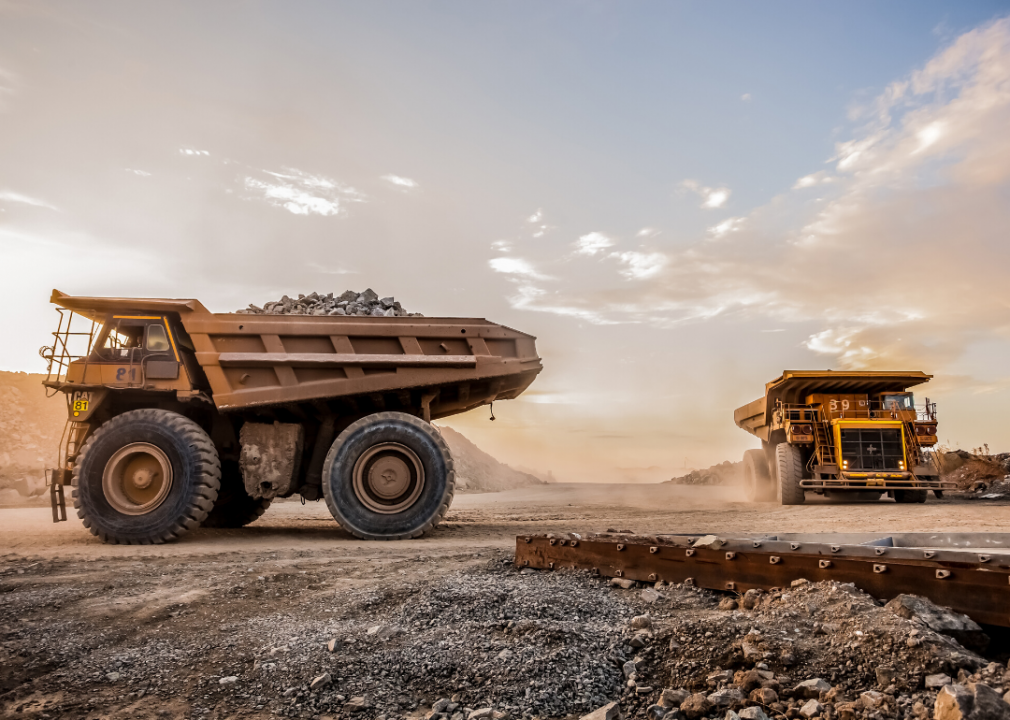
Sunshine Seeds // Shutterstock
#25. Anglo American, United Kingdom
- Contribution to atmospheric carbon dioxide rise, 1880–2010: 0.475 ppm (0.46% of total emissions)
- Contribution to global mean surface temperature rise: 0.0032 C (0.40% of total rise, #25 highest contributor)
- Contribution to global sea level rise: 0.41 mm (0.23% of total rise, #22 highest contributor)
A global mining company based in Johannesburg, South Africa, and London, the group mines copper, nickel, iron, platinum, and diamonds. Through De Beers, it is producing about one-third of the world's diamonds. The company has introduced a new initiative called FutureSmart Mining, an innovation-led approach to finding safer, more efficient, and sustainable solutions to help limit global warming.
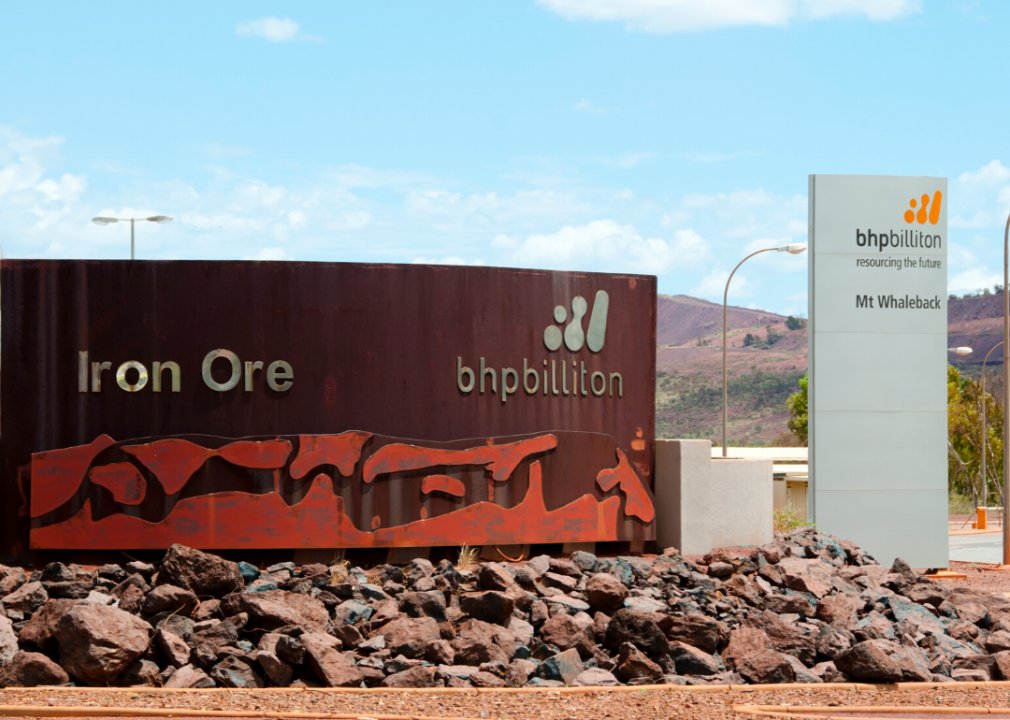
Adwo // Shutterstock
#24. BHP Billiton Ltd., Australia
- Contribution to atmospheric carbon dioxide rise, 1880–2010: 0.538 ppm (0.52% of total emissions)
- Contribution to global mean surface temperature rise: 0.0036 C (0.44% of total rise, #24 highest contributor)
- Contribution to global sea level rise: 0.28 mm (0.16% of total rise, #31 highest contributor)
BHP, based in Melbourne, extracts and processes minerals, oils, and gases. In 2001, it merged with Billiton, a British company that was established in 1860 to mine tin in Indonesia. The current company announced in 2019 that it would invest $400 million to address climate change, and it was ready to sell its thermal coal assets to shift to a low-carbon economy, as reported in Financial Times.
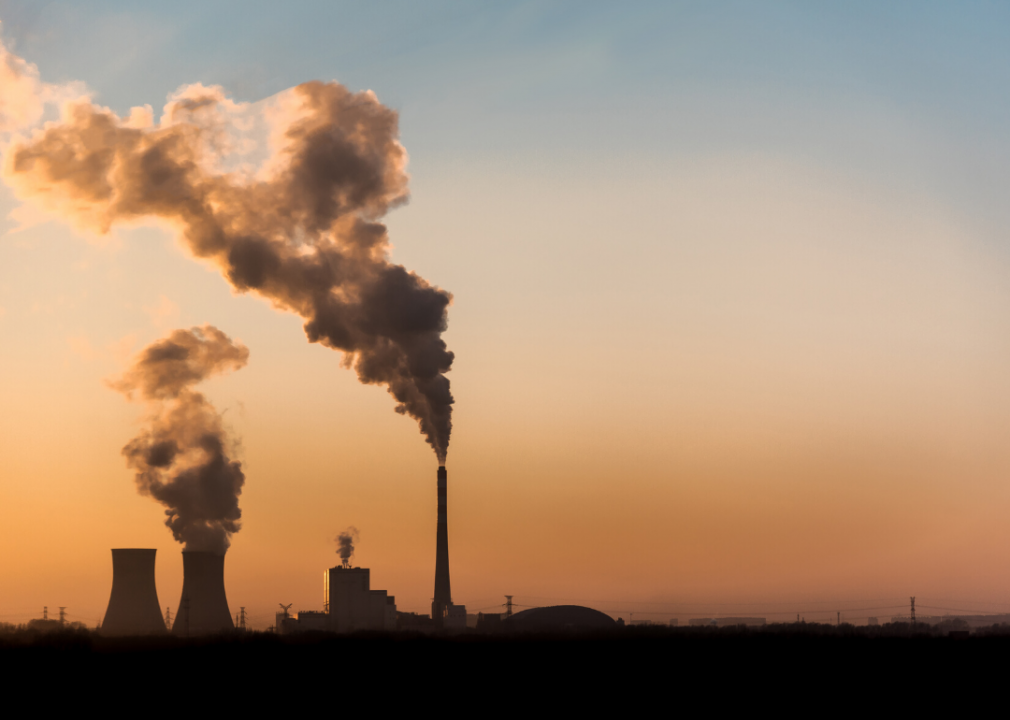
GG6369 // Shutterstock
#23. Consol Energy, United States
- Contribution to atmospheric carbon dioxide rise, 1880–2010: 0.541 ppm (0.53% of total emissions)
- Contribution to global mean surface temperature rise: 0.0039 C (0.49% of total rise, #23 highest contributor)
- Contribution to global sea level rise: 0.75 mm (0.43% of total rise, #14 highest contributor)
Established in 1860, Pennsylvania-based Consol is the leading producer of bituminous coal and the largest underground coal company in the United States. In 2018, the company's direct emission intensity improved by 2% because of new methane destruction technology. The company, in its climate sustainability report of 2019, also states that because of the use of Enel X's Energy Intelligence Software, it has reduced its indirect scope 2 emissions by 45% as compared to 2015 levels.
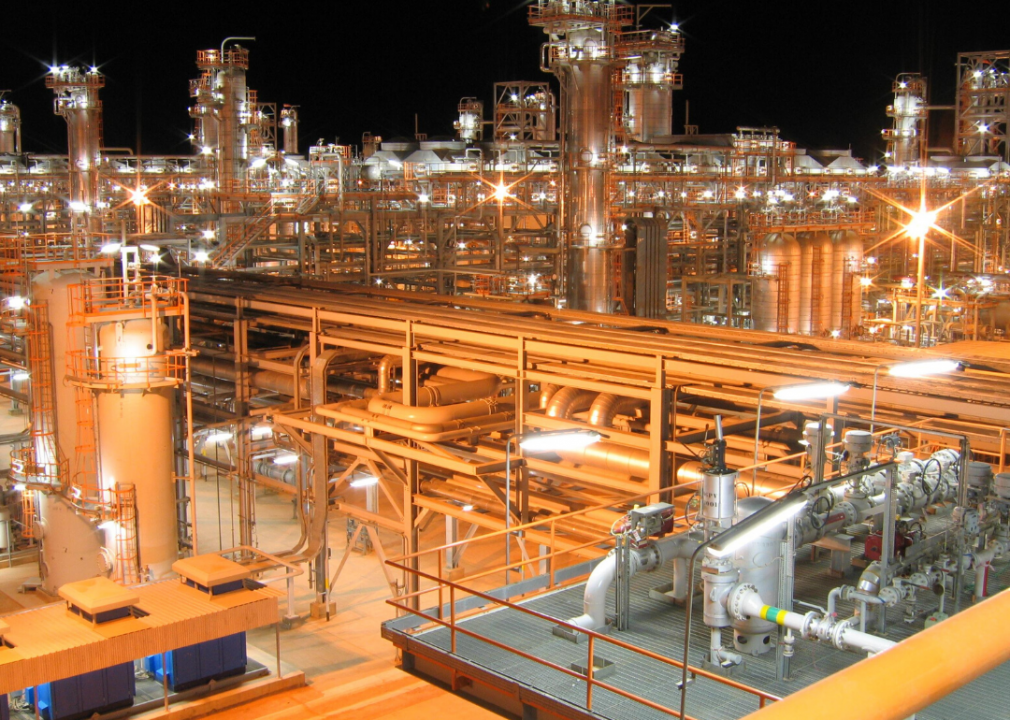
TOUAT Hamid // Shutterstock
#22. Sonatrach, Algeria
- Contribution to atmospheric carbon dioxide rise, 1880–2010: 0.629 ppm (0.61% of total emissions)
- Contribution to global mean surface temperature rise: 0.0044 C (0.54% of total rise, #21 highest contributor)
- Contribution to global sea level rise: 0.4 mm (0.22% of total rise, #25 highest contributor)
This state-owned Algerian oil company was set up in 1963 and accounts for 98% of the country's foreign exchange earnings. It endorsed the World Bank's Zero Routine Flaring by 2030 initiative. Algeria also has initiated many measures of mitigation, which include CO2 sequestration, expanding forest areas, and improving water resources by sea water desalination.

Marco Curaba // Shutterstock
#21. Abu Dhabi National Oil Co., United Arab Emirates
- Contribution to atmospheric carbon dioxide rise, 1880–2010: 0.686 ppm (0.67% of total emissions)
- Contribution to global mean surface temperature rise: 0.0044 C (0.55% of total rise, #21 highest contributor)
- Contribution to global sea level rise: 0.38 mm (0.21% of total rise, #26 highest contributor)
The ADNOC is one of the world's leading energy producers and the 12th largest oil producer. Under the United Nations Framework Convention on Climate Change, the UAE is a non-annex 1 country and not obligated to reduce its emissions; however, the country has voluntarily taken up initiatives to reduce carbon emissions and expand the role of low-carbon technologies as well as renewable energy use. The country plans to generate 24% of its electricity from clean energy sources by 2021.
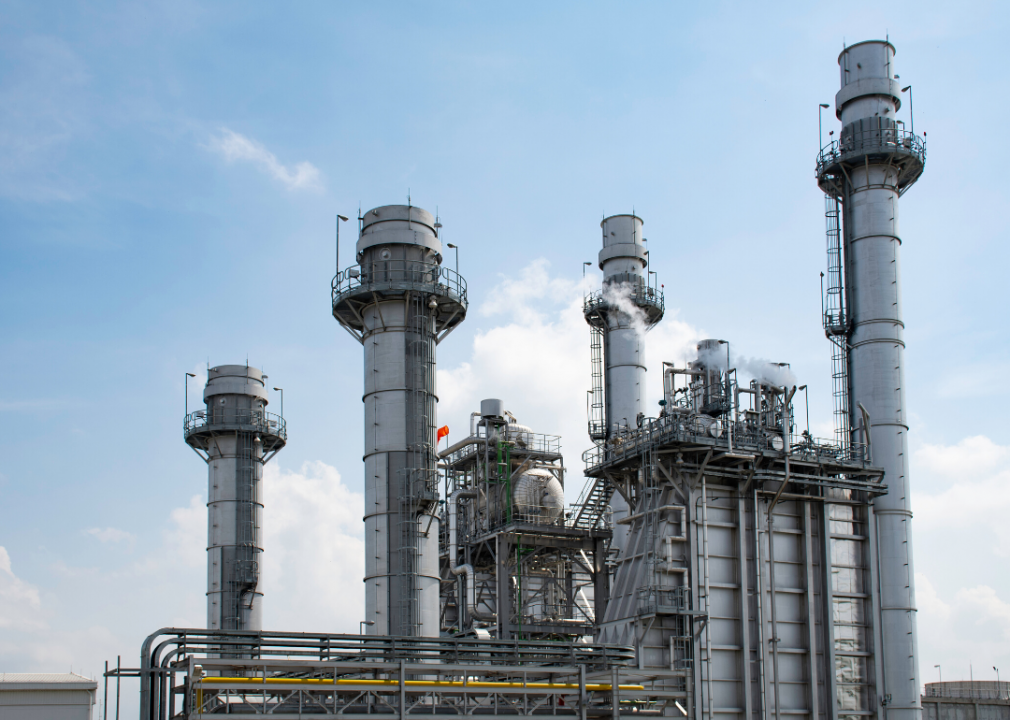
MR.ANUT PHIVTONG // Shutterstock
#20. Kuwait Petroleum Corp., Kuwait
- Contribution to atmospheric carbon dioxide rise, 1880–2010: 0.717 ppm (0.70% of total emissions)
- Contribution to global mean surface temperature rise: 0.0046 C (0.57% of total rise, #20 highest contributor)
- Contribution to global sea level rise: 0.54 mm (0.30% of total rise, #20 highest contributor)
KPC was formed in 1980 as a state-owned oil corporation that took all the oil companies under one umbrella. The company had a long-standing goal of reaching 4 million barrels of daily capacity by 2020, according to Al Jazeera, but for the first time, it reduced its goal to 3.125 million barrels with increasing concerns for climate change and reducing the use of fossil fuels. Such a change is a rare acknowledgment of environmental issues by an OPEC country.
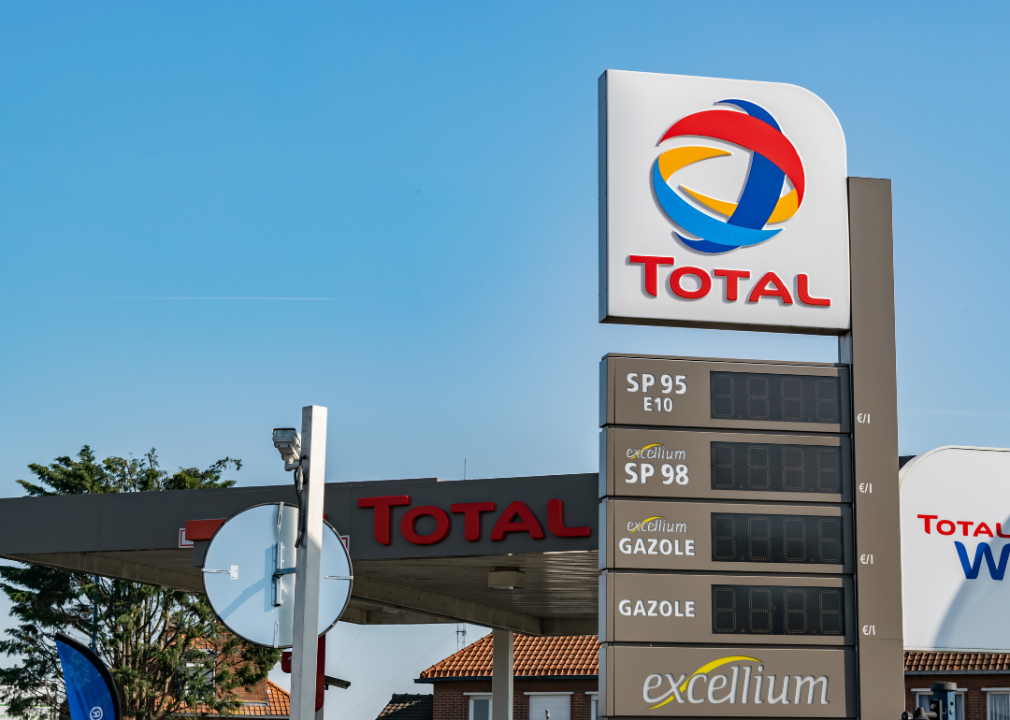
mimpki // Shutterstock
#19. Total SA, France
- Contribution to atmospheric carbon dioxide rise, 1880–2010: 0.78 ppm (0.76% of total emissions)
- Contribution to global mean surface temperature rise: 0.0053 C (0.66% of total rise, #17 highest contributor)
- Contribution to global sea level rise: 0.73 mm (0.41% of total rise, #16 highest contributor)
Total is an integrated oil and natural gas company founded in 1924 that was sued in January 2020 for climate inaction by 14 French cities and non-governmental organizations. They felt that despite being responsible for 1% of the world's CO2 emissions, the company was not doing enough to mitigate the crisis. Total says it has revved up activities to fight climate change through five initiatives—enhancing energy efficiency, growing in natural gas, using low-carbon efficient activities, investing in carbon storage, and promoting biofuels.
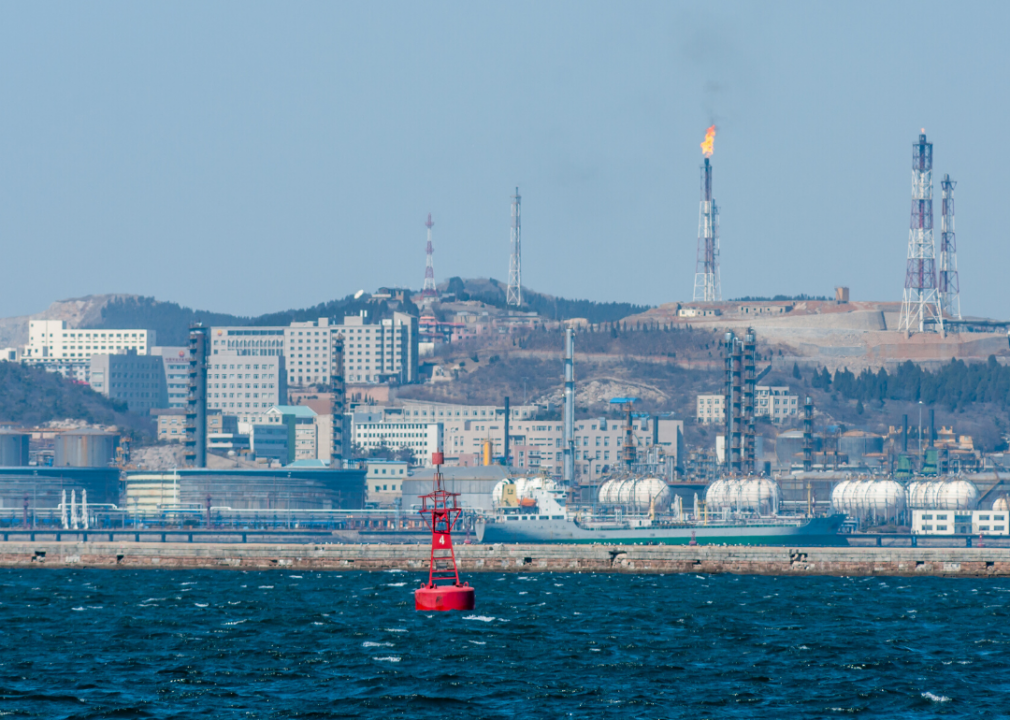
Uwe Aranas // Shutterstock
#18. PetroChina, China
- Contribution to atmospheric carbon dioxide rise, 1880–2010: 0.783 ppm (0.76% of total emissions)
- Contribution to global mean surface temperature rise: 0.0048 C (0.60% of total rise, #19 highest contributor)
- Contribution to global sea level rise: 0.3 mm (0.17% of total rise, #30 highest contributor)
PetroChina is a state-owned Chinese petroleum corporation headquartered in Beijing, and is Asia's largest oil producer. In its latest report, the company states that, by 2020, it aims "to reduce CO2 emissions per unit of industrial value-added by 25% compared with 2015, and strive to stop GHG emissions from increasing in refining and chemical business." The company also wants to increase the supply of natural gas so it accounts for 55% of the company's primary energy.
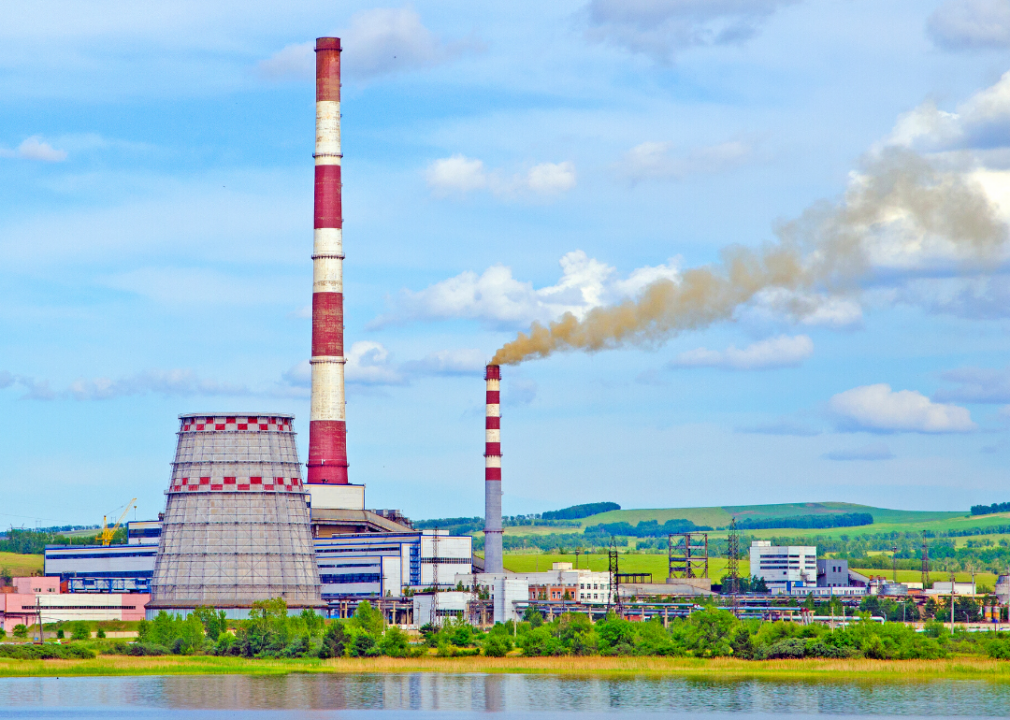
Beyger // Shutterstock
#17. Russian Federation (not including the Former Soviet Union) (government-owned company)
- Contribution to atmospheric carbon dioxide rise, 1880–2010: 0.837 ppm (0.81% of total emissions)
- Contribution to global mean surface temperature rise: 0.0053 C (0.66% of total rise, #17 highest contributor)
- Contribution to global sea level rise: 0.28 mm (0.16% of total rise, #31 highest contributor)
Russia is warming 2.5 times faster than the planet as a whole, and recently supported the ratification of the Paris Agreement with a target of 25-30% less GHG emission by 2030. The Russian Federation has shielded away from any state measures to decarbonize, and in late 2019, the government made a U-turn by cancelling a draft climate law that supported carbon-cutting projects and had legally binding targets and sanctions. On the other hand, in January 2020, the government released a plan to adapt its economy and population to climate change.

Philip Rozenski // Shutterstock
#16. Peabody Energy, United States
- Contribution to atmospheric carbon dioxide rise, 1880–2010: 0.847 ppm (0.82% of total emissions)
- Contribution to global mean surface temperature rise: 0.0056 C (0.69% of total rise, #16 highest contributor)
- Contribution to global sea level rise: 0.59 mm (0.34% of total rise, #18 highest contributor)
Headquartered in Missouri, Peabody is a Fortune 500 company working in mining, sales, and distribution of coal that is primarily used for electricity generation and steelmaking. The company's bankruptcy filing in 2016 revealed how it had funded dozens of groups questioning climate change. At present, the company website has a statement on climate change that does not point to any specific emission reduction targets but gives a general directive addressing the issue and how in the coal sector the company is helping by funding research in key initiatives such as low-emission projects.
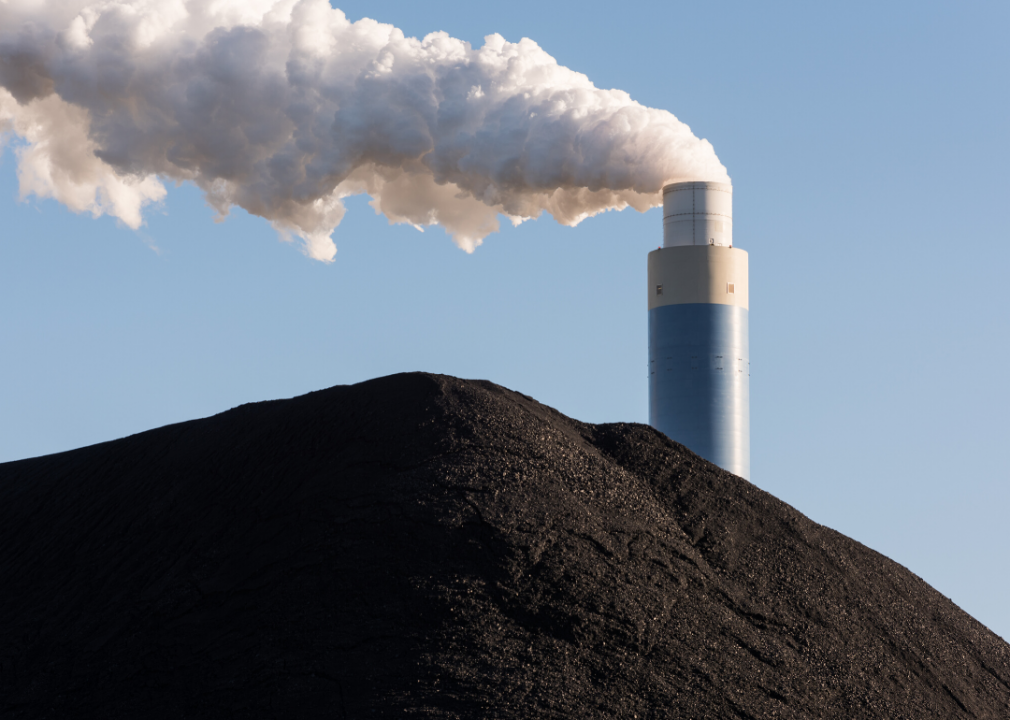
Catstyecam // Shutterstock
#15. British Coal Corp., United Kingdom
- Contribution to atmospheric carbon dioxide rise, 1880–2010: 1.01 ppm (0.98% of total emissions)
- Contribution to global mean surface temperature rise: 0.0077 C (0.96% of total rise, #12 highest contributor)
- Contribution to global sea level rise: 2.12 mm (1.20% of total rise, #8 highest contributor)
Incorporated in 1946 as the National Coal Board, the British Coal Corp. was at one time among the largest coal producers in Western Europe. In 2018, 38.8% of the U.K's electricity came from renewable energy sources, with coal slipping to an all-time low of 1%. However, in a report in The Independent, the U.K. has given a go-ahead to a new deep coal mine that will start coal production by 2022, which is in direct contradiction to the country's commitment to a zero-carbon Britain by 2050.
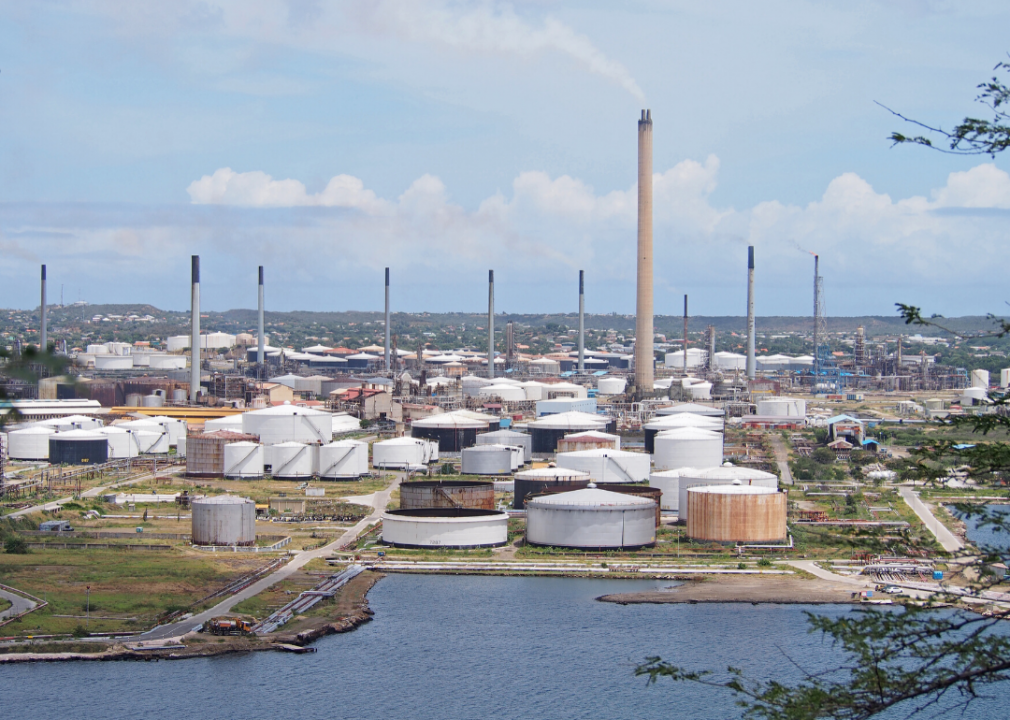
TamasV // Shutterstock
#14. ConocoPhillips, United States
- Contribution to atmospheric carbon dioxide rise, 1880–2010: 1.018 ppm (0.99% of total emissions)
- Contribution to global mean surface temperature rise: 0.0073 C (0.91% of total rise, #14 highest contributor)
- Contribution to global sea level rise: 1.27 mm (0.72% of total rise, #11 highest contributor)
Based in Houston, ConocoPhillips explores and produces crude oil and natural gas. The company has always downplayed the climate change risks, and while publishing a climate risk report and a sustainability report, no clear goals or measurable metrics set by the company to reduce its emissions have been given. The company, while stating that human activities are responsible for GHG emissions on its website, also adds that uncertainties exist.
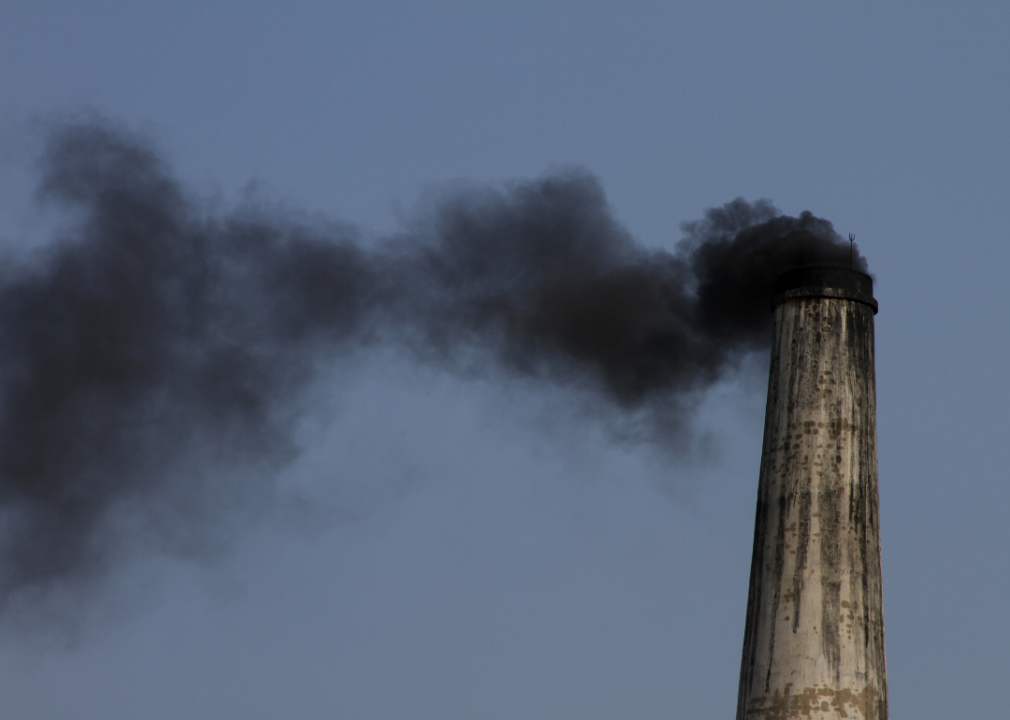
Dennis Albert Richardson // Shutterstock
#13. Coal India Ltd., India
- Contribution to atmospheric carbon dioxide rise, 1880–2010: 1.095 ppm (1.06% of total emissions)
- Contribution to global mean surface temperature rise: 0.007 C (0.87% of total rise, #15 highest contributor)
- Contribution to global sea level rise: 0.58 mm (0.33% of total rise, #19 highest contributor)
Coal India is a state-owned coal mining company in West Bengal. The company is responsible for 82% of coal production in the country. While the country has set ambitious renewable energy targets pushing solar and wind energy, coal remains India's main fuel, generating 75% of the country's electricity.
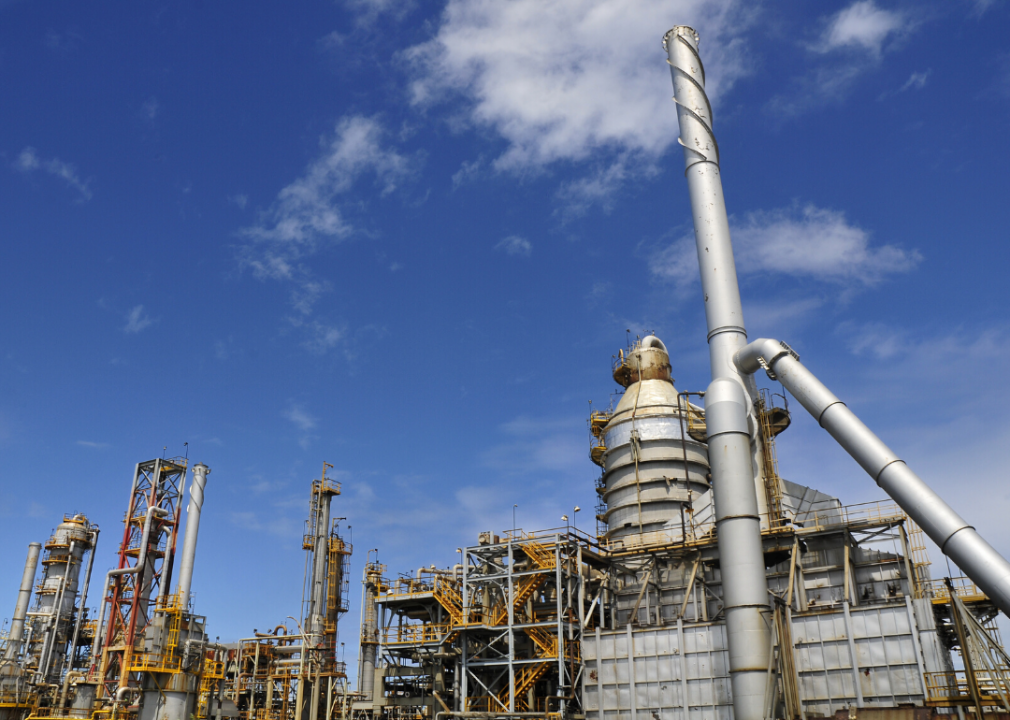
avarand // Shutterstock
#12. Petróleos de Venezuela SA, Venezuela
- Contribution to atmospheric carbon dioxide rise, 1880–2010: 1.107 ppm (1.07% of total emissions)
- Contribution to global mean surface temperature rise: 0.0074 C (0.92% of total rise, #13 highest contributor)
- Contribution to global sea level rise: 0.75 mm (0.42% of total rise, #14 highest contributor)
This Venezuelan state-owned oil and natural gas company is involved in the exploration, production, refining, and exporting of oil and natural gas. With economic and social chaos rising in Venezuela since 2011, the government has not maintained annual and long-term data related to the country's environmental and social indices. Mongabay reports that during COP21, the 2015 climate change conference, Venezuela was one of the few countries that did not submit an Intended Nationally Determined Contribution—a voluntary carbon reduction target submitted to the U.N. by other nations. The country's cloak on data and secrecy is hindering any scientific analysis of carbon emission or mitigation processes.
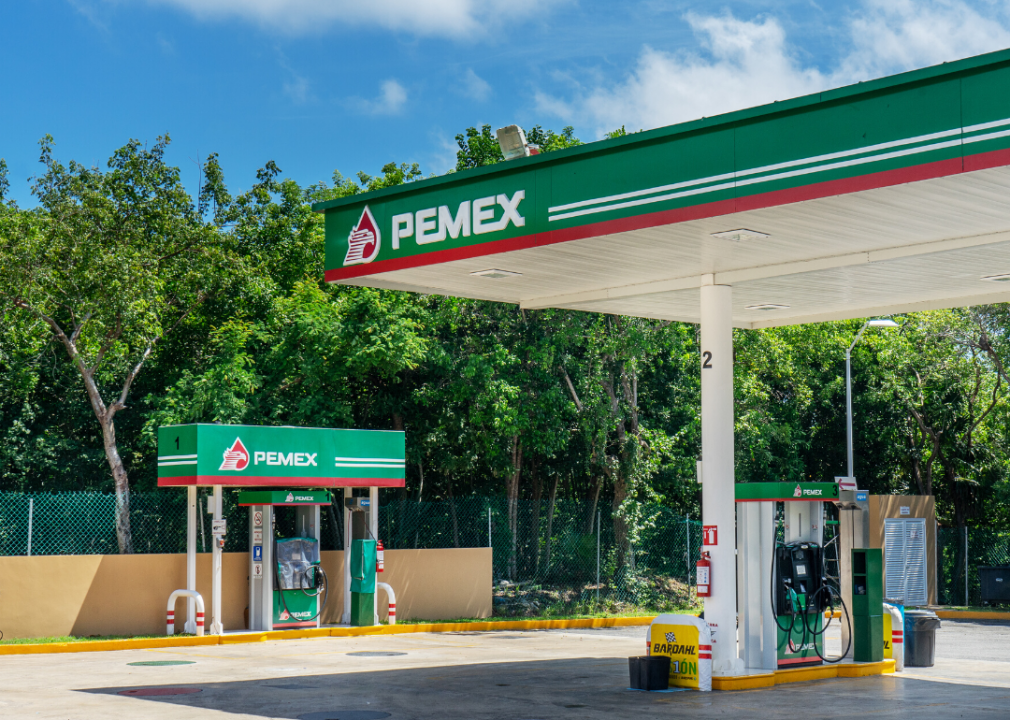
Guajillo studio // Shutterstock
#11. Pemex (Petróleos Mexicanos), Mexico
- Contribution to atmospheric carbon dioxide rise, 1880–2010: 1.353 ppm (1.31% of total emissions)
- Contribution to global mean surface temperature rise: 0.009 C (1.12% of total rise, #11 highest contributor)
- Contribution to global sea level rise: 1 mm (0.56% of total rise, #13 highest contributor)
Pemex is the state-owned petroleum company of Mexico set up in 1983. Mexico made energy reduction commitments of 30% and 35% by 2021 and 2024, respectively. However, the present regime wants to increase the company's daily oil production to 2.5 million barrels from the current 1.6 million barrels, according to Sustain Analytics.
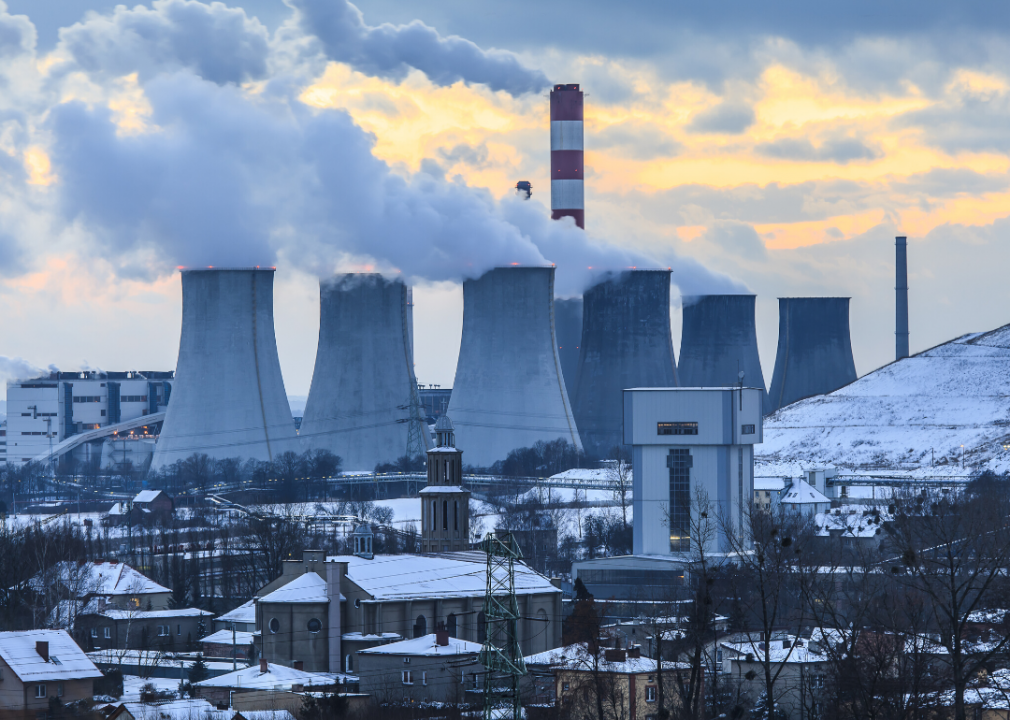
NOWAK LUKASZ // Shutterstock
#10. Poland (government-owned company)
- Contribution to atmospheric carbon dioxide rise, 1880–2010: 1.568 ppm (1.52% of total emissions)
- Contribution to global mean surface temperature rise: 0.0115 C (1.43% of total rise, #10 highest contributor)
- Contribution to global sea level rise: 2.25 mm (1.27% of total rise, #7 highest contributor)
Among the European countries, Poland has the highest domestic coal production, with coal responsible for 80% of its energy needs, and the country has no plan to give it up, says the country's president. Still, climate activism is gaining strength in the country, and according to a 2018 survey by Greenpeace, 69% of Poles supported phasing out coal by 2030. ClientEarth, a charity known to take legal actions against climate offenders, has legally challenged the Bełchatow Power Station in Central Poland, Europe's largest coal plant.
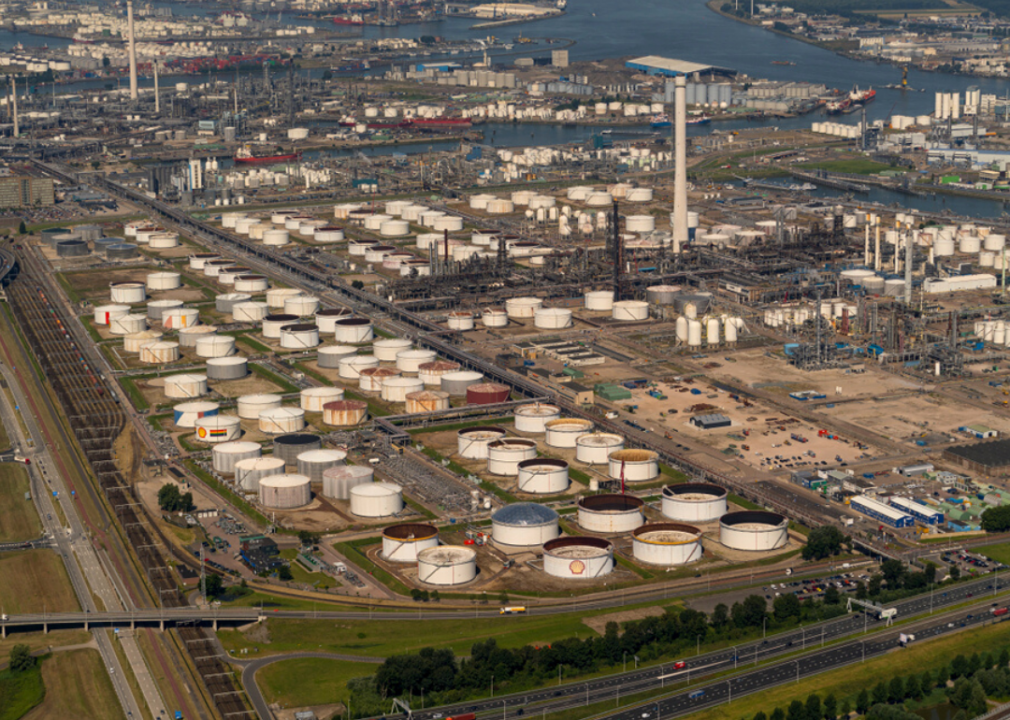
Aerovista Luchtfotografie // Shutterstock
#9. Royal Dutch Shell, PLC, The Netherlands
- Contribution to atmospheric carbon dioxide rise, 1880–2010: 1.85 ppm (1.79% of total emissions)
- Contribution to global mean surface temperature rise: 0.0134 C (1.67% of total rise, #8 highest contributor)
- Contribution to global sea level rise: 2.42 mm (1.37% of total rise, #6 highest contributor)
Royal Dutch Shell, the third-largest company in the world, was incorporated in the United Kingdom and is headquartered in The Netherlands. The company is said to be investing in wind farms, electric car charging, and natural gas alternatives while also planning growth in the fossil fuel sector. The company CEO commented that climate change is not the sole responsibility of oil companies, and it is the entire society that needs to change, adding that oil companies as well as consumers need to take radical steps.
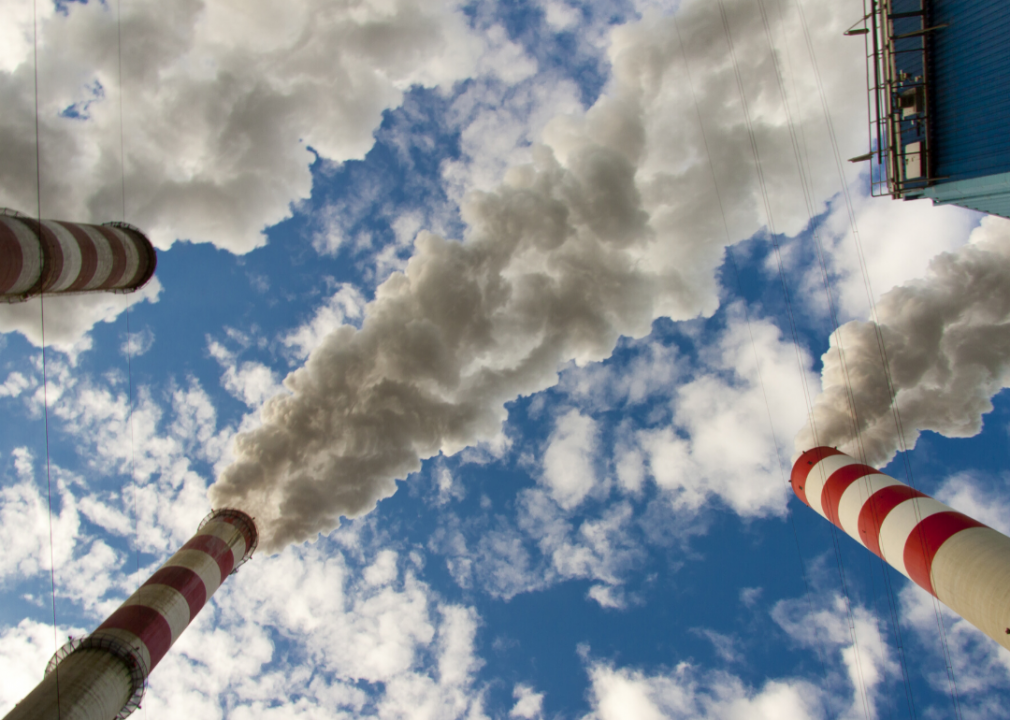
Doin // Shutterstock
#8. National Iranian Oil Co., (NIOC), Iran
- Contribution to atmospheric carbon dioxide rise, 1880–2010: 1.897 ppm (1.84% of total emissions)
- Contribution to global mean surface temperature rise: 0.0128 C (1.59% of total rise, #9 highest contributor)
- Contribution to global sea level rise: 1.74 mm (0.98% of total rise, #10 highest contributor)
NIOC is the world's second-largest oil company and can produce over 4 million barrels of crude oil a day. There is hardly any mention of climate change, emissions, or environmental actions on the company website. Though Iran has signed the Paris Climate Agreement, it has not ratified it.
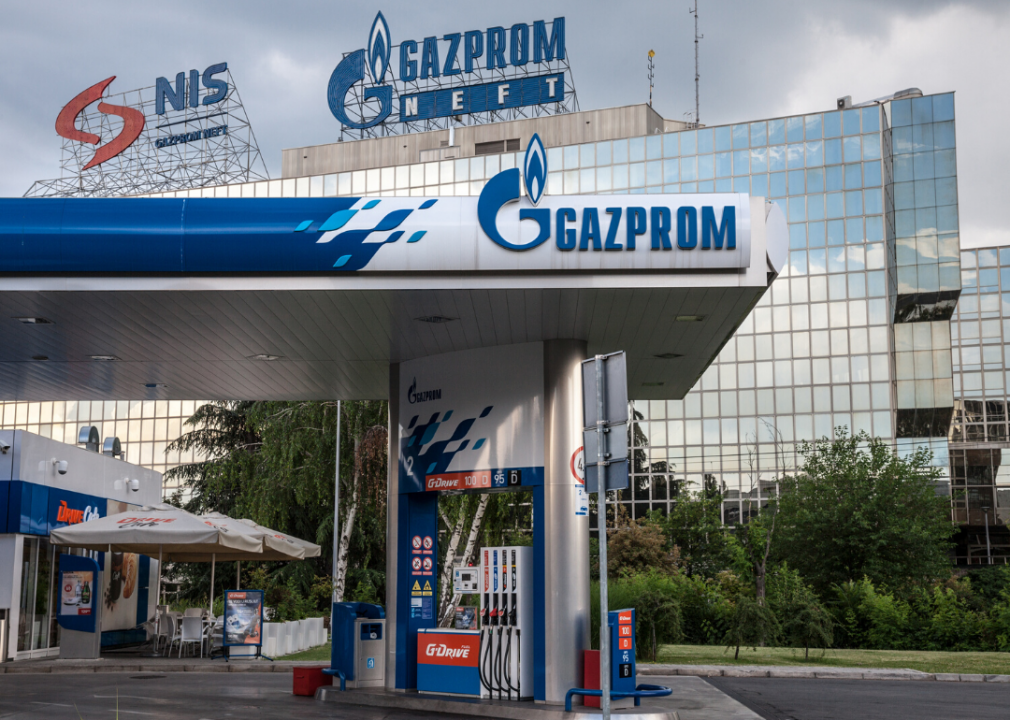
BalkansCat // Shutterstock
#7. Gazprom, Russia
- Contribution to atmospheric carbon dioxide rise, 1880–2010: 2.13 ppm (2.07% of total emissions)
- Contribution to global mean surface temperature rise: 0.017 C (2.12% of total rise, #6 highest contributor)
- Contribution to global sea level rise: 1.14 mm (0.65% of total rise, #12 highest contributor)
As of 2019, Gazprom is the largest natural gas company in the world, headquartered in St. Petersburg, Russia. The company stated in 2019 that every year it took several measures to save energy and improve its energy efficiency—its own GHG emissions falling by 20% since 2014. Climate Home News points out that while Gazprom can provide inexpensive natural gas to Europe, it is doing so at the cost of seizing land from the local tribes at the Yamal Peninsula and spreading serious climatic problems because of gas flaring in the region.
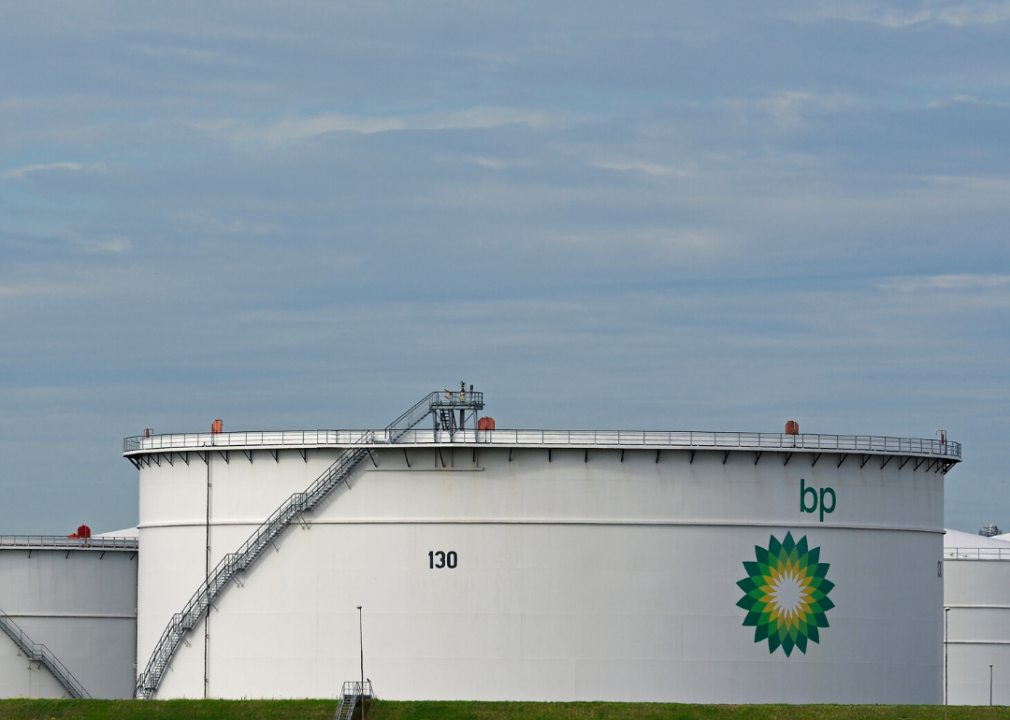
joachim affeldt // Shutterstock
#6. BP, United Kingdom
- Contribution to atmospheric carbon dioxide rise, 1880–2010: 2.161 ppm (2.10% of total emissions)
- Contribution to global mean surface temperature rise: 0.0155 C (1.92% of total rise, #7 highest contributor)
- Contribution to global sea level rise: 2.8 mm (1.58% of total rise, #5 highest contributor)
BP is a 110-year-old company. Its new website states that the company has resolved to reach net-zero by 2050 or sooner. The company also plans to cut its carbon intensity of products by 50% by 2050 or sooner. It has not given too many details on how the change is to come, but it seems with growing pressure from the people and investors, one of the major oil giants of the world is trying to change its ways.
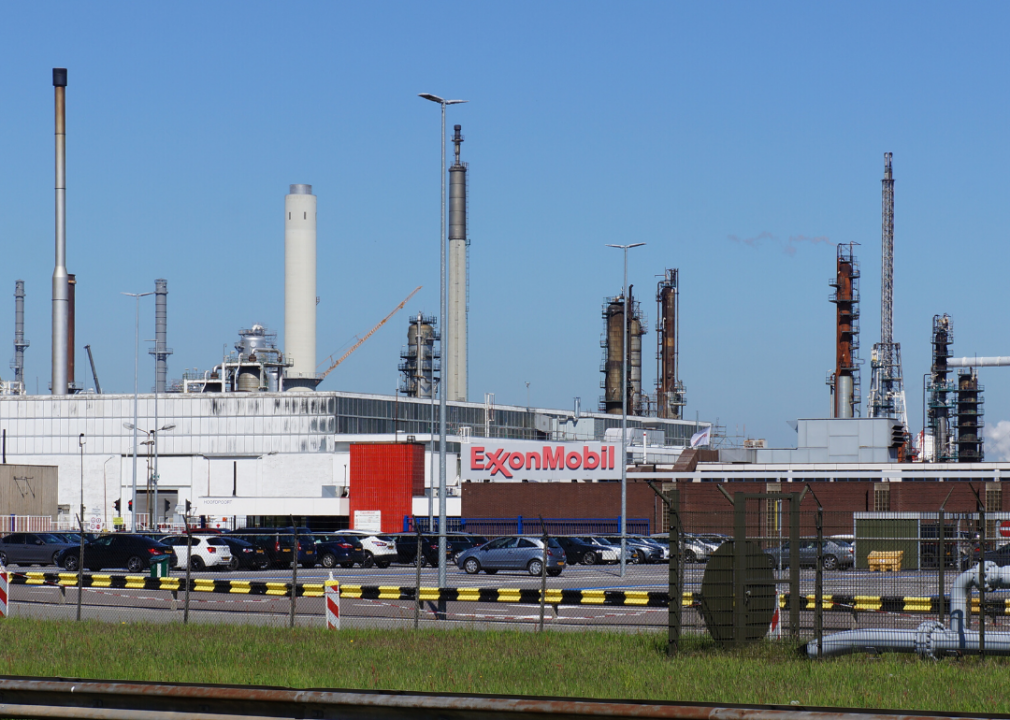
Dafinchi // Shutterstock
#5. ExxonMobil Corp., USA
- Contribution to atmospheric carbon dioxide rise, 1880–2010: 2.747 ppm (2.66% of total emissions)
- Contribution to global mean surface temperature rise: 0.0201 C (2.50% of total rise, #5 highest contributor)
- Contribution to global sea level rise: 3.87 mm (2.19% of total rise, #4 highest contributor)
ExxonMobil publicly acknowledged the risk of climate change for the first time in 2014. The company says it has invested $10 billion since 2000 to develop low-emission energy solutions. The company has been in a legal battle for its deliberate misinformation campaigns and has also alleged that ExxonMobil spent $41 million a year lobbying to block climate change policies.
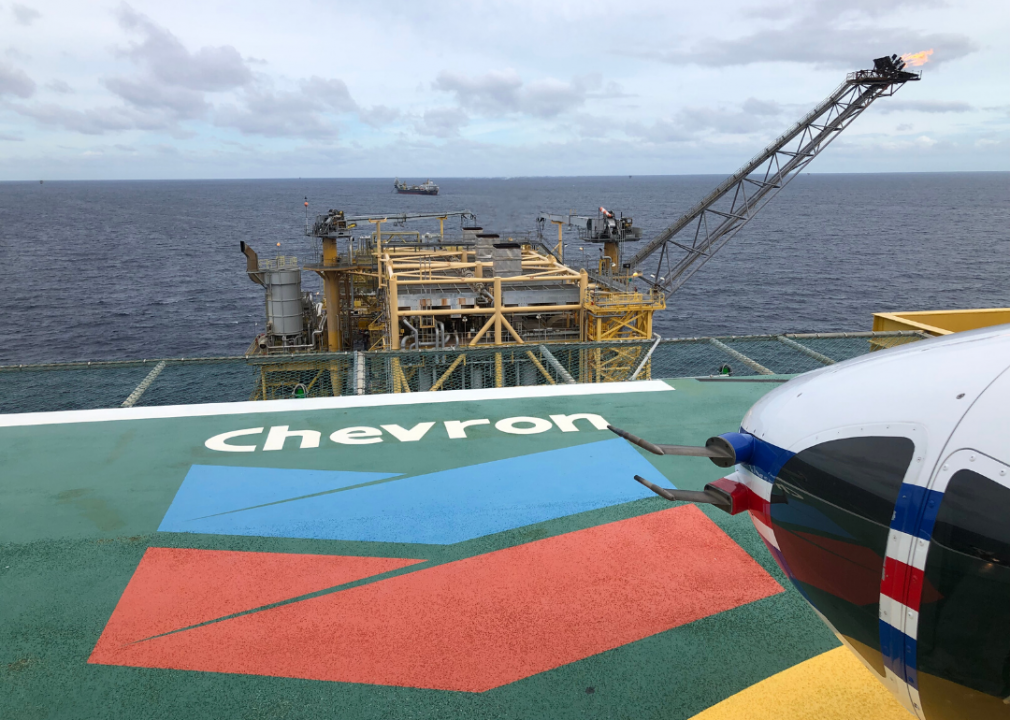
impromptuwitz // Shutterstock
#4. Chevron Corp., United States
- Contribution to atmospheric carbon dioxide rise, 1880–2010: 2.932 ppm (2.84% of total emissions)
- Contribution to global mean surface temperature rise: 0.0215 C (2.68% of total rise, #3 highest contributor)
- Contribution to global sea level rise: 4.57 mm (2.58% of total rise, #3 highest contributor)
Chevron was born from the parent company, Standard Oil. On its website, the company points out that it is not the responsibility of developed countries alone to tackle issues related to climate change as GHG emissions do not recognize sovereign borders. For years the company has been denying or downplaying the effects of climate change, and after BP pledged to be zero carbon, all eyes are on Chevron and ExxonMobil to follow suit.
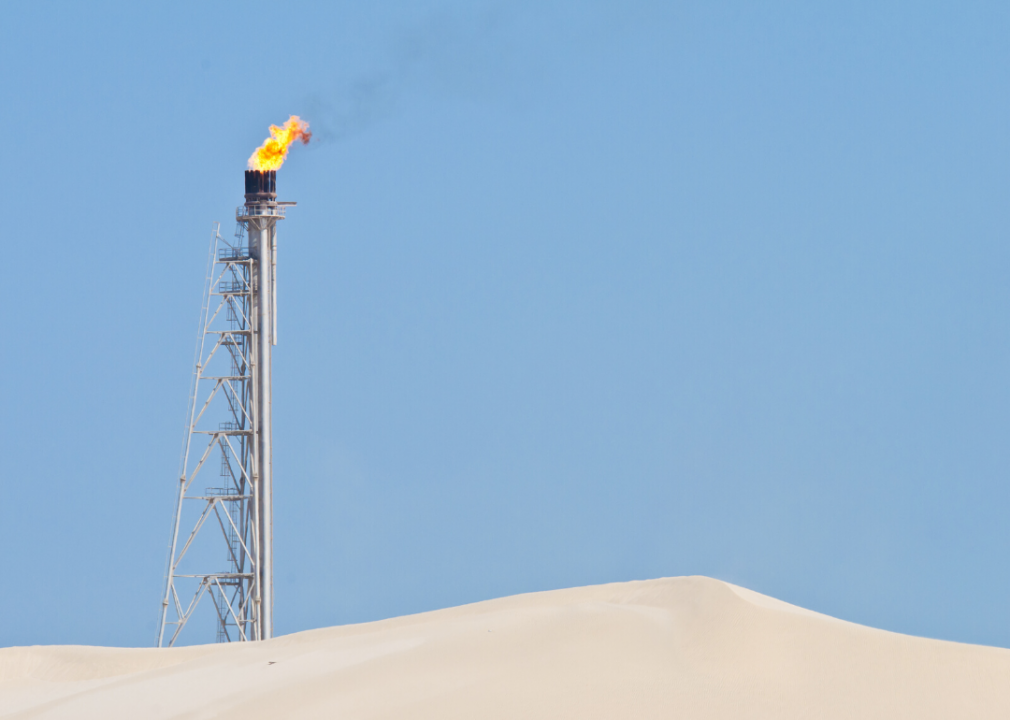
Nico Traut // Shutterstock
#3. Saudi Aramco, Saudi Arabia
- Contribution to atmospheric carbon dioxide rise, 1880–2010: 3.191 ppm (3.10% of total emissions)
- Contribution to global mean surface temperature rise: 0.0205 C (2.55% of total rise, #4 highest contributor)
- Contribution to global sea level rise: 2.12 mm (1.20% of total rise, #8 highest contributor)
The Saudi Arabian Oil Co. is the greatest emitter of GHG in the fossil fuel sector and says that oil and gas will remain key in the energy sector as there are few alternatives available that can sustain the demands. Aramco points to certain climate initiatives it has planned such as creating nature sinks to absorb CO2, developing emission-reducing technologies, converting captured carbon to useful products, and collaborating with institutions that are working to reduce the impact of climate change. It also takes pride in the fact that, according to a 2017 study, Saudi Arabian crude oil has the lowest carbon intensity.
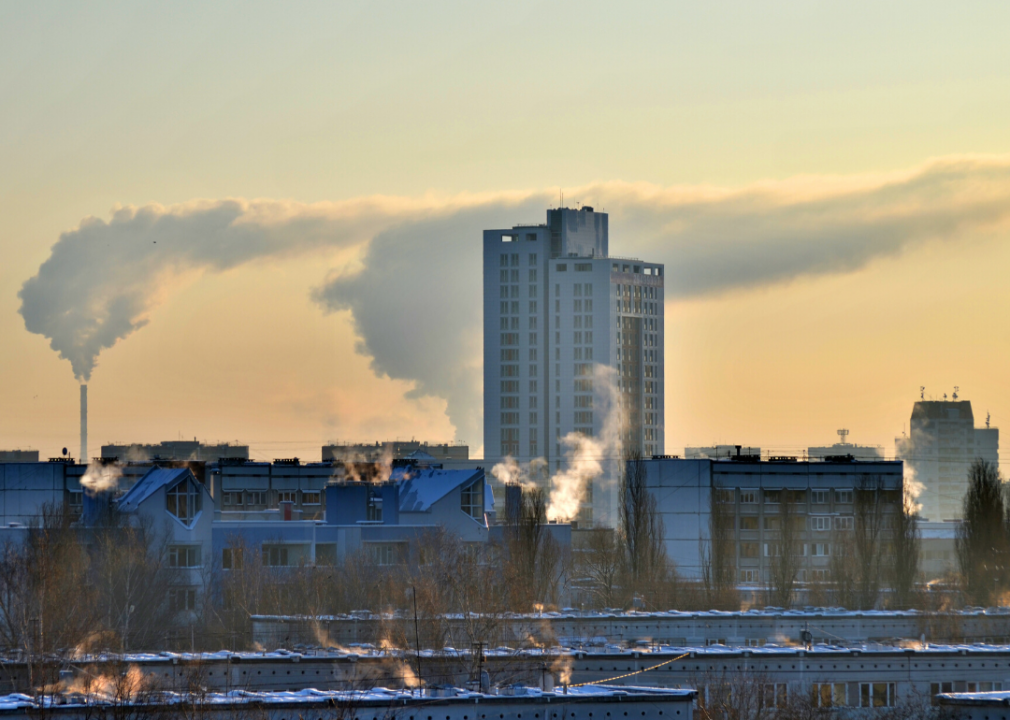
Ikars // Shutterstock
#2. Former Soviet Union (government-owned company)
- Contribution to atmospheric carbon dioxide rise, 1880–2010: 7.053 ppm (6.84% of total emissions)
- Contribution to global mean surface temperature rise: 0.0538 C (6.70% of total rise, #1 highest contributor)
- Contribution to global sea level rise: 12.47 mm (7.04% of total rise, #1 highest contributor)
The Former Soviet Union is comprised of the 15 states that emerged from the breakup of the Union of Soviet Socialist Republics (USSR) in 1991. The GHG emissions of the countries went down with economic turmoil, and a Nature study finds that the downturn also was due to a drop in emissions when food production declined as people's diets changed to non-meat products and their diminishing spending capacities. According to the study, between 1992 and 2011, there was a net reduction in carbon dioxide equivalent emissions of 7.6 million metric tons. Another study reports that the emission decline may see a rebound as the food system evolves in these countries.
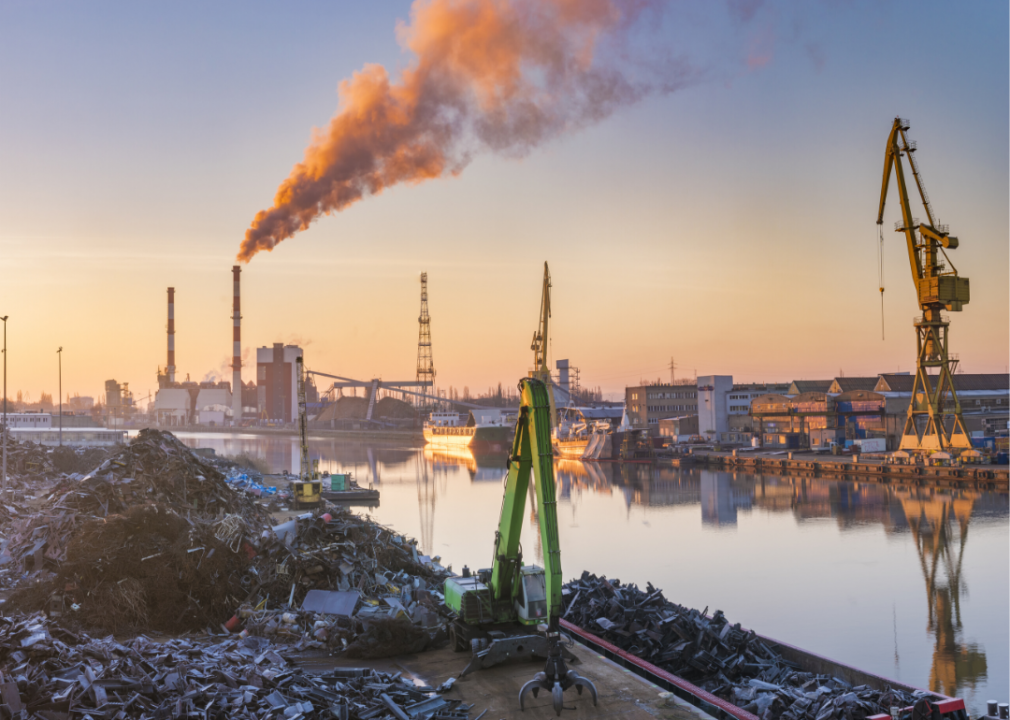
Mike Mareen // Shutterstock
#1. People's Republic of China (coal and cement only) (government-owned company)
- Contribution to atmospheric carbon dioxide rise, 1880–2010: 8.683 ppm (8.42% of total emissions)
- Contribution to global mean surface temperature rise: 0.053 C (6.60% of total rise, #2 highest contributor)
- Contribution to global sea level rise: 5.43 mm (3.07% of total rise, #2 highest contributor)
China's carbon emission has nearly tripled to 30% between 2000 and 2018; it has more coal-powered plants than the rest of the world combined; and even as world leaders gathered in Spain to discuss how best to tackle a warming planet in December 2019, coal consumption in China was at peak level. Chinese industries also are involved in at least 240 coal projects in other countries with no signs of controlling climate change. "Between 2011 and 2013, more cement was consumed in China than the entire United States in the span of the entire 20th century," writes ChinaPower. Conversely, China is investing heavily in solar panels, wind turbines, and electric vehicles to help reduce emissions, but the question remains—has it done enough?
